
Makeshift Metropolis: Ideas About Cities
by
Witold Rybczynski
Published 9 Nov 2010
Nathan Glazer, “Why City Planning Is Obsolete,” Architectural Forum, July 1958, 96. 11. Ibid., 97. 12. Ibid., 98. 13. Epstein had recently joined Random House after founding Anchor Books, where he had published The Exploding Metropolis. 14. Jane Jacobs, The Death and Life of Great American Cities (New York: Random House, 1961), 3. 15. Ibid., 25. 16. Ibid., 19. 17. Ibid., 23. 18. Ibid., 87–88. 19. Ibid., 372. 20. Lloyd Rodwin, review of The Death and Life of Great American Cities, New York Times Book Review, November 5, 1961. 21. Jacobs, Death and Life, 20. 22. Mumford, “Home Remedies,” 196. 23. Ibid., 194. 24. Ibid., 197. 25. Ibid., 191 26. Ibid., 197. 27.
…
He had witnessed the creation of modern architecture and planning, which gave him an almost mythic aura. A courtly gentleman, he was formal and somewhat distant, a figure from another age. Jacobs, iconoclastic, feisty, and outspoken, was much more appealing to an impressionable tyro. A half century has passed since Jacobs wrote The Death and Life of Great American Cities, and the years have tempered my unseasoned judgments. Her offhanded dismissal of the City Beautiful and the Garden City, for example, now seems a little too easy; both movements left an indelible —and positive—imprint on American cities. Her perceptive analysis of street life is circumscribed by what we have since learned about defensible space and community policing.
…
Anticipating the historic preservation movement, Glazer also called for saving old buildings and old neighborhoods. When Jacobs was approached by the Rockefeller Foundation with an offer of a grant if she would expand her Fortune essay into a book, Glazer introduced her to Jason Epstein at Random House.13 The result was The Death and Life of Great American Cities. The book elaborated on the various themes Jacobs had broached in her Fortune essay, her Harvard talk, and her Architectural Forum articles. She used examples chiefly from Greenwich Village (where she lived) and also described older city neighborhoods such as Back-of-the-Yards in Chicago and the North End in Boston, as well as developments she had visited in Philadelphia, Pittsburgh, and Baltimore.
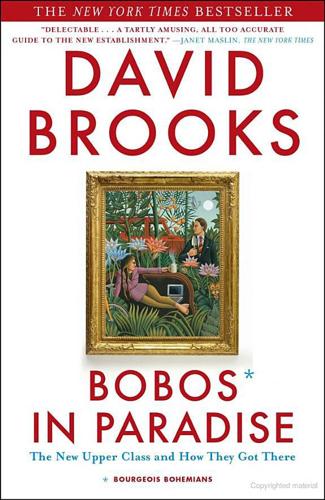
Bobos in Paradise: The New Upper Class and How They Got There
by
David Brooks
Published 1 Jan 2000
It must have diversity. The word diversity, which has become one of the key words of our age, was central in The Death and Life of Great American Cities. The entire second section of the book is called “The Conditions for City Diversity.” It is complexity she admires, the small unplanned niches where specialized activities can thrive. These are places whose use is not determined from above but grows up from small particularized needs. In the years since The Death and Life of Great American Cities was published, Jacobs’s way of seeing has been vindicated again and again. The urban plans she criticized are now universally reviled.
…
That’s because the fifties were the final decade of the industrial age, and the contrast between the upscale culture of that time and the upscale culture of today is stark and illuminating. Furthermore, I found that many of the books that really helped me understand the current educated class were written between 1955 and 1965, when the explosion in college enrollments, so crucial to many of these trends, was just beginning. Books like The Organization Man, The Death and Life of Great American Cities, The Affluent Society, The Status Seekers, and The Protestant Establishment were the first expressions of the new educated class ethos, and while the fever and froth of the 1960s have largely burned away, the ideas of these 1950s intellectuals continue to resonate. Finally, a word about the tone of this book.
…
It simply means that it would take a more down-to-earth writer to provide a more practical way of rethinking organizations and social structures. Jane Jacobs, Proto-Bobo In fact, when Roszak was writing, the seeds of that rethinking had already been planted. In 1961 Jane Jacobs published The Death and Life of Great American Cities, which remains the most influential book on how Bobos view organizations and social structures. Jane Jacobs was born in Scranton, Pennsylvania, in 1916, the daughter of a doctor and a teacher. After high school she went to work as a reporter for the Scranton Tribune. She lasted a year, then ventured to New York and worked in a series of jobs as a stenographer and freelance writer before landing a junior editorial position at Architectural Forum.
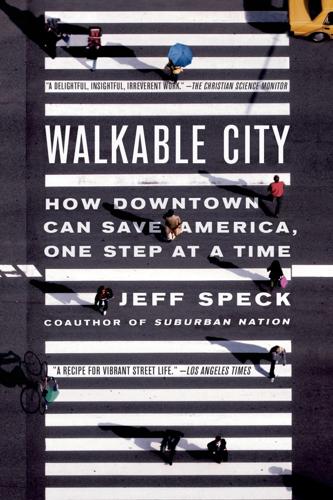
Walkable City: How Downtown Can Save America, One Step at a Time
by
Jeff Speck
Published 13 Nov 2012
Until they do, it will be necessary for mayors, Main Street merchants, and concerned citizens to discredit them. Toward that end, I provide the following short interlude. KILL THE TRAFFIC ENGINEERS FIRST Everybody likes Jane Jacobs, right? She was famous for fighting traffic engineers, and took them to task repeatedly and effectively in her masterpiece, The Death and Life of Great American Cities. Most planners and many public servants swear by that book, but few have read Dark Age Ahead, in which, forty years later, she took off the gloves. Until traffic engineers change their tune on induced demand, here is the statement from Jane Jacobs that every public official and planner needs to tape prominently above his or her desk: It is popularly assumed that when universities give science degrees in traffic engineering, as they do, they are recognizing aboveboard expert knowledge.
…
David Byrne, Bicycle Diaries, 278. 53. Lord. STEP 7: SHAPE THE SPACES 1. Thomas J. Campanella, Republic of Shade, 135. 2. Jan Gehl, Cities for People, 4. 3. Ibid., 120, 139, 34. 4. Ibid., 50. 5. Christopher Alexander, A Pattern Language, 115. 6. Gehl, 42. 7. Ibid., 171–73. 8. Jane Jacobs, The Death and Life of Great American Cities, 203. 9. Andres Duany and Jeff Speck, The Smart Growth Manual, Point 10.5. 10. Gehl, 146. STEP 8: PLANT TREES 1. R. S. Ulrich et al., “View Through a Window May Influence Recovery from Surgery.” 2. “The Value of Trees to a Community,” arborday.org/trees/benefits.cfm. 3. Dan Burden, “22 Benefits of Urban Street Trees.” 4.
…
Chris Turner, “What Makes a Building Ugly?” 7. James Fallows, “Fifty-Nine and a Half Minutes of Brilliance, Thirty Seconds of Hauteur.” 8. Ethan Kent, “Guggenheim Museum Bilbao,” Project for Public Spaces Hall of Shame. 9. Léon Krier, The Architecture of Community, 70. 10. Jane Jacobs, The Death and Life of Great American Cities, 291. 11. David Owen, Green Metropolis, 178. 12. Ibid., 181. 13. Jacobs, 91. 14. Ibid., 91n. STEP 10: PICK YOUR WINNERS 1. Andres Duany, Elizabeth Plater-Zyberk, and Jeff Speck, Suburban Nation, 166. 2. Blair Kamin, “Ohio Cap at Forefront of Urban Design Trend.” 3. Andres Duany and Jeff Speck, The Smart Growth Manual, Point 7.8. 4.
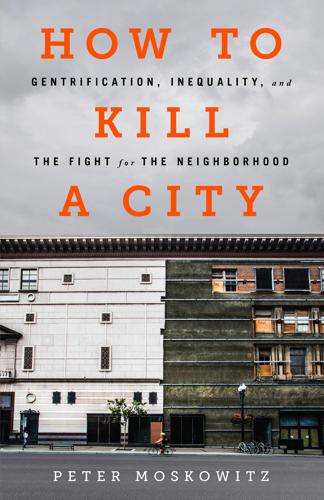
How to Kill a City: The Real Story of Gentrification
by
Peter Moskowitz
Published 7 Mar 2017
Classification: LCC HT175 .M67 2017 (print) | LCC HT175 (ebook) | DDC 307.3/362—dc23 LC record available at https://lccn.loc.gov/2016042410 E3-20170206-JV-PC Contents Cover Title Page Copyright Dedication Introduction PART 1: NEW ORLEANS Chapter 1: Hanging On Chapter 2: How Gentrification Works Chapter 3: Destroy to Rebuild PART 2: DETROIT Chapter 4: The New Detroit Chapter 5: The 7.2 Chapter 6: How the Slate Got Blank PART 3: SAN FRANCISCO Chapter 7: The Gentrified City Chapter 8: Growth Machine Chapter 9: The New Geography of Inequality PART 4: NEW YORK Chapter 10: An Elegy Chapter 11: New York Is Not Meant for People Chapter 12: Fight Back Conclusion: Toward an Un-Gentrified Future Acknowledgments About the Author Notes Index To Bubbe, who introduced me to New York Introduction When I returned to New York from college, I found myself belonging to two groups of people: the gentrified and the gentrifiers. I’d grown up in the West Village, just a few blocks from where journalist and activist Jane Jacobs wrote her pro-urban treatise The Death and Life of Great American Cities in 1961. Jacobs’s book was a 400-page meditation on what made the Village great—its small, varied streetscapes; its diversity of profession, class, and race; its inherent eclecticism. Jacobs argued that every other city in the United States should try to emulate its success by encouraging the creation of small shops over big ones, small streets over grand avenues, and varying sizes of apartment buildings and town houses over huge complexes.
…
Whether or not gentrifiers, policy makers, and others with power and money can grapple with both narratives—the one about discovery and betterment, and the more complicated, uncomfortable one about loss, about economics and race—will determine the future of our cities. As Jane Jacobs wrote in The Death and Life of Great American Cities, “Private investment shapes cities, but social ideas (and laws) shape private investment. First comes the image of what we want, then the machinery is adapted to turn out that image.” So what image of our cities do we hold in our hearts? Part 2 Detroit 4 The New Detroit On an early summer day in 2015, Detroit Bikes, one of at least four high-end bicycle manufacturers in Detroit, opened its first retail shop downtown.
…
Back then, this wasn’t many people’s idea of a good place to live, and so my parents got it cheap: $90,000, some $170,000 under the asking price. It’s hard to not sound nostalgic when talking about growing up in the West Village. My childhood home was just a few blocks from where Jane Jacobs wrote The Death and Life of Great American Cities. And even though I was born years after that book was published, its lessons felt applicable—I could have been a character in Jacobs’s book. Jacobs wrote about how sidewalk life provides many of the things people in suburbs have to pay for—namely, safety and community—and that’s what the Village provided me.

Cities Are Good for You: The Genius of the Metropolis
by
Leo Hollis
Published 31 Mar 2013
Jane Jacobs was one of the first people to connect the ideas of complexity and the city. She was not an academic, nor an architect, planner or public official; however, her insights into how the city worked, her almost instinctive belief in the complexity of the streets, had far-reaching effects on how cities are made today. In her most famous work, The Death and Life of Great American Cities, she set out her rallying cry for complex spaces: Under the seeming disorder of the old city, wherever the old city is working successfully, is a marvellous order for maintaining the safety of the streets and the freedom of the city. It is a complex order … This order is all composed of movement and change, and although it is life, not art, we may fancifully call it the art of the city and liken it to the dance.7 Jacobs called this dance the Ballet of Hudson Street, after her own corner of Greenwich Village.
…
There he photographed many of the women he met and then attached large-format portraits of their eyes to the outside of the slum’s buildings, giving the eerie impression of the favela itself looking out over the rest of the city. For JR, this project was a reminder of the role of women at the heart of the community yet it was also a graphic manifestation of how life on the streets itself cannot be ignored. Morro da Providencia, Rio de Janeiro, decorated by JR’s murals In The Death and Life of Great American Cities, Jacobs shows how the street develops its own equilibrium, which she calls ‘the eyes on the street’: ‘an intricate, almost unconscious, network of voluntary controls and standards among the people themselves, and enforced by the people themselves’.6 On Jacobs’s street these include the shopkeepers, the old woman who sometimes sits on the stoop on a warm evening and the regulars at the White Horse Bar.
…
Some of that clutter and chaos made its way into the Jacobs’s flat that friends remember as deeply untidy but with a huge amount of personality. It was here that Jacobs began to observe the Ballet of Hudson Street and came to understand the complex patterns of the neighbourhood that she later described in The Death and Life of Great American Cities. By the late 1950s she was also working at Architectural Forum magazine, where she met William H. Whyte who shared her concerns about the dangers of city planning. While architects were in thrall to the grand projects, they both asked, where were the people? In a groundbreaking collection of essays, The Exploding Metropolis, both Whyte and Jacobs expanded on their ideas.
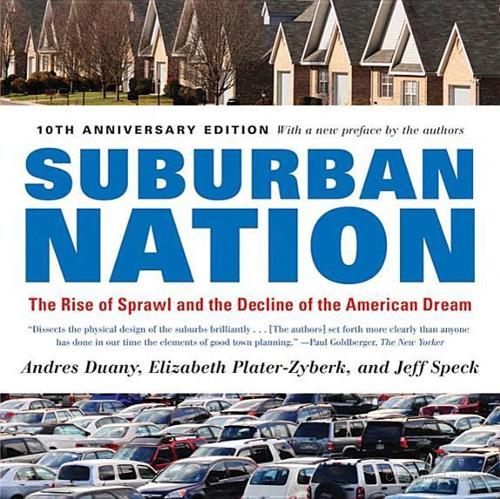
Suburban Nation
by
Andres Duany
,
Elizabeth Plater-Zyberk
and
Jeff Speck
Published 14 Sep 2010
THE PHYSICAL CREATION OF SOCIETY 1 “Parking Lot Pique,” A26. 2 Jonathan Franzen, “First City,” 91. 3 Jonathan Rose, “Violence, Materialism, and Ritual,” 145. 4 Le Corbusier, The City of Tomorrow and Its Planning, 129. 5 Jane Jacobs, The Death and Life of Great American Cities, 129. 5. THE AMERICAN TRANSPORTATION MESS 1 Jane Jacobs, The Death and Life of Great American Cities, 183. 2 Donald D.T. Chen, “If You Build It, They Will Come,” 4. 3 Ibid., 6. 4 Stanley Hart and Alvin Spivak, The Elephant in the Bedroom, 122. 5 Jane Holtz Kay, Asphalt Nation, 129. 6 Hart and Spivak, The Elephant in the Bedroom, 111; James Howard Kunstler, Home from Nowhere, 67, 99. 7 Hart and Spivak, The Elephant in the Bedroom, 166. 6.
…
With new towns to design that could outlast centuries, why spend an inordinate number of hours on a text that might have a shelf life of only a few years? I was aware of the tension between a book focused on a present problem and one of lasting relevance, and I argued strongly that our book should be the latter. In this regard, Jane Jacobs’s half-century-old The Death and Life of Great American Cities was my model—a difficult one to live up to, granted, but the pursuit of unattainable ideals is stimulating. And so I undertook the editing with an eye to issues that were of the more transcendental sort. To this end, the grand subject of urbanism certainly provided a good foundation.
…
This would be an important first step toward creating public spaces worthy of habitation. 3 THE HOUSE THAT SPRAWL BUILT THE ODDITY OF AMERICAN HOUSING; PRIVATE REALM VERSUS PUBLIC REALM; THE SEGREGATION OF SOCIETY BY INCOME; TWO ILLEGAL TYPES OF AFFORDABLE HOUSING; TWO FORGOTTEN RULES OF AFFORDABLE HOUSING; THE MIDDLE-CLASS HOUSING CRISIS Does anyone suppose that, in real life, answers to any of the great questions that worry us today are going to come out of homogeneous settlements? —JANE JACOBS, THE DEATH AND LIFE OF GREAT AMERICAN CITIES (1961) THE ODDITY OF AMERICAN HOUSING Sprawl is made up mostly of housing. Its ubiquity alone makes it an important subject to study, but there are other reasons to consider the way America provides housing. While the current suburban model may seem natural enough to most Americans, it appears quite odd when viewed in a global context.

Ground Control: Fear and Happiness in the Twenty First Century City
by
Anna Minton
Published 24 Jun 2009
In Britain, in planning and urban-design circles this is the subject of raging debate, which echoes the uncertainty about whether or not gated communities are safer – American research described later in the chapter finds that they make little difference to crime and may actually increase it. At the centre of the debate about ‘defensible space’ is the question of whether ‘natural surveillance’, which deters crime, is created by the ‘eyes on the street’ of strangers, as argued by Jane Jacobs in her seminal book, The Death and Life of Great American Cities, 18 or whether strangers should be seen as dangerous intruders, as Newman believes. Both sides of the argument command influential support. Research from University College London shows that ‘defensible space’ does not create safer environments, finding that residents of cul de sacs were more likely to be burgled because their isolation means they are targets.19 Now, bolstered by the growing weight of evidence, even the government has acknowledged the need for change, suggesting in its recent Manual for Streets that developers return to the type of street pattern that has characterized the city over centuries.20 But no one expects developers to listen because in the other corner is Secured by Design, the influential police-backed design initiative based on Newman’s ‘defensible space’ ideas.
…
Creating such a segregated environment is entrenching this fear of difference and fear of strangers. STRANGER DANGER OR ‘EYES ON THE STREET’? Whether strangers are dangerous or essential to healthy city life is the question which has been at the heart of debates about cities for the last fifty years. Jane Jacobs’ classic text, The Death and Life of Great American Cities, published in 1961, 23 and Richard Sennett’s The Fall of Public Man, which came out in 1977, argue that the presence of strangers in cities is the essence of civility and safety. Sennett describes the city as the place ‘where strangers are most likely to meet’ and defines ‘civility’ as ‘treating others as strangers and forging a social bond on that distance’.24 Jacobs bases her case on ‘natural surveillance’, which is built around the informal social controls of strangers.
…
Hillier, Bill, The Common Language of Space: A Way of Looking at the Social, Economic and Environmental Functioning of Cities on a Common Basis, Space Syntax Laboratory, Bartlett School of Graduate Studies, University College London, 1998 16. Design Guide for Residential Areas, Essex County Council, 1973 17. Quoted in Colquhoun, Ian, Design Out Crime: Creating Safe and Sustainable Communities, Architectural Press, 2004 18. Jacobs, Jane, The Death and Life of Great American Cities, Random House, 1961 19. Hillier, The Common Language of Space 20. Manual for Streets, Department for Transport, 2007 21. Burney, Elizabeth, Crime and Banishment: Nuisance and Exclusion in Social Housing, Waterside Press, 1999 22. Securing the Nation: The Case for Safer Homes, Association of British Insurers, 2006 23.
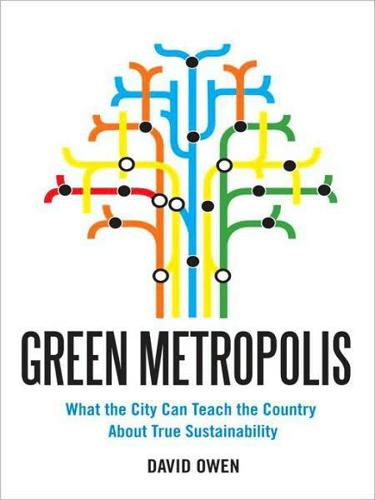
Green Metropolis: Why Living Smaller, Living Closer, and Driving Less Are Thekeys to Sustainability
by
David Owen
Published 16 Sep 2009
Phoenix’s horizontal growth has, if anything, accelerated since then. 34 Jane Jacobs, The Death and Life of Great American Cities (New York: Vintage Books, 1992; originally published 1961), p. 352. 35 M. A. Farber, “Negotiations with Post Keep Kheel in Limelight,” The New York Times, February 20, 1988. 36 Stanley Levey, “Autos Aggravate Transit Problem; Kheel Seeks Cure,” The New York Times, May 31, 1955. 37 Richard Oliver, “Kheel Proposes Tolls on Major Highways,” New York Daily News, October 10, 1969. 38 Jacobs, The Death and Life of Great American Cities, pp. 338ff. 39 Ian Urbina, “F.D.R. Drive Taking Its Act to the River, for Three Years,” The New York Times, May 18, 2004. 40 Robert Cervero, The Transit Metropolis: A Global Inquiry (Washington, D.C., 1998), p. 22. 41 Ariel Hart, “HOV Lane Fees Could Start by 2010,” Atlanta Journal-Constitution , March 20, 2008. 42 Tom Vanderbilt, Traffic: Why We Drive the Way We Do (and What It Says About Us) (New York: Alfred A.
…
Many more acres of upstate pastoral paradise were destroyed by the steady spread of towns like hers than by the creation of the water supply system that makes it possible for New York City to exist. Building the city didn’t fill the Hudson Valley with parking lots; fleeing the city did. THE SIGNIFICANCE OF POPULATION DENSITY WAS ELUCIDATED brilliantly in 1961 in a landmark book called The Death and Life of Great American Cities, by Jane Jacobs.35 Jacobs upended many widely held ideas about how cities ought to be put together, and she has been celebrated ever since as an urban-planning iconoclast and visionary, but she could be viewed just as easily as a pioneering environmentalist. Indeed, Jacobs’s book may be most valuable today as a guide to reducing the ecological damage caused by human beings, even though it scarcely mentions the environment, other than by making a couple of passing references to smog.
…
There isn’t much, even if you include people who are jogging for exercise. People traveling to a destination are far less likely to walk across a park or any other large open space than they are to walk the same distance along a lively city street. Jane Jacobs discusses this trick of perception in The Death and Life of Great American Cities, in a chapter she called “The Curse of Border Vacuums.” She defines a border as “the perimeter of a single massive or stretched-out use of territory” and cites, as the classic example, railroad tracks, whose division of urban areas into isolated, noninteracting regions is so well-understood as to be a cliché: “the wrong side of the tracks.”
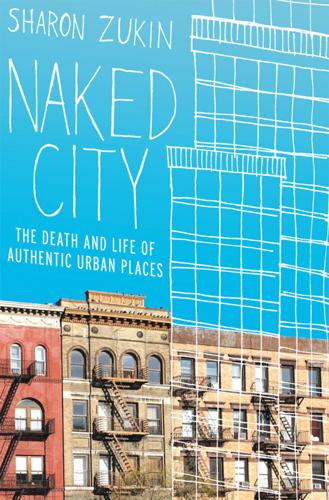
Naked City: The Death and Life of Authentic Urban Places
by
Sharon Zukin
Published 1 Dec 2009
She praised crowded sidewalks for keeping people safe, shabby buildings with low rents for incubating small new businesses, and mixed uses—housing alongside stores, offices, and manufacturing—for exerting greater aesthetic appeal than the “dullness” that was so palpable in homogeneous corporate office districts, public housing projects, and residential suburbs. The much-quoted set piece in the first section of Jacobs’s best-selling 1961 book, The Death and Life of Great American Cities—an hour-by-hour description of the “intricate sidewalk ballet” on Hudson Street, outside her window—dramatizes the neighborly interdependence of local shopkeepers, housewives, schoolchildren, and customers at the corner bar, all patron saints of social order in the city’s neighborhoods who were either scorned or ignored by the powerful forces that controlled urban renewal.
…
Would they stick by the most depressed and derelict expanses of Brooklyn, or the cracked-out squats around Tompkins Square Park, or the blocks of boarded-up windows in Harlem? That New York was not authentic or quaint; it was miserable and dangerous. —Justin Davidson, New York magazine, September 7, 2008 When Jane Jacobs wrote The Death and Life of Great American Cities in 1960, death was all too evident around her. New York City’s port was shutting down, factories and neighborhoods hadn’t altered their look since the beginning of the century, and middle-class families were fleeing from declining public services and expanding dark ghettos to the suburbs.
…
Caro, The Power Broker: Robert Moses and the Fall of New York (New York: Vintage, 1974); Samuel Zipp, “Manhattan Projects: Cold War Urbanism in the Age of Urban Renewal (New York),” PhD dissertation, Yale University, 2006. 12. Herbert J. Gans, The Urban Villagers (New York: Free Press, 1962); Jane Jacobs, The Death and Life of Great American Cities (New York: Random House, 1961). 13. Suleiman Osman, “The Birth of Postmodern New York: Gentrification, Postindustrialization and Race in South Brooklyn, 1950–1980,” PhD dissertation, Harvard University, 2006; Walter Firey, “Sentiment and Symbolism as Ecological Variables,” American Sociological Review 10 (1945): 140–48.

Age of the City: Why Our Future Will Be Won or Lost Together
by
Ian Goldin
and
Tom Lee-Devlin
Published 21 Jun 2023
Ed Glaeser’s Triumph of the City, Richard Florida’s The Rise of the Creative Class, Enrico Moretti’s The New Geography of Jobs and many other excellent books over recent years have laid a trail before us, as have canonical works such as Lewis Mumford’s The City in History, Peter Hall’s Cities in Civilization, Jane Jacobs’ The Death and Life of Great American Cities and Paul Bairoch’s Cities and Economic Development. We have also been inspired by recent works that explore the importance of place more broadly, such as Tim Marshall’s Prisoners of Geography, and provide a fresh historical perspective on why our world is the way it is today, including Peter Frankopan’s The Silk Roads.
…
And they have made it possible for people to shuttle from destination to destination without ever having to encounter anyone not of their choosing. But seclusion and insularity are poor foundations for a cohesive society. The challenges associated with low-density sprawl have been understood for a long time. In her pioneering 1961 book The Death and Life of Great American Cities, Jane Jacobs argued that the subdivision of cities into areas with distinct functions – for living, for working and for playing – made them less safe and less enriching places to live.7 Since then, many cities have embraced mixed-use development and encouraged the regeneration of inner city neighbourhoods.
…
(ed.), The Bauhaus (MIT Press), pp. 109–10. 28 Brooks, D., 2000, Bobos in Paradise (Simon & Schuster). 29 Glass, R., 1964, London: Aspects of Change (MacGibbon & Kee), p. xix. 30 Easterly, W., et al., 2016, ‘A long history of a short block: four centuries of development surprises on a single stretch of a New York city street’ (greenestreet.nyc/paper). 31 Authors’ calculations based on ONS data. 32 Ibid. 33 Clark, D., 2022, ‘Average age of mothers at childbirth in the United Kingdom from 1938 to 2020’, Statista (statista.com). 34 Dougherty, C. and Burton, A., 2017, ‘A 2:15 alarm, 2 trains and a bus get her to work by 7 a.m.’, New York Times. 35 Jeunesse, E., 2017, ‘The rise of poverty in suburban and outlying areas’, Joint Center for Housing Studies (jchs.harvard.edu). 36 White, G., 2015, ‘Long commutes are awful, especially for the poor’, The Atlantic. 37 Samans, R., et al., 2015, ‘Inclusive growth and development report 2015’, World Economic Forum (weforum.org). 38 McFarland, J., et al., 2018, ‘The condition of education 2018’, National Centre for Education Statistics (nces.ed.gov). 39 Semuels, A., 2017, ‘Japan might be what equality in education looks like’, The Atlantic. 40 Ibid. 41 Fryer, R., 2017, ‘Management and student achievement: evidence from a randomized field experiment’, NBER working paper. 42 Weale, S., 2021, ‘Headteachers call for reform of school admissions to redress attainment gap’, Guardian. 43 Shelter, 2022, ‘The story of social housing’ (england.shelter.org.uk). 44 Jacobs, J., 1961, The Death and Life of Great American Cities (reprint by Vintage, 1993). 45 The Economist, 2020, ‘Governments are rethinking the provision of public housing’. 46 Shelter, 2022, ‘Social housing deficit’ (england.shelter.org.uk). 47 Ball, J., 2019, ‘Housing as a basic human right’, The New Statesman. 48 Authors’ calculations based on ONS data. 49 Bonnet, F., 2014, ‘Social housing in New York’, Metropolitics (metropolitics.org). 50 The Economist, 2020, ‘Governments are rethinking the provision of public housing’. 51 Kober, E., 2020, ‘New York City records another year of jobs–housing mismatch’, Manhattan Institute (economics21.org). 52 The Guardian Data Blog, 2016, ‘Deprivation and poverty in London’, Guardian. 53 Stoll, B., et al., 2022, ‘Benchmarking European cities on creating the right conditions for zero-emission mobility’, Clean Cities Campaign (cleancitiescampaign.org). 54 Transport for London, 2022, ‘Fares from 1 March 2022’ (tfl.gov.uk). 55 RATP, 2022, ‘Tickets and fares’ (ratp.fr).
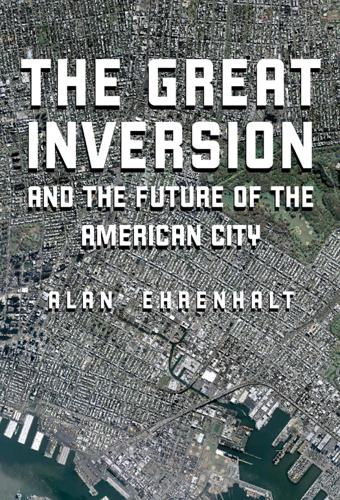
The Great Inversion and the Future of the American City
by
Alan Ehrenhalt
Published 23 Apr 2012
Street life is perhaps the most crucial aspect of the urban revival of the twenty-first century, and street life is not dependent on demographic equality, much as we might desire it to be. Jane Jacobs believed the Financial District could never qualify as a community in the sense in which she used the word. She believed this, in fact, long before the efforts to establish one achieved any sort of traction at all. In The Death and Life of Great American Cities, published in 1961, Jacobs devotes several pages to her argument that Wall Street and its environs could never attract enough residents to acquire a diversity of jobs that would keep workers in the neighborhood beyond the end of the conventional workday, or possess the amenities that could bring in a significant core of visitors from outside.
…
Bushwick would never come to resemble the Greenwich Village of the 1950s that she considered a model of successful urban life. THEN AGAIN, she wouldn’t find the Greenwich Village of the 1950s if she returned to the Village now, and revisited the 500 block of Hudson Street, where she lived, raised her family, and wrote The Death and Life of Great American Cities. This block of Hudson Street in New York’s Greenwich Village was the model for Jane Jacobs’s idea of diverse and harmonious urban living in the 1950s. Jacobs’s own house (in the center, with the large glass window) sold for more than $3 million in 2010. (photo credit 3.2) The West Village that Jacobs knew has managed at the same time to move dramatically upscale and yet show tangible signs of trouble.
…
.: Yale University Press, 1981), p. 6. 9 “Everything is neat and fresh”: Ibid., p. 2. 10 “The sidewalks provided”: Evenson, Paris, p. 20. 11 “nothing can more thoroughly demoralize”: Eugene Viollet-le-Duc, quoted in Marcus, Apartment Stories, p. 160. 12 “Montmartre was to become the dynamo”: Nigel Gosling, quoted in Peter Hall, Cities in Civilization (New York: Pantheon, 1998), p. 230. 13 “The young artists”: Hall, Cities in Civilization, p. 237. 14 “the smells from the kitchen”: Fernande Olivier, Picasso and His Friends (New York: Appleton Century, 1965), quoted ibid., p. 227. 15 “the great ordering system”: James Howard Kunstler, The City in Mind: Meditations on the Urban Condition (New York: Free Press, 2002), p. 3. 16 “Second Empire Paris became”: Loyer, Paris Nineteenth Century, p. 232. 17 “For hours I could stand”: Carl Schorske, Fin-de-Siècle Vienna: Politics and Culture (New York: Vintage, 1981), p. 46. 18 “the Minister-President or the richest magnate”: Stefan Zweig, The World of Yesterday (Lincoln: University of Nebraska Press, 1964), p. 15. 19 “The first glance”: Ibid., p. 14. 20 “It is a sort of democratic club”: Ibid., p. 39. 21 “dismal tenement landscape”: Frederic Morton, A Nervous Splendor: Vienna 1888/1889 (New York: Penguin, 1980), p. 58. 22 “If the British empire was the most powerful”: Jonathan Schneer, London 1900: The Imperial Metropolis (New Haven, Conn.: Yale University Press, 1999), p.19. 23 “a true Londoner”: Ford Madox Ford, quoted in Peter Ackroyd, London: The Biography (New York: Nan A. Talese, 2000), p. 569. 24 “The Strand of those days”: H. B. Creswell, quoted in Jane Jacobs, The Death and Life of Great American Cities (New York: Vintage, 1992), p. 341. 25 “The leisure class in London”: Olsen, The City as a Work of Art, p. 217. 26 “The East End became a terra incognita”: Tristram Hunt, Building Jerusalem (New York: Henry Holt, 2005), p. 390. 27 “where filthy men and women live”: Arthur Morrison, quoted in Asa Briggs, Victorian Cities (New York: Harper & Row, 1963), p. 326. 28 “a great mysterious movement”: H.
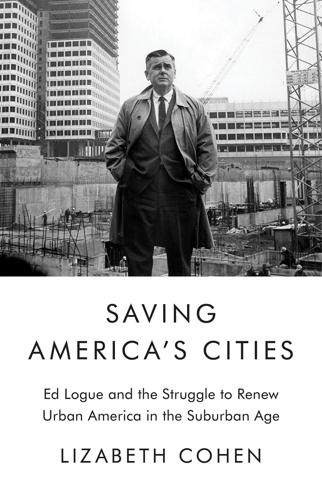
Saving America's Cities: Ed Logue and the Struggle to Renew Urban America in the Suburban Age
by
Lizabeth Cohen
Published 30 Sep 2019
This dichotomy is too simplistic and makes these two twentieth-century giants of urbanism into symbols of rigid orthodoxies. In truth, they were both more complex figures. Moses did not only bulldoze neighborhoods and build insensitively; he constructed crucially needed urban infrastructure.15 In her influential 1961 critique of big planning, The Death and Life of Great American Cities, Jacobs taught the world important lessons in valuing the spontaneous life of the street, in allowing city neighborhoods to develop organically, and in viewing planners—with their top-down expertise—skeptically. But her sweeping repudiation of the planning profession and government intervention left few tools in place for delivering more equitable housing for those requiring it or for constructing badly needed public works.16 No surprise that conservatives, particularly libertarians, have embraced Jacobs alongside her more left-leaning admirers, finding her criticism of urban renewal consistent with their own defense of individual property rights and discomfort with the “federal bulldozer” and other government actions deemed excessive.
…
, another influential treatise hit the bookstores, this one promoting a very different conception from Dahl’s about how democracy should work in cities. In time it gave ballast to participatory democratic critics of urban renewal in New Haven and elsewhere. It was Jane Jacobs’s The Death and Life of Great American Cities, not a book of academic scholarship but nonetheless a learned one that would help transform expectations about what the “public” side of the equation should consist of (government officials were not sufficient) and what it meant to have citizen involvement in planning (more than organized interests must participate).85 The success of Death and Life would challenge urban renewers like Logue in new ways.
…
But it is worth noting that Logue’s liberal fix-it instinct to address what he considered an outrage with a top-down, mandatory remedy was not only resisted by white suburbanites; it was also resented by some black parents who felt it rendered them and their children passive victims in need of saving.110 Not until Logue’s next job as president of the New York State Urban Development Corporation, where he had the authority to operate on a statewide rather than mere city level, would he legally be in a position to implement metropolitan-level strategies intended to integrate communities and schools by race and class. Until then, the reality of urban responsibility and suburban retreat continued to frustrate Logue.111 It played no small part in fact in his deepening feud with Jane Jacobs. Logue published an appreciative but critical review of Jacobs’s The Death and Life of Great American Cities in Architectural Forum in March 1962, predictably taking umbrage at a text that began, “This book is an attack on current city planning and rebuilding.” Around the same time, Logue and Jacobs met up at a debate organized by the Museum of Modern Art in New York City, where he made many of the same points as in the review.
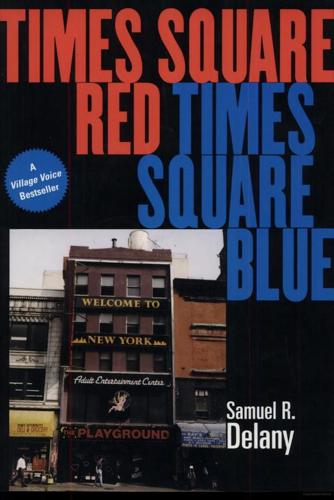
Times Square Red, Times Square Blue
by
Samuel R. Delany
Published 1 Jan 1999
What this may just sign is that those four planned office towers, if not the rest of the brave new mall, could suffer the fate of so many of the country’s artificially built-up downtown areas over the last decade or two—Minneapolis, Minnesota; Springfield, Massachusetts—where no one wants to live or work, so that, as Jane Jacobs warned in her 1961 volume The Death and Life of Great American Cities, because there’s not enough intertwined commercial and residential variety to create a vital and lively street life, the neighborhood becomes a glass and aluminum graveyard, on its way to a postmodern superslum, without even going through the process of overcrowding—abandoned before it’s ever really used.
…
Watching the metamorphosis of such vigil and concern into considered and helpful action is what gives one a faithful and loving attitude toward one’s neighborhood, one’s city, one’s nation, the world. I have taken “contact,” both term and concept, from Jane Jacobs’s instructive 1961 study, The Death and Life of Great American Cities. Jacobs describes contact as a fundamentally urban phenomenon and finds it necessary for everything from neighborhood safety to a general sense of social well-being. She sees it supported by a strong sense of private and public in a field of socioeconomic diversity that mixes living spaces with a variety of commercial spaces, which in turn must provide a variety of human services if contact is to function in a pleasant and rewarding manner.
…
Jacobs mentions neither casual sex nor public sexual relations as part of contact—presumably because she was writing at a time when such things were not talked of or analyzed as elements contributing to an overall pleasurable social fabric. Today we can. When social forces menace the distinction between private and public, people are most likely to start distrusting contact relations. In The Death and Life of Great American Cities (98–111), Jacobs analyzes how limited socioeconomic resources in the area around a public park (lack of restaurants, bathrooms, drugstores, and small shops) can make the mothers who use the playground and live near it feel that their privacy within their home is threatened—thus markedly changing their public attitude to interclass contact.
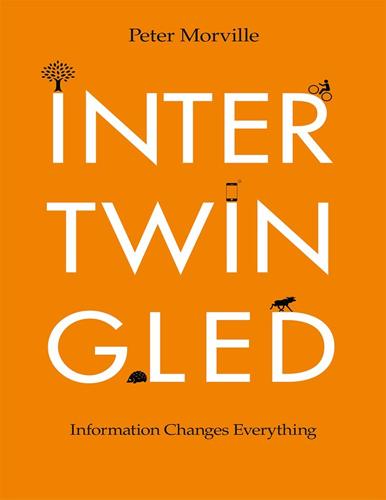
Intertwingled: Information Changes Everything
by
Peter Morville
Published 14 May 2014
Donella may overstate her case, for even when words come one at a time, the narrative that emerges is often nonlinear. Good stories tend to wander. They draw upon our memories, associations, and emotions to create rich, sensory experience. Often, words are the best way to paint a picture. In The Death and Life of Great American Cities, Jane Jacobs does this brilliantly. In a text with no image, she helps us see the city as a system. Her words bring sidewalks, parks, and neighborhoods to life. Jane shows us why traditional maps aren’t good for urban planning. By focusing on roads and buildings, maps reveal the skeleton but miss the point.
…
v Understanding Context by Andrew Hinton (2014). vi Make Things Be Good by Dan Klyn (2013). vii Systemantics by John Gall (1975), p.14. viii Systems Thinking for Curious Managers by Russell Ackoff (2010), p.6. ix Thinking in Systems by Donella Meadows (2008), p.14. x Meadows (2008), p.157. xi Meadows (2008), p.5. xii The Death and Life of Great American Cities by Jane Jacobs (1961), p.376. xiii Jacobs (1961), p.376. xiv The Agile Manifesto, http://agilemanifesto.org. xv The Machine That Changed the World by James Womack (1990), p.56. xvi The Lean Startup by Eric Ries (2011). xvii Meadows (2008), p.170. xviii Should Isle Royale Wolves Be Reintroduced by John Vucetich (2012), p.130.
…
xl Semiotics: The Basics by Daniel Chandler (2002), p.111. xli Conversion, Culture, and Cognitive Categories by Paul G. Hiebert (1978). xlii Centered and Bounded Sets by Dan Klyn (2012). xliii Life of Pi by Yann Martel (2003), p.66. xliv To learn more about holacracy, see holacracy.org. xlv The Death and Life of Great American Cities by Jane Jacobs (1961), p.392. xlvi The New Library Patron by Lee Rainie (2013). xlvii The Timeless Way of Building by Christopher Alexander (1979). xlviii The Battle for the Life and Beauty of the Earth by Christopher Alexander, Hans Joachim Neis, and Maggie Moore Alexander (2012), p.115.
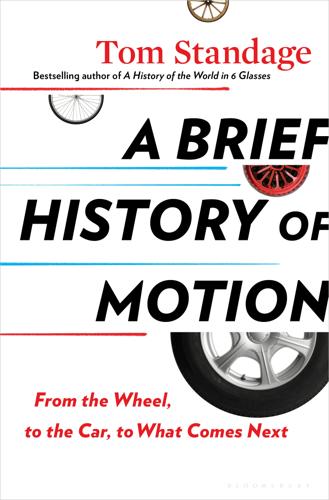
A Brief History of Motion: From the Wheel, to the Car, to What Comes Next
by
Tom Standage
Published 16 Aug 2021
But it provides a glimpse of what roads were like before the arrival of the car—and what they could be like again. 7 The Road to Suburbia The present relationship between cities and automobiles represents, in short, one of those jokes that history sometimes plays on progress. —JANE JACOBS, THE DEATH AND LIFE OF GREAT AMERICAN CITIES, 1961 DREAMING OF AUTOPIA It was a vision of the future: 1960, as seen from 1939. The theme of the 1939 New York World’s Fair, held at Flushing Meadows–Corona Park in the borough of Queens, was “The World of Tomorrow.” The first such exposition with an explicit focus on the future, the fair featured the debut of new technologies including nylon fabric, the View-Master system for viewing stereoscopic color photographs, an early version of Smell-O-Vision, and the first electronic speech synthesizer.
…
NOTES INTRODUCTION Cities’ dependence on horses in general, and the problem of horse manure in particular, are discussed by Tarr, The Search for the Ultimate Sink; Thompson, “Victorian England: The Horse-Drawn Society”; and McShane, Down the Asphalt Path. The lurid descriptions of “pea soup” can be found in Jacobs, The Death and Life of Great American Cities. The horse-manure problem had been exacerbated by another form of excrement: guano (mineralized seabird droppings), which was adopted as an agricultural fertilizer starting in the 1840s because it had a much higher nitrogen content than manure. The value of horse manure gathered from city streets dropped, making disposal more expensive.
…
CHAPTER 7 The account of the debates over utopian cities and garden cities draws on Shelton, “Automobile Utopias and Traditional Urban Infrastructure”; Fotsch, “The Building of a Superhighway Future at the New York World’s Fair”; Buder, Visionaries and Planners; Ladd, Autophobia; McShane, Down the Asphalt Path; and Jacobs, The Death and Life of Great American Cities. For the history and future of suburbanization, see Weaver, “The Suburbanization of America,” and Gallagher, The End of the Suburbs. On General Motors and streetcars, see Slater, “General Motors and the Demise of Streetcars.” For retrofitting of suburbs, see Williamson, “Retrofitting Suburbia.”
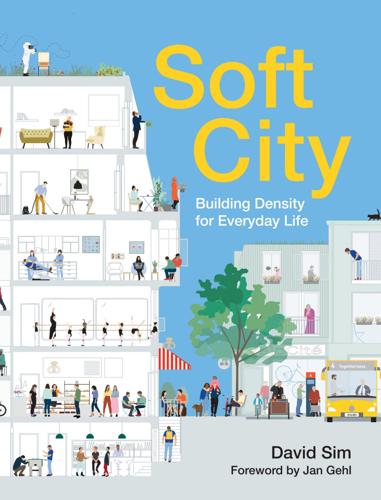
Soft City: Building Density for Everyday Life
by
David Sim
Published 19 Aug 2019
Seemingly, it took 65 years and numerous Modernist city districts to reach this conclusion. However, a counter cities-for-people movement had been gradually developing for quite a number of years in reaction to the technocratic modernist movement. In the area of writings and research, the work of Jane Jacobs in New York, and her famous 1961 book The Death and Life of Great American Cities, stands out. Jane Jacobs raised the flag and excellently described many of the problems of Modernist city planning. She started to formulate new directions: look out of your windows; look at the people; look at life before you plan and design. In the years and decades following her call to arms, a number of researchers developed and deepened the work concerning how the built form influences quality of life.
…
It was number one in Metropolis’s rankings in 2016; and in the Economist, it came in at number nine on the city livability ranking from 2005-2018. 5 Jaime Lerner, Planning Report, October 2007: https://www.planningreport.com/2007/11/01/jaime-lerner-cities-present-solutions-not-problems-quality-life-climate-change (accessed 14 April 2019). Building Blocks 6 City of Copenhagen, Green Courtyards program, established in 1992. 7 Jane Jacobs, The Death and Life of Great American Cities (New York: Random House 1961). 8 Karsten Pålsson, Public Spaces and Urbanity: How to Design Humane Cities. Construction and Design Manual (Berlin: DOM Publishers 2017), 164. 9 G. J. Coates, “The Sustainable Urban District of Vauban in Freiburg, Germany,” Int. J. of Design & Nature and Ecodynamics.
…
A study carried out with similar street layouts, but different ground floors—active (with door openings, niches, etc) versus inactive (without windows, door openings, etc)—demonstrated that seven times more people stop at the active ground floors compared to the inactive. Gehl, Jan. Kaefer, Lotte Johansen, Reigstad, Solvejg. “Close encounters with buildings” in Urban Design International (2006) 11, 29-47. Time of Your Life 11 John Lennon, Beautiful Boy (1980). Getting About and Getting On 12 Jane Jacobs, The Death and Life of Great American Cities (New York: Random House 1961), 36-37. 13 ITDP, Pedestrians First. Tools for a Walkable City (ITDP, 2018). 14 See Jan Gehl. Cities for People (Washington D.C.: Island Press 2010). 15 Jan Gehl. Cities for People (Washington D.C.: Island Press 2010), 131-32. 16 Streets should make up for 30% of the area of a city according to UN Habitat: UN Habitat, Streets as Public Spaces and Drivers of Urban Prosperity (UN Habitat, Nairobi: 2013). 17 City of Perth: Two Way Streets (City of Perth 2014); more on the disadvantage of one way streets in Vikash V.
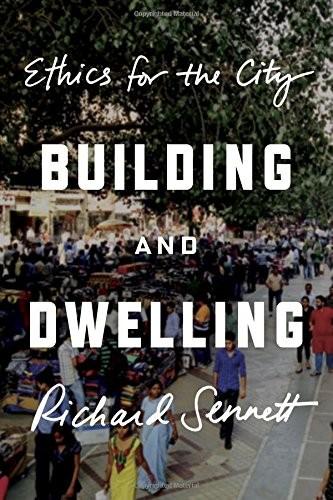
Building and Dwelling: Ethics for the City
by
Richard Sennett
Published 9 Apr 2018
– LEWIS MUMFORD DEBATES JANE JACOBS Jane Jacobs became famous as an activist for the campaign she waged against Robert Moses, the dictatorial planner of much of twentieth-century New York who wanted to turn Fifth Avenue into a highway running through one of the city’s most loved parks, Washington Square. She persuaded the public to see this proposal as criminal, and eventually New York’s politicians relented. A great book then explained why she had been so persuasive. In The Death and Life of Great American Cities (1961), she argued against conceiving of the city as a purely functional system; she asserted that big master-planning inevitably suffocates community; she spoke for mixed neighbourhoods, for informal street life and for local control. Her books – she wrote many more than this one, late in her life taking a philosophic turn – put her squarely in the Chicago School ethnographic tradition.
…
In The Economy of Cities (1969) she explored the trading and other exchange structures which make a complex city work: there has to be high density, and this density has to be diversified in function as well as population. Combine the two, and unexpected things can happen; time’s arrow ceases to shoot straight. As she put it in The Death and Life of Great American Cities, ‘if density and diversity give life, the life they breed is disorderly’. She was thinking in part about commercial relations, as did Aristotle; put a lot of competitors together and they compete, connive and flourish – which is the logic today of ‘innovation hubs’. She was also thinking of politics: it’s most alive when debate is open and fractious and things happen.
…
She was also thinking of politics: it’s most alive when debate is open and fractious and things happen. A city has to operate informally for these benefits to appear; the four pre-planned functions of the Charter of Athens will not give a city this kind of fizzy serendipity.19 There are resonances to her title, The Death and Life of Great American Cities. Psychoanalysis sees those words ‘death’ and ‘life’ as more than figures of speech. Freud’s writings from the 1920s onwards portray a struggle between the forces of life and death, Eros and Thanatos. In the mythic family of Thanatos, as imagined in classical times, deadliness can take various forms.

The Survival of the City: Human Flourishing in an Age of Isolation
by
Edward Glaeser
and
David Cutler
Published 14 Sep 2021
The entrepreneurs relocated to cheaper, poorer parts of the city, which led to the fights over gentrification that are the topic of the next chapter. But if the banks go remote or move to another city, then the space becomes available again. Jane Jacobs, author, journalist, and activist, was among the wisest observers of twentieth-century urban America. Her 1961 book, The Death and Life of Great American Cities, remains one of the true masterpieces of nonfiction writing. In that book, Jacobs wrote that cities needed “cheap and makeshift” space to permit the growth of new businesses. She was right about that, although she incorrectly thought that historic preservation would promote affordability.
…
grew by more than seven million: Data from US Bureau of Labor Statistics, “All Employees, Total Nonfarm.” In about one fourth: Ryan, “United States Office Outlook—Q3 2020.” Thomas Menino launched: ECPA Urban Planning, “Case Study: The Boston Waterfront Innovation District.” “cheap and makeshift”: Jacobs, The Death and Life of Great American Cities, 397. CHAPTER 8: THE BATTLE FOR BOYLE HEIGHTS AND THE CLOSING OF THE METROPOLITAN FRONTIER At 2:35 p.m.: “New York’s Governor and Mayor of New York City Address Concerns of the Damage.” The city had seen its crime rate: “New York Crime Rates 1960 to 2019,” Disaster Center.
…
ineligible for federally supported: Reft, “Segregation in the City of Angels: A 1939 Map of Housing Inequality in L.A.” “class and occupation”: Home Owners’ Loan Corporation, “Security Map of Los Angeles County/Area Desription.” “the Federal Government”: Home Owners’ Loan Corporation. As Jane Jacobs . . . no-man’s-lands: Jacobs, The Death and Life of Great American Cities. Robert Moses: Dunlap, “Why Robert Moses Keeps Rising from an Unquiet Grave.” Between 1944 and 1965: Estrada, “If You Build It, They Will Move: The Los Angeles Freeway System and the Displacement of Mexican East Los Angeles, 1944–1972.” “to construct”: Estrada, 300. Highways 5, 10, 60, and 101: Artsy, “Boyle Heights, the Land of Freeways.”
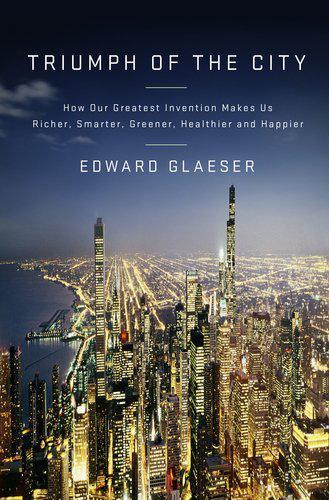
Triumph of the City: How Our Greatest Invention Makes Us Richer, Smarter, Greener, Healthier, and Happier
by
Edward L. Glaeser
Published 1 Jan 2011
This discrepancy isn’t because Mumbai’s police are doing a great job, and Mumbai is poorer than Rio. The best explanation for the safety of Mumbai’s slums is that, while these places maybe poor, they’re also well-functioning social spaces, like the Greenwich Village described by Jane Jacobs in her masterpiece The Death and Life of Great American Cities fifty years ago. In these areas, residents watch the streets and alleys. Misbehavior is quickly noticed and dealt with, not by the police, but by the community. Within cities too, crime rates move up and down for reasons that are hard to fathom. Murder is the only crime that can be reliably used to measure long-term changes in public safety, because other crimes are often underreported for various reasons.
…
She insinuated that there were corrupt deals between city officials and builders. Eventually, she created enough heat so that the mayor himself, once a strong supporter of the project, gave it up. In that same year, a few months after beating City Hall, Jacobs published her masterpiece, The Death and Life of Great American Cities. It is a great book, which investigates and celebrates the pedestrian world of mid-twentieth-century New York. She grounds her case for mixed-use zoning by arguing that street life is the essence of city living and city safety. She argues against high-density dwellings by pointing out that they segregate residents from their streets.
…
A modicum of good urban planning can ensure that high-rises have enough foot traffic to keep streets safe. Neither Midtown Manhattan nor Hong Kong is short on pedestrians, and crime is relatively rare. Jane Jacobs’s opposition to urban renewal led her to a more sweeping dislike for tall buildings in general. In The Death and Life of Great American Cities, she argued that urban neighborhoods can only thrive when they have between one and two hundred households per acre. She argued that cities need at least a hundred homes per acre to generate enough street traffic to support exciting restaurants and shops. She also argued that two hundred homes per acre was a “danger mark”; once neighborhoods crossed that point, they risked sterile standardization.
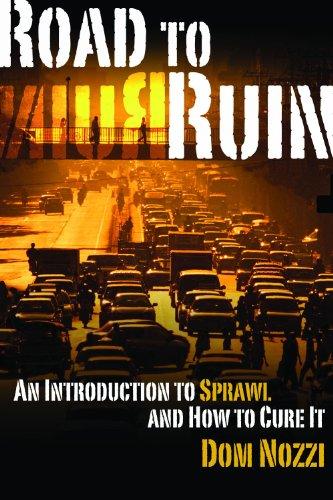
Road to ruin: an introduction to sprawl and how to cure it
by
Dom Nozzi
Published 15 Dec 2003
Walkable Streets and Blocks As designers have ignored the needs of pedestrians over the past several decades, the public realm—the streets, parks, sidewalks, and plazas—has become dangerous, uninviting, and undesirable. Pedestrians in such a community represent little more than inconveniences to motorists. As Jane Jacobs noted 40 years ago in The Death and Life of Great American Cities, “lowly, unpurposeful and random as they may appear, sidewalk contacts are the small change from which a city’s wealth of public life may grow” (p. 72). Yet many new residential and commercial developments either neglect to build a sidewalk along the frontage street or build one that is too narrow to be usable.
…
These forms of affordable housing become increasingly affordable as the number of New Urbanist communities grows, which will lower prices as a result of competition. Mixed-use and mixed-income housing units are allowable and acceptable in New Urbanist designs because they are properly scaled and detailed and do not generate as much car travel as single-use developments. As Jane Jacobs noted in The Death and Life of Great American Cities, vibrant downtowns (which are hurt by an auto-based culture) provide important entry-level, low-capital job opportunities for low-income people—selling food from carts, providing personal services, selling specialty goods, and so forth. And what do our auto-dominated communities offer the poor?
…
Real Price of Gas. http://www. icta.org/ctanews/realpr.htm. Accessed 20 June 2002. Jackson, K. T. Crabgrass Frontier. New York: Oxford University Press, 1985. Jackson, T. T. “Transportation Concurrency: How It Can Be Achieved.” Florida Planning 10, 10 (1990): 7–8. Jacobs, J. The Death and Life of Great American Cities. New York: Vintage, 1961. Kasowski, K. “The Costs of Sprawl, Revisited.” PAS Memo, February 1993. ———. “Suburban Sprawl.” Florida Planning 7, 1 (January 1995): 3, 5. Kay, J. H. “Without a Car in the World,” New Colonist, http://www. newcolonist.com/carfree_kay.html. Accessed 15 June 2001.

The Secret War Between Downloading and Uploading: Tales of the Computer as Culture Machine
by
Peter Lunenfeld
Published 31 Mar 2011
She went to jail twice for defending her neighborhood, and was able to work with a large group of people who questioned why cars and commuters were more important than parks, communities, and pedestrians. The woman decided to write down the record of her experiences and thoughts about cities and urban planning, and the field of urban planning was changed forever. She was Jane Jacobs, the year was 1961, and her book was The Death and Life of Great American Cities. Jacobs was our preeminent urban anthropologist—a person who could look at a city block, and through building up the details, show exactly how it worked. An associate editor of Architectural Forum in the 1950s, she became more and more concerned with the deadening effects of urban planning on cities.
…
Jacobs’s attention to detailed observation, to bottom-up rather than top-down modeling, and her attacks on monocultures of all kinds commend her work to us. Though jeered at by professional planners of her day—one dismissed her work as “bitter coffee-house ramblings”—Jacobs has certainly had the last laugh, with The Death and Life of Great American Cities utterly upending town planning for more than fifty years through its articulation of precisely what makes a neighborhood worth inhabiting. We will spend at least another generation working out how Jacob’s fine-grained mixtures should function within digital environments, but mining her work for insights into the culture machine does not stop there.
…
Never submit to failure.” has to be one of the most repeated pieces of advice to sales trainees everywhere. Quoted in Richard Langworth, Churchill by Himself: The Definitive Collection of Quotations (New York: Public Affairs, 2008), 569; originally in Winston Churchill, My Early Life: A Roving Commission (London: Thornton Butterworth, 1930), 74. 7. Jane Jacobs, The Death and Life of Great American Cities (1961; repr., New York: Modern Library, 1993; Jane Jacobs, Systems of Survival: A Dialogue on the Moral Foundations of Commerce and Politics (New York: Random House, 1992). 188 NOTES 8. Manuel DeLanda offers a succinct definition of the difference between hierarchies and meshworks in “Homes: Meshwork or Hierarchy?”
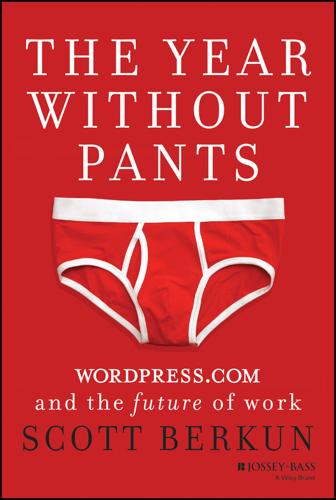
The Year Without Pants: Wordpress.com and the Future of Work
by
Scott Berkun
Published 9 Sep 2013
Some were fixed immediately, others were fixed soon, some were rejected, and others fell into the limbo of issues whose fate may never be decided. Source: Greg Brown, a code wrangler at Automattic. If you ask the old-timers, Automattic believed in the broken window theory, the idea popularized by Jane Jacobs in her book The Death and Life of Great American Cities.1 She examined why some neighborhoods in New York City were safer than others and concluded that neighborhoods that were well maintained by their inhabitants, including small things like picking up trash and fixing broken windows, tended to have less crime. In other words, by regularly fixing small things, you prevent bigger problems from starting.
…
There was a mature balance of reporting data yet leaving people free to decide what they meant or how much they wanted to use in their thinking. MC was a manifestation of the line between support and creatives. MC was a tool, created by the Janitorial team, to support all the others in doing their work. But rarely would the data dictate to anyone what should be done. Notes 1 Jane Jacobs, The Death and Life of Great American Cities (New York: Vintage, 1992; originally published 1961). The theory was developed by James Q. Wilson and George L. Kelling, “Broken Windows,” Atlantic Monthly (March 1982). 2 Just as a broken leg will take more time to fix than a scratch, a simple incoming-versus-fix chart discounts possibly important details such as the scope of each issue. 3 A good summary of the problems with evaluating programming work based on lines of code is at http://en.wikipedia.org/wiki/Source_lines_of_code#Disadvantages.
…
See Highlander Communication: clarity of Company meeting (Budapest); author's presentation on leading Team Social; experiment at; Post Postmodernism team project Company meeting (Seaside, Florida): author's arrival at; description of Seaside; employee group photo at; informal socializing at; mentioned in August 2010 town hall meeting; typical retreat (off-site) contrasted to; work on Team Social's Hovercard project at; work process at Compensation Conrad, Tony Continuous deployment Copyleft Coworking spaces Crawford, Matthew Creative Abrasion Creative employees: necessity of shipping by; support kept from infringing upon; using humor when nagging Culture: attracts employees with similar values Customer support: Athens train system vs. Automattic D Daily builds Data: Automattic's relationship to; MC reporting system for; paradox of; role in decision making; as trap; with voice Data General Davis, Robert S. Deadlines: lack of; for launching Jetpack at SXSW; short, impact on teamwork; when writing The Death and Life of Great American Cities(Jacobs) Decision making Deep dive technique Defensive management Democratizing publishing Design: complex, of WordPress; interface, done first; success determined by; vision needed for coherence of Dogpatch Labs Donkin, Richard Dorman, Anne Double down DreamHost E EMACS E-mail: Automattic communication via; disadvantages of; no mandate on using; notifying blogger of response to blog; notifying blogger of visitor subscribing to blog; observations about company sent to Mullenweg via; used with P2s; WordPress.com support via E-mailopathy Emotions Expensify Experiments: author's mission to include; with benefits' effect on performance; at Budapest company meeting; as essential; and fear of new ideas; at Hawaii meet-up; with new communication tools; shift to teams as; team meet-ups as opportunities for; teams and team leads as F Face-to-face interactions: author's preference for; author's trip to San Francisco for; cost of meet-ups for; at mini-team meet-up in San Francisco; necessity of Feedback Fogel, Karl Follow the Sun Fontainhas, Zé Fox, Jon Friction Functionality Future of work: creatives vs. supporters and; focus on results vs. traditions in; impossibility of predicting; increasing prevalence of working remotely; meaningful work in; self-sufficient passionate employees and G General public license (GPL) Gibson, William GitHub GoDaddy Google Google Docs spreadsheet Google Hangouts Gravatar Griz (dog) H Happiness Engineers (HE) Harstein, Ran Hawaii.

Working in Public: The Making and Maintenance of Open Source Software
by
Nadia Eghbal
Published 3 Aug 2020
Yet I’m asked to speak about it, and the work I’m actually *paid* to do no one really wants to hear about. ”240 Even as software’s purchase value is being driven dramatically down, its social value seems to be going dramatically up. We can’t live without software anymore, but we also don’t want to pay for it. How is this the case? The author Jane Jacobs explores these conflicting views in her 1961 book The Death and Life of Great American Cities, in which she tries to explain why urban planning policy failed cities. Jacobs’s major critique of urban planning in the 1950s is that the planners treated cities—the layout of their buildings, parks, and roads—as static objects, which were only developed at the outset, rather than continuously revised according to how people used them.
…
(draft), University of Miami School of Law, April 6, 1997, http://osaka.law.miami.edu/~froomkin/articles/newecon.htm. 237 Ben Thompson, “AWS, MongoDB, and the Economic Realities of Open Source,” Stratechery, January 14, 2019, https://stratechery.com/2019/aws-mongodb-and-the-economic-realities-of-open-source/. 238 Bill Gates, “An Open Letter to Hobbyists,” February 3, 1976, via Wikimedia Commons, https://commons.wikimedia.org/wiki/File:Bill_Gates_Letter_to_Hobbyists.jpg. 239 David Friedman, Price Theory: an Intermediate Text (Cincinnati, OH: South-Western Publishing Co, 1986), 20. 240 Ben Lesh (@BenLesh), “Open Source is such a strange thing . . .,” Twitter, November 30, 2017, 1:26 p.m., https://twitter.com/BenLesh/status/936300388906446848. 241 Jane Jacobs, The Death and Life of Great American Cities (New York: Vintage Books, 1992), 433. 242 Timothy Patitsas, Nadia Eghbal, and Henry Zhu, “City as Liturgy,” Hope in Source, podcast audio, March 21, 2019, https://hopeinsource.com/city/. 243 Randall W. Eberts, “White Paper on Valuing Transportation Infrastructure,” W.E. Upjohn Institute for Employment Research, January 1, 2014, 10, https://research.upjohn.org/cgi/viewcontent.cgi?
…
,” The Vue Point, Medium, September 11, 2017, https://medium.com/the-vue-point/vue-is-now-on-opencollective-1ef89ca1334b. 258 Sophie Alpert (@sophiebits), “Is this what it feels like . . .,” Twitter, November 10, 2019, 7:27 p.m., https://twitter.com/sophiebits/status/1193686560413106177. 259 Owen Phillips, “The Anonymous MVP of the NBA Finals,” The Outline, June 12, 2017, https://theoutline.com/post/1706/the-anonymous-mvp-of-the-nba-finals-velocityraps-illegal-streaming. 260 Ryan Regier, “We Are in a Golden Age of Illegal Sports Streaming and It’s Showing Us How Copyright Infringement Can Result in Better Content,” Medium, January 20, 2019, https://medium.com/@ryregier/we-are-in-a-golden-age-of-illegal-sports-streaming-and-its-showing-us-how-copyright-infringement-d835ae291ed2. 05 261 Jane Jacobs, The Death and Life of Great American Cities (New York: Vintage Books, 1992), 55. 262 Office of the Under Secretary of Defense (Comptroller), “National Defense Budget Estimates for FY2020,” United States Department of Defense, May 2019, https://comptroller.defense.gov/Portals/45/Documents/defbudget/fy2020/FY20_Green_Book.pdf. 263 Guido van Rossum, “[Python-Committers] Transfer of Power,” The Python-Committers Archives, July 12, 2018, https://mail.python.org/pipermail/python-committers/2018-July/005664.html. 264 Jake Edge, “PEP 572 and Decision-Making in Python,” LWN.net, June 20, 2018, https://lwn.net/Articles/757713/. 265 Guido van Rossum, “A Different Way to Focus Discussions,” LWN.net, May 18, 2018, https://lwn.net/Articles/759557/. 266 Jonathan Zdziarski, “On the State of Open Source,” Zdziarski’s Blog of Things, October 3, 2016, https://www.zdziarski.com/blog/?

The Great Mental Models: General Thinking Concepts
by
Shane Parrish
Published 22 Nov 2019
. … Though technical in nature, cartography, like architecture, has attributes of both a scientific and artistic pursuit, a dichotomy not satisfactorily reconciled in all presentations. » Norman J.W. Thrower11 Maps can influence territories: This problem was part of the central argument put forth by Jane Jacobs in her groundbreaking work, The Death and Life of Great American Cities. She chronicled the efforts of city planners who came up with elaborate models for the design and organization of cities without paying any attention to how cities actually work. They then tried to fit the cities into the model. She describes how cities were changed to correspond to these models, and the often negative consequences of these efforts.
…
The Uses and Abuses of History. Toronto: Penguin, 2008. 10 An excellent analysis of the division of the Middle East after World War I can be found in: MacMillan, Margaret. Paris 1919: Six Months that Changed the World. New York: Random House, 2001. 11 Thrower, Norman J.W. Ibid. 12 Jacobs, Jane. The Death and Life of Great American Cities. New York: Vintage Books, 1992. (Original published 1961). Page 438. 13 Hand, David J. Wonderful Examples, but Let’s not Close Our Eyes. Statist. Sci. 29 (2014), no. 1, 98--100. doi:10.1214/13-STS446 Circle of Competence 1 Watson, Thomas J., and Peter Petrie. Father, Son, & Co.: My Life at IBM and Beyond.

Stuck: How the Privileged and the Propertied Broke the Engine of American Opportunity
by
Yoni Appelbaum
Published 17 Feb 2025
Storekeepers who kept their eyes on the street, allowing people to walk about in safety. Countermen who doubled as concierges for the working classes, holding their keys or their packages. Shop owners who dwelled amid their customers and cared for their communities. Returning home to Hudson Street, Jacobs pounded out The Death and Life of Great American Cities on her Remington. Her book, published in 1961, took aim at urban renewal and painted a vivid picture of all that it destroyed in the name of progress. When, that same year, Jacobs learned that the city intended to designate her own neighborhood for renewal, she rallied the inhabitants to its defense.
…
Michael Harrington’s Other America focused attention on the depth and persistence of poverty; Betty Friedan’s Feminine Mystique highlighted domesticity’s often-stifling effect on women; and James Baldwin’s Fire Next Time pointed to the violence and oppression of racism. But it was three other books that, by mounting versions of the same critique in different spheres, had a particularly profound effect on the years that followed. Jane Jacobs published The Death and Life of Great American Cities in 1961. The following year brought Rachel Carson’s Silent Spring, a warning on the harms of pesticides. And in 1965, Ralph Nader’s Unsafe at Any Speed showed that automobile manufacturers had failed to take even basic measures to save lives. These three books were rooted in skepticism of America’s relentless pursuit of profit and growth, and in horror at its unaccounted costs.
…
GO TO NOTE REFERENCE IN TEXT In 1956, in front: Leticia Kent, “Oral History Interview of Jane Jacobs,” Oct. 1997, 23, Greenwich Village Society for Historic Preservation Archives. GO TO NOTE REFERENCE IN TEXT She watched Samuel Halpert: Jane Jacobs, The Death and Life of Great American Cities (New York: Vintage Books, 2016), 50. GO TO NOTE REFERENCE IN TEXT The small stores peppering: Alex Krieger and William S. Saunders, Urban Design (Minneapolis: University of Minnesota Press, 2009), 9. GO TO NOTE REFERENCE IN TEXT “Nothing that was done”: Jacobs, interview by Roberto Chavez, Tia Duer, and Ke Fang for the World Bank, Feb. 4, 2002, 14.
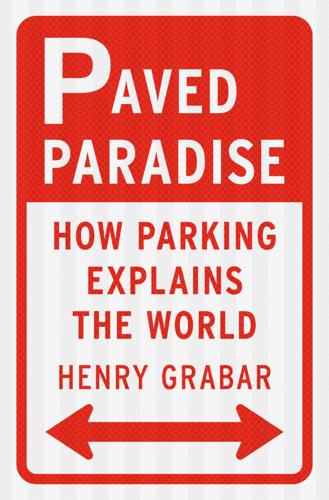
Paved Paradise: How Parking Explains the World
by
Henry Grabar
Published 8 May 2023
The developer James Rouse, who would go on to mastermind downtown renewal projects like Harborplace in Baltimore and Faneuil Hall in Boston, wrote that this “most magic plan” was “the largest, and the boldest, and the most complete dealing with the American city.” And even Jane Jacobs, germinating the ideas that would make up her landmark antiplanning book The Death and Life of Great American Cities, wrote a self-described “fan letter” to Gruen, saying his Fort Worth plan was of “incalculable value” and would return America to a time of “downtowns for the people.” But Gruen never got his Fort Worth plan: the Texas legislature was not so easily charmed by the vision of the Viennese architect who flew in from Los Angeles, and rejected Gruen’s allies’ urban renewal bill.
…
Other excellent histories that helped inform my perspective on the development of the American city include Crabgrass Frontier by Kenneth Jackson, Building Suburbia by Dolores Hayden, Mall Maker by Jeffrey Hardwick, Down the Asphalt Path by Clay McShane, Voices of Decline by Robert Beauregard, The Drive-In, the Supermarket, and the Transformation of Commercial Space in Los Angeles by Richard Longstreth, The Big Roads by Earl Swift, Dingbat 2.0, edited by Therman Grant and Joshua Stein, and The Politics of Place: A History of Zoning in Chicago by Dana Caspall and Joseph Schwieterman. The first place I ever read a critical word about parking lots was, of course, in the chapter on “border vacuums” in The Death and Life of Great American Cities. I did the reporting during the coronavirus pandemic and I am especially grateful to everyone who took the time to share some of their time in person: Ginger Hitzke, José Trinidad Castañeda, Nathan Carter, John Hammerschlag, Mark Lawrence, Lori Droste, Michael Manville, Mott Smith, John Van Horn, Sam Schwartz, Jane Wilberding, Lindsay Bayley, Chrissy Mancini Nichols, Mark Vallianatos, Victor Pontis, Howard Yarus, Christophe Najdovski, Clay Grubb, Matt Parkerson, Susan Holgren, Greg Anderson, and others.
…
Go to note reference in text “We are more interested”: Segrave, Parking Cars in America, loc. 1180. Go to note reference in text 95 percent of U.S. cities: Erik Ferguson, “Zoning for Parking as Policy Process: A Historical Review,” Transport Reviews 24, no. 2 (2004): 177–94. Go to note reference in text “duller and deader”: Jane Jacobs, The Death and Life of Great American Cities (New York: Vintage Books, 1968), 19. Go to note reference in text 7 percent each year: Schicker, “Parking Irritant.” Go to note reference in text Chapter 5: Paved Paradise By square footage: Maria Cecilia P. Moura, Steven J. Smith, David B.

Road to Nowhere: What Silicon Valley Gets Wrong About the Future of Transportation
by
Paris Marx
Published 4 Jul 2022
From the late 1950s through the 1960s, Jacobs was a leader in the campaign against Moses’s urban renewal strategy—in part because of how it affected her neighborhood of Greenwich Village—and his planned Lower Manhattan Expressway that would have cut through Manhattan to connect the Manhattan Bridge and the Williamsburg Bridge to the Holland Tunnel. But she was also not alone; similar campaigns against urban highways were occurring across the United States in the 1960s. Jacobs’s seminal critique of modernist urban planning in The Death and Life of Great American Cities, published in 1961, outlined the importance of the diversity of urban communities and argued against the effort to encourage more people to move to suburbs on the urban fringe. Yet, as sociologist Sharon Zukin has explained, Jacobs directed her ire at urban planners, not at the forces of capital that were really driving the reconstruction of the American city to suit their interests.
…
See Interstate Highway System Convention and Visitors Authority, 148 copper mines, 79, 80 counterculture, 41–2, 44 Covid-19 air pollution and, 231 autonomous delivery companies and, 173 rapid delivery services during, 192 “creative class” theory, 200 CVS, 172–3 cyberoptimists, 56 Cybertruck (Tesla), 84, 188, 189 DARPA, 45–6, 120 DARPA Strategic Computing Initiative, 119 Daub, Adrian, 59 deaths pedestrian, 16–7, 31–2 from road traffic crashes, 30–2 The Death and Life of Great American Cities (Jacobs), 26–7 de Bortoli, Anne, 169–70 “A Declaration of the Independence of Cyberspace” (Barlow), 52–3 defense spending, 38–9, 45–6 deindustrialization, 199 Delaney, Matt, 173 Delanoë, Bertrand, 210, 211 delivery companies, autonomous, 173, 177–9, 192–3 Dell, 72 Democratic Republic of Congo (DRC), 72–3 Department of Transportation (DOT), 119–20 Detroit, MI Detroit Economic Club, 138 superhighway plan, 22 Detroit Economic Club, 138 Dickmanns, Ernst, 119 Didi Chuxing, 152 digital redlining, 195 Do Androids Dream of Electric Cars?
…
See Interstate Highway System Highway Trust Fund, 25 Hill, Steve, 148 Horan, Hubert, 102, 106, 107 horsedrawn carriages, 15–6 The Horseless Age (magazine), 66 housing prices, 128 Humphreys & Partners, 154–5 Hyperloop, 143, 155, 219, 225 IBM, 50 An Inconvenient Truth (documentary), 68–9 individualized transport, Musk on, 188 Infinite Detail (Maughan), 129 Infrastructure Investment and Jobs Act (2021), 127 Instacart, 111 Instagram, 61–2 Intel, 40 Intermodal Surface Transportation Efficiency Act (1991), 119 International Energy Agency, 74–5 International Rights Advocates, 72 internet origins of, 50 privatization of infrastructure of, 55–6 “internet of landlords,” 197–8 Interstate Highway System about, 24, 46, 140, 221 controlled access highways (freeways/motorways), 21–2 development of streets, 11–2 double-decker highways, 151 in Los Angeles, 140–1 in Paris, 210–1 reconceptualization of, 23 slowdown of highway construction boom, 26 traffic and, 142–4 Isaac, Mike, 110 Jacobs, Jane, 230, 232 as campaign leader against urban renewal, 26 The Death and Life of Great American Cities, 26–7 Japan, innovation in, 45 Jarvis, Charlie, 193 jaywalkers, 124–7, 215–6 Jennings, Lois, 42 jitneys, 89–91, 92, 108–9 Jobs, Steve, 36–7, 42, 44 Jump, 166–8 Kalanick, Travis, 5, 92–4, 97, 105, 113, 116 Kamoto Copper Company, 73 Kara, Siddharth, 73 Katy Freeway, 140 Kelly, Kevin, 53 Kenney, Martin, 182 Khosrowshahi, Dara, 133–4 Kirsch, David, 65, 66, 71, 86 Krafcik, John, 138 Kroger, 172–3 Labour Party, 209 Labrador, Canada, 80 Laceese, Francis, 80 Latin America bike lanes in, 171 Pacto Ecosocial del Sur, 225 rapid transit systems in, 215 leasing model, for taxi drivers, 101–3 Le Guin, Ursula K.
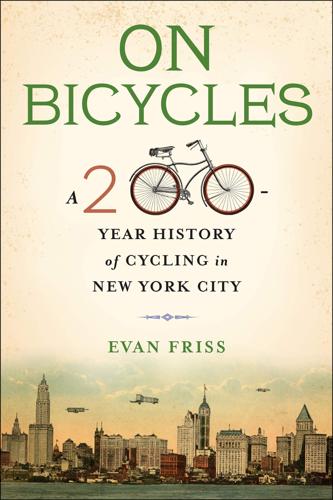
On Bicycles: A 200-Year History of Cycling in New York City
by
Evan Friss
Published 6 May 2019
As a colleague of hers at the Forum noted in 1956, Jacobs “knows a lot about NYC traffic. Lewis Mumford [an urban theorist] might learn a good deal on the handlebars of her bike.” So too might have Robert Moses.41 FIGURE 3.7 Jane Jacobs on her bicycle in front of a gas station. Architectural Forum, April 1956, 51 While Jacobs’s magnum opus, The Death and Life of Great American Cities, hardly mentions the bicycle, the critique she presents of Moses and autocentric planning generally must have been at least in part shaped by her own experience biking through the city. Rolling along streets designed for cars and feeling at the mercy of hulking steel vehicles, cyclists had a unique perspective on traffic, flow, and safety.
…
New York City Department of Parks, Recreational Facilities for New Yorkers (New York: Dept. of Parks), 1946; Recreational Facilities for New Yorkers, 1948; Recreational Facilities for New Yorkers, 1953; Recreational Facilities for New Yorkers, 1956. 40. Robert Kanigel, Eyes on the Street: The Life of Jane Jacobs (New York: Vintage, 2016), 134–35. 41. W. McQ., “(Get A Bike!),” Architectural Forum, April 1956, 43, 51; Kanigel, Eyes on the Street, 134–35. 42. For those cycling references, see Jane Jacobs, The Death and Life of Great American Cities (New York: Vintage, 1961), 87, 110, 267; David Byrne, Bicycle Diaries (New York: Viking, 2009), 2. For more on the unique ways cyclists experience the city and a phenomenological take on the practice, see Jesús Illundáin-Agurruza and Michael W. Austin, eds., Cycling: Philosophy for Everyone: A Philosophical Tour de Force (Malden, MA: Wiley-Blackwell, 2010); Janez Strehovec, “Cycling as Reading a Cityscape: A Phenomenological Approach to Interface-Shaped Perception,” Indo-Pacific Journal of Phenomenology 10, no. 3 (October 2010): 1–11; Robert Rao, “Urban Cycling as the Measure of the City: Experience, Policy and the Cultural Politics of Mobility” (master’s thesis, Simon Fraser University, Spring 2010), esp. 47–52. 43.
…
Ogden, 192n4 Gibson Dunn, 164 Giuliani, Rudy, 150, 151, 152 Goetz, Bernhard, 145 Gore, Al, 154 Gotham Cyclists, 79 Gould, Edith Mary Kingdon, 60 Grant’s Tomb, 40, 41, 50 Green, Andrew Haswell, 26–27 Greenpoint Wheelmen, 45 Greitzer, Carol, 131, 132 Grymes Hill, 58, 72 Guangzhou, 151 Guide for the Development of Bicycle Facilities, 159 Gurin, David, 113, 117 Guy, Francis, 12 GZA, 127 Hainline, Louise, 165, 167–68 Hanlon, Fred, 15 Hartford, CT, 24 Harvey, David, 155 Hasidic Jews, 3, 162–64, 182 Henry Hudson Bridge, 102, 213n61 Herz, Roger, 114, 142 High Line, 186–87 highways, 76, 80, 86, 88, 94, 102, 104 high-wheelers: bans on, 26–32; and clubs, 24–25, 27, 29; cost of, 25; critics of, 27–28; design of, 24, 25; and difficulty riding, 25, 196n45; laws related to, 26, 30–32; nature of, 28–33, 197n58; numbers of, 25; and racing, 24, 25; and riding schools, 24; and safety, 25, 26, 28, 30; and typical riders, 25, 29, 196n46; and women, 25 Hill, David, 32 Holland Tunnel, 102 horses: bicycles compared to, 2, 16; and competition for space, 10, 70, 86; and danger from bicycles, 21, 23, 26, 28–31; declining use of, 12, 16, 187; place for, 48 Huffington Post, 169 Hultberg, Carl, 138–39 Hyde, Arthur, 4, 36–58, 38, 62, 66, 72–73, 86, 112, 182 Inconvenient Truth, An, 154 Jacobs, Jane, 94–95, 95, 113, 114, 157, 177–78, 184; The Death and Life of Great American Cities, 95 Jersey City, NJ, 22 Jolson, Al, 78 Kent Avenue, 162–64, 166, 182 Kings County Wheelmen, 25, 51 Kings Wheelers Cycling Club, 101 Kissena Park, 86, 97, 98, 99 Koch, Edward: and promoting cycling, 111, 114, 116, 118, 120, 121, 135; and Queensboro Bridge, 183, 184; and relationship with messengers, 5, 108, 132, 134, 140–44, 150; and wavering on bicycles, 117, 122–24, 145–46, 162.

Smart Cities: Big Data, Civic Hackers, and the Quest for a New Utopia
by
Anthony M. Townsend
Published 29 Sep 2013
They need to be secure, but not at the risk of becoming surveillance chambers. They need to be open and participatory, but provide enough support structure for those who lack the resources to self-organize. More than anything else, they need to be inclusive. In her most influential book, The Death and Life of Great American Cities, the acclaimed urbanist Jane Jacobs argued that “cities have the capability of providing something for everybody, only because, and only when, they are created by everybody.”39 Yet over fifty years later, as we set out to create the smart cities of the twenty-first century, we seem to have again forgotten this hard-learned truth.
…
Urban economists believe that cities thrive because they create opportunities for people to interact for commerce, learning, and entertainment. But it takes someone who intuitively understands cities to create a new way of doing that for the whole world to use. Jane Jacobs’s treatise of good urbanism, The Death and Life of Great American Cities, was a love letter to New York City’s Greenwich Village, the same neighborhood that both inspired and accommodated Crowley as he conceived Dodgeball. The book glorified how good streets create opportunities for people to meet by chance. Crowley designed Dodgeball as an engine to amplify that serendipitous potential, by constantly prodding us to get up and go make new friends.
…
Franken on facial recognition and Facebook,” Planet Washington, last modified July 18, 2012, http://blogs.mcclatchydc.com/washington/2012/07/sen-franken-on-facial-recognition-adnd-facebook.html. 38Adam Harvey, CV Dazzle, n.d., accessed August 26, 2012, http://cvdazzle.com. 39Jane Jacobs, The Death and Life of Great American Cities (New York: Random House, 1961), 238. 40Walter Lippmann, New York Herald Tribune, June 6, 1939, quoted in Robert W. Rydell, World of Fairs: The Century-of-Progress Expositions (Chicago: University of Chicago Press, 1993), 115. Chapter 1. The $100 Billion Jackpot 1Henrik Schoenefeldt, “191: The Building of the Great Exhibition of 1851, an Environmental Design Experiment” (Cambridge: The Martin Centre for Architectural and Urban Studies, University of Cambridge, n.d.), http://kent.academia.edu/HenrikSchoenefeldt/Papers/ 118104/The_Building_of_the_Great_Exhibition_of_1851_-_an_Environmental_Design_Experiment. 2Terence Riley, The Changing of the Avant-Garde: Visionary Architectural Drawings from the Howard Gilman Collection (New York: Museum of Modern Art, 2002), 150. 3“A Walking City,” Archigram Archival Project, Project for Experimental Practice, University of Westminster, 2010, http://archigram.westminster.ac.uk/project.php?
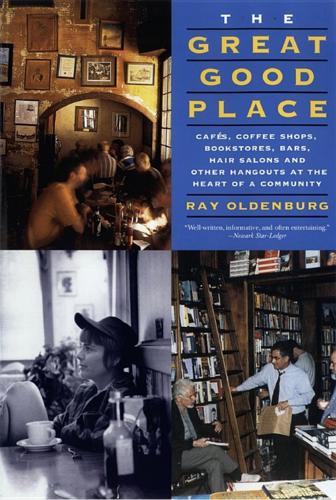
The Great Good Place: Cafes, Coffee Shops, Bookstores, Bars, Hair Salons, and Other Hangouts at the Heart of a Community
by
Ray Oldenburg
Published 17 Aug 1999
My recommendations for additional reading are subjective and incomplete. They consist of the men and women who have had most influence on me and whose books, regardless of publication date, seem to me to have great contemporary relevance. I could start with none other than Jane Jacobs’ The Death and Life of Great American Cities. For all the consternation she caused within architectural and planning circles, she has done a tremendous service for us all. One marvels at both the depth and quantity of her insights. Well within the Jacobs’ tradition and appearing the same year as my contribution was Roberta Gratz’s The Living City.
…
Joseph Addison, The Spectator, no. 9 (Saturday, 10 March 1711). 2. Joseph Wechsberg, “The Viennese Coffee House: A Romantic Institution,” Gourmet 12:16, 1966. 3. Carl Bode, The Young Mencken (New York: The Dial Press, 1973), 197. 4. Richard Sennett, The Fall of Public Man (New York: Alfred A. Knopf, 1977), 311. 5. Jane Jacobs, The Death and Life of Great American Cities (New York: Random House, 1961), 55. 6. Ibid. 7. O.E.D. Noun definition no. 2. 8. Robert J. Allen, The Clubs of Augustan London (Hamden, Conn.: Archon Books, 1967), 14. 9. Georg Simmel, in On Individual and Social Forms, ed. Donald N. Levine (Chicago: The University of Chicago Press, 1971), Chapter 9. 10.
…
Lawrence Fellows, “Psychologists’ Report Finds New Towns in West Germany Boring to Children,” New York Times (9 May 1971). 9. William H. Whyte, The Last Landscape (New York: Doubleday and Company, 1968), 262. 10. W. F. Connell and E.E. Skilbeck, Growing Up in an Australian City: A Study of Adolescents in Sidney (Melbourne, Australia: ACER, 1957), Chapter 11. 11. Jane Jacobs, The Death and Life of Great American Cities (New York: Vintage Books, 1961), 79 ff. 12. Sidney Brower, “Streetfront and Sidewalk,” Landscape Architecture (July, 1973), 364–9. 13. Whyte, op. cit., Chapter 15. 14. Charles E. Little, Challenge of the Land (New York: Pergamon Press, 1968), 10–12. 15. William S. Kowinski, The Malling of America (New York: William Morrow and Company, 1985), 350. 16.
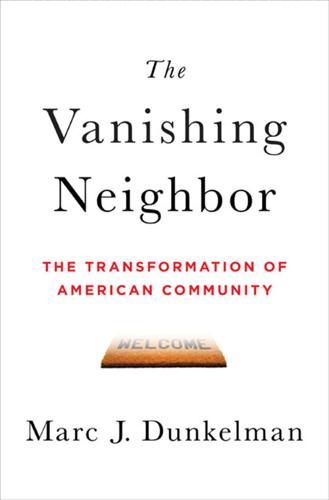
The Vanishing Neighbor: The Transformation of American Community
by
Marc J. Dunkelman
Published 3 Aug 2014
Richard Sennett (New York: Appleton-Century-Crofts, 1969). 14Daniel Okrent, Last Call: The Rise and Fall of Prohibition (New York: Scribner, 2010). 15Thomas Bender, Community and Social Change in America (Baltimore: Johns Hopkins University Press, 1978), 131–33. 16Hillary Rodham Clinton, It Takes a Village: And Other Lessons Children Teach Us (New York: Simon & Schuster, 1996). 17Wellman, “The Community Question,” 1201–31. 18Martin Gansberg, “Lindsay, Recalling the Genovese Murder, Deplores Apathy,” New York Times, October 13, 1965. 19Jim Rasenberger, “Kitty, 40 Years Later,” New York Times, February 8, 2004. 20Robert Nisbet, The Quest for Community (Wilmington, Del.: ISI Books, 1990), 72. 21Jane Jacobs, The Death and Life of Great American Cities (New York: Vintage, 1992), 121–40. 22Jacobs, The Death and Life of Great American Cities, 150–51. 23Claude S. Fischer, “Toward a Subcultural Theory of Urbanism,” American Journal of Sociology 80, no. 6 (May 1975). Chapter 7: Bands, Villages, and Tribes 1Robin I. M. Dunbar, “The Social Brain Hypothesis,” Evolutionary Anthropology 6 (1998): 178. 2Dunbar, “The Social Brain Hypothesis,” 178–90. 3Michael Harre, “Social Network Size Linked to Brain Size,” Scientific American, August 7, 2012. 4R.
…
The most successful shows came from teams that spliced familiar partners together with new blood. Success comes from compiling a group that includes a degree of both novelty and confidence, dynamism and familiarity.19 Jane Jacobs is unquestionably best known for the argument that framed The Death and Life of Great American Cities—namely, that neighborhoods, properly crafted, maintain an organic quality of their own. But Jacobs’s second book, The Economy of Cities, made a different claim—one that focused more squarely on the issue of creativity. Less than a decade after Arthur Koestler published his treatise on the foundations of innovation, Jacobs came to the remarkable conclusion that the process later termed the Medici effect was, in many cases, a phenomenon of everyday routines.

Obliquity: Why Our Goals Are Best Achieved Indirectly
by
John Kay
Published 30 Apr 2010
Kilgore, “Origin and History of Wildland Fire Use in the U.S. National Park System,” George Wright Forum 24, no. 3 (2007). 7 Le Corbusier, The Radiant City (London, Faber & Faber, 1964), p.154. 8 Robert A. Caro, The Power Broker: Robert Moses and the Fall of New York (New York, Vintage Books, 1975), p. 11. 9 Jane Jacobs, The Death and Life of Great American Cities (Harmondsworth, UK: Penguin, 1965), p. 350. 10 Louis Pasteur, 1854, quoted in Maurice B. Strauss, Familiar Medical Quotations (London: J & A Churchill, 1968), p. 108. Chapter 7: Muddling Through—Why Oblique Approaches Succeed 1 Charles Lindblom, “The Science of “Muddling Through,” Public Administration Review 19, no. 2 (1959), pp. 79–88. 2 H.
…
Essays: Moral, Political, Literary. 1777. Reprint, ed. Eugene F. Miller, Indianapolis: Liberty Classics, 1985. Hutton, Will. The World We’re In. London: Little, Brown, 2002. Huxley, Aldous. Brave New World. London: Chatto and Windus, 1932. ICI. “Annual Report.” 1990. ICI. “Annual Report.” 1997. Jacobs, Jane. The Death and Life of Great American Cities. Harmondsworth, UK: Penguin, 1965. Jencks, Charles. The Language of Post-Modern Architecture. London: Academy Editions, 1984. Jenkins, Roy. Churchill. London: Macmillan, 2001. JPMorgan and Reuters. RiskMetrics—Technical Document. 4th ed. New York: Morgan Guaranty Trust Company of New York, 1996.

You Are Here: Why We Can Find Our Way to the Moon, but Get Lost in the Mall
by
Colin Ellard
Published 6 Jul 2009
Nobody understood the importance of this difference better than Jane Jacobs, the urban visionary, activist, and writer who spent much of her life fighting modernist forces poised to reshape New York City and used her later years to exert similar powerful influences on Toronto, her adopted home. In her trailblazing book The Death and Life of Great American Cities—still current more than forty years after its initial publication—Jacobs offers a scathing indictment of the influence of modernist principles on urban design, but the more enduring contribution of this book is the collection of worldly wise prescriptions for designing livable, safe, and vibrant neighborhoods.
…
Girsberger’s Le Corbusier 1910-65 (Birkhäuser: Basel, 1999), which contains photographs of his works along with captions in three languages explaining his intentions. 3. Jane Jacobs condemns Le Corbusier’s mathematics, and some other aspects of his urban-planning principles, in the introductory chapter of her opus The Death and Life of Great American Cities, revised edition (Vintage: New York, 1992). 4. The quote from Oscar Newman comes from page 10 of his book Creating Defensible Space (Center for Urban Policy Research, U.S. Department of Housing and Urban Development: Washington, DC, 1996). 5. Christian Nold’s exploits can be found on his website, www.biomapping.net. 6.
…
His opinions on the influence of telecommunication technologies on the conduct of warfare are found in Desert Screen: War at the Speed of Light, translated by Michael Degener (Continuum: London, 2005). CHAPTER 11: GREENSPACE 1. Bruce Chatwin tells the story of accelerated songlines in his book The Songlines (Penguin: New York, 1988). 2. Jane Jacobs describes the origins of modern suburban living in the introductory chapter of her book The Death and Life of Great American Cities (Vintage: New York, 1992). 3. Mathis Wackernagel and William Rees, Our Ecological Footprint: Reducing Human Impact on the Earth (New Society Publishers: Gabriola Island, BC, 2001). 4. Details of Wilson’s life can be found in his book Naturalist (Shearwater Books: Washington, DC, 1996). 5.

Messy: The Power of Disorder to Transform Our Lives
by
Tim Harford
Published 3 Oct 2016
• • • If we are increasingly understanding that mess makes natural systems more healthy and resilient, then could the same be true for artificial systems, such as the neighborhoods, cities, and countries where we live? Jane Jacobs, the urban writer and campaigner, made the case for neighborhood diversity in The Death and Life of Great American Cities. She wrote of “the daily ballet of Hudson Street” in Greenwich Village, New York, where she lived. “We may fancifully call it the art form of the city and liken it to the dance,” she wrote. “Not to a simple-minded precision dance with everyone kicking up at the same time, twirling in unison and bowing off en masse, but to an intricate ballet in which the individual dancers and ensembles all have distinctive parts which miraculously reinforce each other.”12 Jacobs explained that it was the diversity of this urban ballet that made it work.
…
It was also made possible, Jacobs argued, by a mix of old and new buildings. She would not have been surprised by the story of Building 20, the low-status structure in the middle of high-status MIT that was home to so many intriguing experiments. It sounds not unlike a building she describes in The Death and Life of Great American Cities: The floor of the building in which this book is being written is occupied also by a health club with a gym, a firm of ecclesiastical decorators, an insurgent Democratic party reform club, a Liberal party political club, a music society, an accordionists’ association, a retired importer who sells maté [sic] by mail, a man who sells paper and who also takes care of shipping the maté, a dental laboratory, a studio for watercolor lessons, and a maker of costume jewelry.
…
Ed Yong, “There Is No ‘Healthy’ Microbiome,” The New York Times, November 1, 2014, http://www.nytimes.com/2014/11/02/opinion/sunday/there-is-no-healthy-microbiome.html, and Gabrielle Canon, “Sorry, Your Gut Bacteria Are Not the Answer to All Your Health Problems,” Mother Jones, October 27, 2014, http://www.motherjones.com/environment/2014/10/microbiome-health-gut-bacteria; Blaser, Missing Microbes, pp. 31–32. 12. Jane Jacobs, The Death and Life of Great American Cities (New York: Vintage, 1992), p. 50. 13. Ibid., p. 193. 14. Maryann P. Feldman and David B. Audretsch, “Innovation in Cities: Science-Based Diversity, Specialization and Localized Competition,” European Economic Review 43 (1999). 15. AnnaLee Saxenian, Regional Advantage: Culture and Competition in Silicon Valley and Route 128 (Cambridge: Harvard University Press, 1994). 16.

Streetfight: Handbook for an Urban Revolution
by
Janette Sadik-Khan
Published 8 Mar 2016
And as the myths about the Jacobs/Moses battles and competing visions for cities have deepened, they haven’t always taught us the right lessons about how to make our streets and cities better. A native of Scranton, Pennsylvania, Jane Jacobs moved to Depression-era New York City and emerged as an unlikely urban visionary in her adopted West Village neighborhood. Her signature work, The Death and Life of Great American Cities (1961), was an urban revelation, declaring in accessible language how a city’s design can nourish or destroy its quality of human life. She blasted the urban planners of the first half of the twentieth century for “urban renewal” programs that destroyed old buildings—and the neighborhoods with them—in the name of progress and for building in their place cold, sterile high-rises set back on superblocks, sucking life away from the street.
…
In July 2014, seven months after I stepped down as transportation commissioner when a new mayor came into office, a work team from New York City’s Department of Transportation added a footnote to Manhattan’s urban history: working with thermoplastic paint and concrete, the crew striped and heat-stenciled a parking-protected bike path directly in front of 555 Hudson Street in Greenwich Village, the former home of Jane Jacobs. Jane’s Lane, a protected bike path in front of Jane Jacobs’s former home at 555 Hudson Street, Manhattan, arrived fifty-three years after the publication of The Death and Life of Great American Cities. Seth Solomonow The design of the bike path, now running alongside the curb, protected by the line of parked cars on the other side, wasn’t new to Manhattan’s streets. The lane connected Hudson Street with an existing bike path built six years earlier just north of Jane’s three-story, red-brick home.
…
“outside of the Gaza Strip”: Natalie O’Neill, “The Prospect Park West Bike Lane Had Our Presses Rolling All Year Long,” The Brooklyn Paper, December 30, 2011, accessed August 10, 2015, www.brooklynpaper.com/stories/34/52/all_year_bikelane_2011_12_30_bk.html. “Ballet of Hudson Street”: Jane Jacobs, The Death and Life of Great American Cities (New York: Random House, 2009), 52. “eyes on the street”: Ibid., 35. “public life may grow”: Ibid., 72. “that we must fit our plans”: Jane Jacobs, “Downtown Is for People,” Fortune, 1958, accessed August 5, 2015, http://fortune.com/2011/09/18/downtown-is-for-people-fortune-classic-1958/.
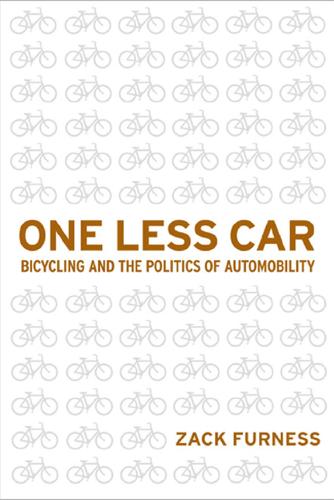
One Less Car: Bicycling and the Politics of Automobility
by
Zack Furness
and
Zachary Mooradian Furness
Published 28 Mar 2010
as Kenneth T. Jackson points out in Crabgrass Frontier, the panel that Eisenhower assembled to take stock of the country’s highway requirements was chaired by lucius D. Clay, a board member of General Motors (249). For a classic critique of postwar urban planning, see Jane Jacobs, The Death and Life of Great American Cities (new york: random House, 1961). For a detailed and critical engagement with robert Moses’s life and works, see robert a. Caro, The Power Broker: Robert Moses and the Fall of New York (new york: vintage Books, 1975). The financial model for state-federal collaboration on highway projects began with the Federal-aid road act in 1916 and was further solidified with the passage of the Federal Highway act of 1921.
…
(new york: Harcourt, 1961); The Urban Prospect (london: Secker and Warburg, 1968); The Highway and the City (Westport, CT: Greenwood press, 1981). lewis Mumford, quoted in the segment “The City: Cars or people?” from The City—Heaven and Hell (national Film Board of Canada, 1963), Film. Emphasis is my own. Jacobs, The Death and Life of Great American Cities, 7. Guy Debord, “Situationist Theses on Traffic,” in Situationist International Anthology, ed. Ken Knabb (Berkeley, Ca: Bureau of public Secrets, 1981), 57 (originally published in Internationale Situationniste, no. 3 [December 1959]). Guy Debord, The Society of the Spectacle, trans.
…
For contrasting perspectives on aT, see andrew Kirk, “appropriating Technology: The Whole Earth Catalog and Counterculture Environmental politics,” Environmental History 7, no. 4 (2001): 374–394; Kleiman, “The appropriate Technology Movement in american political Culture,” esp. 296–400 (on the political economy of aT). Jacobs, The Death and Life of Great American Cities, 370. Emphasis is my own. McCorkell, personal correspondence. J. B. Corgel and C.F. Floyd, “Towards a new Direction in Bicycle Transportation policy,” Transportation Quarterly 33, no. 2 (1979): 297–301. Quoted in Bruce Epperson, “Bicycle planning: Growing up or Growing Old,” Race, Poverty and the Environment 6 (Special issue: Transportation and Social Justice), no. 1 (1995): 42.
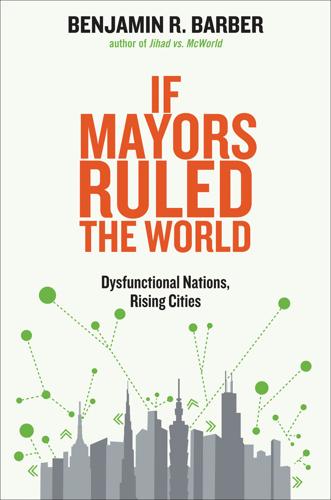
If Mayors Ruled the World: Dysfunctional Nations, Rising Cities
by
Benjamin R. Barber
Published 5 Nov 2013
That would be a boon to any global metropolis. In a developing world megacity in Africa like Lagos, it is—let’s not be patronizing and call it a miracle—a genuine blessing. CHAPTER 8. CITY, CURE THYSELF! Mitigating Inequality Lively, diverse, intense cities contain the seeds of their own regeneration. Jane Jacobs, The Death and Life of Great American Cities We need to make sure that we’re building . . . neighborhoods that are mixed, where people from different backgrounds, ethnicities, and particularly income levels can live in the same neighborhoods. . . . Social inclusion . . . can go a long way in reducing inequality. Mayor Naheed Nenshi, Calgary If you fix cities, you kind of fix the world.
…
Bender, Urban Vision, p. 17, citing Mumford’s perspective in The Golden Day and The Brown Decades. 39. Cited by Bender, Urban Vision, p. 13. 40. Frederick Law Olmsted, Civilizing American Cities: Writings on City Landscapes, ed. S. B. Sutton, New York: De Capo Press, 1997, p. 75. 41. Jane Jacobs, The Death and Life of Great American Cities, New York: Vintage Press, 1992, p. 61. 42. For a riveting account of this history with revealing maps, see Hilary Ballon, ed., The Greatest Grid: The Master Plan of Manhattan 1811–2011, New York: Museum of the City of New York and Columbia University Press, 2012. 43. Cited in Ballon, ed., Greatest Grid, p. 103. 44.
…
Like Stirner (see The Ego and Its Own: The Case of the Individual Against Authority, London: Rebel Press, 1993) or Nietzsche, Ayn Rand espouses a radical individualism hostile to community altogether, whether central or local. 7. Max Weber, The City, Glencoe, IL: Free Press, 1985; Lewis Mumford, The City in History, New York: Harcourt, Brace and World, Inc., 1961; Jane Jacobs, The Death and Life of Great American Cities, New York: Vintage Press, 1992; Peter Marcuse and Ronald van Kemper, eds., Globalizing Cities: A New Spatial Order, Oxford: Blackwell Publishing, 2000; Saskia Sassen, The Global City: New York, London, Tokyo; and Eric Corijn, “Urbanity as a Political Project.” 8. See, for example, Berthold Brecht’s play In the Jungle of Cities. 9.
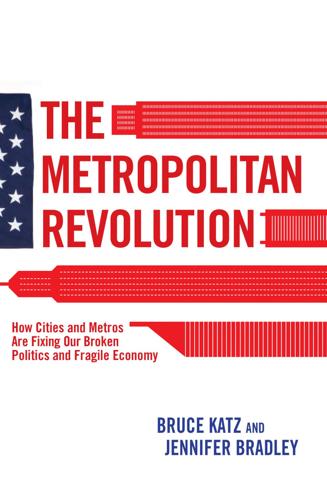
The Metropolitan Revolution: How Cities and Metros Are Fixing Our Broken Politics and Fragile Economy
by
Bruce Katz
and
Jennifer Bradley
Published 10 Jun 2013
We don’t share a past, we share a future.”69 05-2151-2 ch5.indd 109 5/20/13 6:52 PM 05-2151-2 ch5.indd 110 5/20/13 6:52 PM II THE FUTURE OF THE PA R T METROPOLITAN REVOLUTION Ushering in the Metro Age 06-2151-2 ch6.indd 111 5/20/13 6:53 PM 06-2151-2 ch6.indd 112 5/20/13 6:53 PM 6 TH E RI S E O F IN N O V AT I O N D I ST RI C T S People gathered in concentrations of city size and density can be considered a positive good . . . because they are the source of immense vitality, and because they do represent, in small geographic compass, a great and exuberant richness of differences and possibilities, many of these differences unique and unpredictable and all the more valuable because they are. —JANE JACOBS, The Death and Life of Great American Cities The American metropolitan revolution, although nascent and evolving, is already inventing new models of economic development (as seen in the Applied Sciences initiative), new approaches to social integration (Neighborhood Centers), and new levels of collaboration (as in Northeast Ohio and Denver).
…
v=AjUCt07ZIBkO). 69. Angela Blanchard, “The First New Question?” presentation at TEDxHouston, 2011 (www.youtube.com/watch?v=XU_vVt298gw). 10-2151-2 notes.indd 226 5/20/13 7:00 PM NOTES TO PAGES 114–18 227 CHAPTER 6 The quotation at the beginning of the chapter comes from Jane Jacobs, The Death and Life of Great American Cities (New York: Vintage Books, 1992), pp. 220–21. 1. Innovation district is a relatively new term just beginning to gain currency among political, business, and civic leaders focused on innovation-led economic development in the relatively small geographies of their cities and metros.
…
John Roach, “Young Americans Geographically Illiterate, Survey Suggests,” National Geographic News, May 2, 2006. 21. David Skorton and Glenn Altschuler, “America’s Foreign Language Deficit,” Forbes, August 27, 2012. 22. McKinsey and Company, “Winning the $30 Trillion Decathlon: Going for Gold in Emerging Markets” (2012), pp. 9–10. 23. Jane Jacobs, The Death and Life of Great American Cities (New York: Vintage Books, 1992), p. 340. 24. Berube and Parilla, Metro Trade, p. 2. 25. Istrate and Nadeau, “Global MetroMonitor Interative” (Milwaukee, Mumbai), Brookings. 26. Shirish Sankhe and others, “India’s Urban Awakening: Building Inclusive Cities, Sustaining Economic Growth” (McKinsey Global Institute, 2010). 27.

#Republic: Divided Democracy in the Age of Social Media
by
Cass R. Sunstein
Published 7 Mar 2017
A world of limitless choices is incalculably better than that. But if people are sorting themselves into communities of like-minded types, their own freedom is at risk. They are living in a prison of their own design. DEATH AND LIFE Let me now disclose a central inspiration for this book, one that might seem far afield: The Death and Life of Great American Cities by Jane Jacobs.8 Among many other things, Jacobs offers an elaborate tribute to the sheer diversity of cities—to public spaces in which visitors encounter a range of people and practices that they could have barely imagined, and that they could not possibly have chosen in advance.
…
The result can be cybercascades of a highly undesirable sort, as false information spreads to thousands or even millions. We have seen evidence to this effect most vividly for terrorist organizations, but the point is far more general than that. Most broadly, recall Jacobs’s remarkable prose-poem, The Death and Life of Great American Cities, celebrating serendipity, surprise, and unchosen encounters. Can social media be like Paris, Berlin, or San Francisco? Probably not. But they can certainly move in that direction. Second, a system of unlimited filtering could produce too little in the way of shared information and experiences.
…
Sunstein, Infotopia: How Many Minds Produce Knowledge (Oxford: Oxford University Press, 2006). 5.Shanto Iyengar, Gaurav Sood, and Yphtach Lelkes, “Affect, Not Ideology: A Social Identity Perspective on Polarization,” Public Opinion Quarterly 76, no. 3 (2012): 405, http://pcl.stanford.edu/research/2012/iyengar-poq-affect-not-ideology.pdf (accessed August 29, 2016). 6.Ibid. 7.See Shanto Iyengar and Sean J. Westwood, “Fear and Loathing across Party Lines: New Evidence on Group Polarization,” American Journal of Political Science 59, no. 3 (2015): 690. 8.Jane Jacobs, The Death and Life of Great American Cities (1961; repr., New York: Random House, 1993). 9.Ibid., 81, 95. 10.Putnam, Bowling Alone, 178. 11.See Robert Glenn Howard, “Sustainability and Narrative Plasticity in Online Apocalyptic Discourse after September 11, 2001,” Journal of Media and Religion 5, no. 1 (2006): 25. 12.Adam Mosseri, “Building a Better News Feed for You,” Facebook Newsroom, June 29, 2016, https://newsroom.fb.com/news/2016/06/building-a-better-news-feed-for-you/ (accessed August 29, 2016). 13.Adam D.
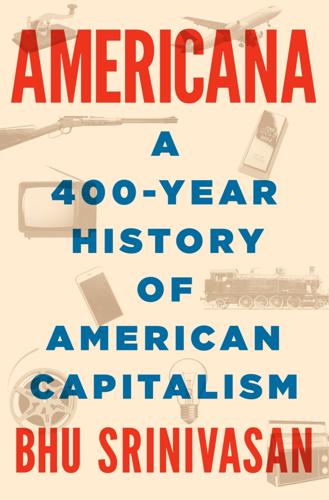
Americana: A 400-Year History of American Capitalism
by
Bhu Srinivasan
Published 25 Sep 2017
Some saw this affluence as a form of hollow prosperity, a mindless and fundamental alteration of society, where people served the economic engine, moved by the momentum of commercial events, rather than the other way around. To Jane Jacobs the evidence suggested that the cultural vibrancy of the city was being lost to remote, metallic islands traveling at seventy miles per hour. At the time of her book The Death and Life of Great American Cities, reflecting the move to the suburbs, the urban core of nearly every American city had started declining. Cities in the East and Midwest had once been bustling centers of activity, but the idea of the city would come to be associated with decay. To Jacobs nothing about this death of her beloved cities was “economically or socially inevitable” due to market forces.
…
Sears and Montgomery Ward: Sears, Roebuck and Co., Sears Modern Homes Catalogue (New York: Dover, 2006). “identical piles of”: “Housing: Up from the Potato Fields.” “Pricing each home identically”: “Nation’s Biggest Housebuilder.” social and cultural critics: Jane Jacobs, The Death and Life of Great American Cities (New York: Vintage Books, 1992); Herbert J. Gans, The Levittowners: Ways of Life and Politics in a New Suburban Community (New York: Columbia University Press, 1982). “neither the urbanity”: Jackson, Crabgrass Frontier, 244. “proud country home-owners”: Levitt, “Let’s Build Up.” 700,000 immigrants arrived: Bureau of the Census, “Historical Statistics of the United States, 1789–1945,” Washington DC, 1949, series B 304–330 (Immigration—Immigrants by Country: 1820 to 1945), 32.
…
The “loss-leader”: Walter Henry Nelson, The Great Discount Delusion (New York: David McKay, 1965), 17. the loss-leading practices: Ibid., 68. populations as small: Sam Walton, Sam Walton: Made in America (New York: Bantam, 1993), 59. “or socially inevitable”: Jane Jacobs, The Death and Life of Great American Cities (New York: Vintage Books, 1992), 7. producer of oil: Michael Ratner and Carol Glover, “U.S. Energy: Overview and Key Statistics,” Congressional Research Service, July 27, 2014. running trade deficits: Bureau of the Census, “Historical Statistics of the United States, Colonial Times to 1970,” Washington DC, September 1975, series U 1–25 (Balance of International Payments: 1790 to 1970), 864.

Americana
by
Bhu Srinivasan
Some saw this affluence as a form of hollow prosperity, a mindless and fundamental alteration of society, where people served the economic engine, moved by the momentum of commercial events, rather than the other way around. To Jane Jacobs the evidence suggested that the cultural vibrancy of the city was being lost to remote, metallic islands traveling at seventy miles per hour. At the time of her book The Death and Life of Great American Cities, reflecting the move to the suburbs, the urban core of nearly every American city had started declining. Cities in the East and Midwest had once been bustling centers of activity, but the idea of the city would come to be associated with decay. To Jacobs nothing about this death of her beloved cities was “economically or socially inevitable” due to market forces.
…
Sears and Montgomery Ward: Sears, Roebuck and Co., Sears Modern Homes Catalogue (New York: Dover, 2006). “identical piles of”: “Housing: Up from the Potato Fields.” “Pricing each home identically”: “Nation’s Biggest Housebuilder.” social and cultural critics: Jane Jacobs, The Death and Life of Great American Cities (New York: Vintage Books, 1992); Herbert J. Gans, The Levittowners: Ways of Life and Politics in a New Suburban Community (New York: Columbia University Press, 1982). “neither the urbanity”: Jackson, Crabgrass Frontier, 244. “proud country home-owners”: Levitt, “Let’s Build Up.” 700,000 immigrants arrived: Bureau of the Census, “Historical Statistics of the United States, 1789–1945,” Washington DC, 1949, series B 304–330 (Immigration—Immigrants by Country: 1820 to 1945), 32.
…
The “loss-leader”: Walter Henry Nelson, The Great Discount Delusion (New York: David McKay, 1965), 17. the loss-leading practices: Ibid., 68. populations as small: Sam Walton, Sam Walton: Made in America (New York: Bantam, 1993), 59. “or socially inevitable”: Jane Jacobs, The Death and Life of Great American Cities (New York: Vintage Books, 1992), 7. producer of oil: Michael Ratner and Carol Glover, “U.S. Energy: Overview and Key Statistics,” Congressional Research Service, July 27, 2014. running trade deficits: Bureau of the Census, “Historical Statistics of the United States, Colonial Times to 1970,” Washington DC, September 1975, series U 1–25 (Balance of International Payments: 1790 to 1970), 864.
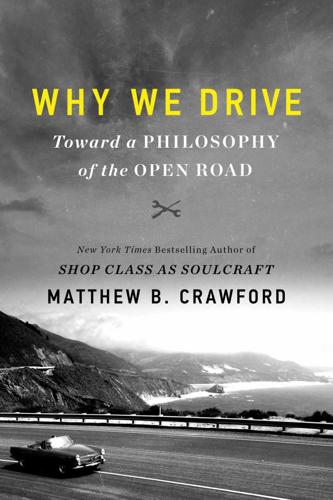
Why We Drive: Toward a Philosophy of the Open Road
by
Matthew B. Crawford
Published 8 Jun 2020
I will insist, on the contrary, that democracy remains viable only if we are willing to extend to one another a presumption of individual competence. This is what social trust is built on. Together, they are the minimal endowments for a free, responsible, fully awake people. Cars and the Common Good In her 1961 masterwork The Death and Life of Great American Cities, Jane Jacobs noted that “everyone who values cities is disturbed by automobiles.” They seem to stretch and rend the fabric of social interaction, which requires a certain intimacy of scale and fluidity of movement. To make way for cars and all that comes with them, such as parking lots, gas stations, and major arteries, “city streets are broken down into loose sprawls, incoherent and vacuous for anyone afoot.”
…
Protesters in France have been throwing paving stones at the police, in a precise echo of the street battles in Paris early in the French Revolution. One truck driver wrote on his yellow vest, “France wake up! Stop being sheep.” CARS AND THE COMMON GOOD 1.This account is from H. B. Creswell, writing in the British journal Architectural Review, December 1958, as quoted by Jane Jacobs, The Death and Life of Great American Cities (New York: Vintage, 1992), pp. 341–342. 2.James J. Flink, The Automobile Age (Cambridge: MIT Press, 1988), p. 364. 3.See Dan Albert, Are We There Yet? The American Automobile Past, Present, and Driverless (New York: Norton, 2019), p. 100. 4.Flink, The Automobile Age, p. 364. 5.Albert, Are We There Yet?
…
Elizabeth and, 59–65 driver’s education, 62–63 effort-driven rewards, 64–65 inducing a conditioned response, 62–63 rat ergonomics and, 61–62 self-motion and, 59–60 skills vs. tasks, 60 tool use, 62–63 Croly, Herbert, 38, 138 crony capitalism, 90 cultural development, 65 Daimler, 304 Datsun 510, 80 David, Joe, 203 Davis, Joe, 19 death algorithm, 117 The Death and Life of Great American Cities (Jacobs), 35–36 deference to machines, 126 delegation, societal effect of, 119 demolition derby, 184–187. See also motor sports; soap box derby Department of Motor Vehicles experience, 213–214 digital Rust Belt, 290 dilemma zone, 219–220 dirt bike riding. See also motorcycles behind the Martin’s, 1–3 female riders, 192–194 hare scramble race, 191–193 distracted driving, 235 District of Columbia, 218, 222 DMV experience, 213–214 dogbox sequential transmission, 166 dogfights, aerial, 173–174 Dolgov, Dmitri, 105 dowel pins, 157–158 DPR Machine, 144 dragsters, 135–136.
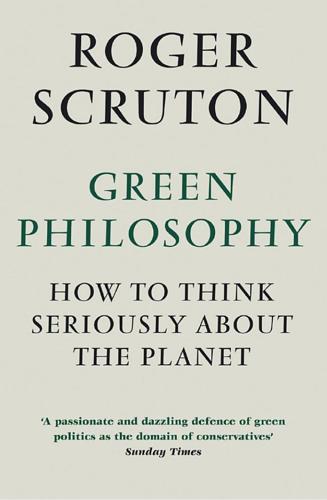
Green Philosophy: How to Think Seriously About the Planet
by
Roger Scruton
Published 30 Apr 2014
The Italian hilltop town of stone and tile is very unlike the Zulu village with its huts of mud and grass and its church of corrugated iron, but they both obey aesthetic constraints, in which individual differences are softened and made acceptable by a common style. Hence there has to be a place for aesthetic judgement in the creation of every human habitat, and most of all in the planning and building of cities. In a fêted work, The Death and Life of Great American Cities, published in 1961, Jane Jacobs argued that cities should develop spontaneously and organically, so as to enshrine in their contours the unintended results of the consensual transactions between their residents. Only then will they facilitate the peaceful evolution of urban life.
…
Sokal and Jean Bricmont, Fashionable Nonsense, London, 2003. 259 See Roger Scruton, Modern Culture, London, 2004. 260 Against the home and the family, Foucault, Laing, Esterson; against the nation, Pilger, Chomsky, Zinn. 261 Kant, Critique of Judgement, Oxford, 2008; Roger Scruton, Beauty, Oxford, 2009. 262 For more on this point, and on the concept of intrinsic value generally, see John O’Neill, ‘The Varieties of Intrinsic Value’, The Monist, 1992, in Keller, ed., op. cit., and also Krebs, Ethics of Nature, which explores the many ways in which we might discover and enjoy intrinsic values in nature. 263 This approach to value is second nature to economists, and ‘environmental economics’ has been subjected to severe criticism for this very reason by Sagoff, op. cit. 264 For some of the tendencies here see Krebs, Ethics of Nature. 265 See Martin Seel, Eine Ästhetik der Natur, Frankfurt, 1991. 266 See Scruton, Beauty. 267 Milan Kundera, The Unbearable Lightness of Being, New York, 1984. 268 See José Bové and François Dufour, The World is Not for Sale: Farmers Against Junk Food, London, 2001, and the websites of Slow Food International and Slow Food UK. 269 I defend this view in Art and Imagination, London, 1974, and Beauty. 270 Jane Jacobs, The Death and Life of Great American Cities, New York, 1961; Nicolai Oroussoff, ‘Outgrowing Jane Jacobs and Her New York’, New York Times, 30 April 2006. 271 Nathaniel Baum-Snow, ‘Changes in Transportation Infrastructure and Commuting Patterns in US Metropolitan Areas, 1960–2000’, American Economic Review: Papers and Proceedings, May 2010. 272 James Howard Kunstler, The Geography of Nowhere: The Rise and Decline of America’s Man-Made Landscape, New York, 1993, and The Long Emergency: Surviving the Converging Catastrophes of the Twenty-First Century, New York, 2005. 273 Joel Kotkin, The Next Hundred Million: America in 2050, New York, 2010. 274 Robert Bruegmann, Sprawl, Chicago, 2005.
…
Husserl, Edmund, Die Krisis der europäischen Wissenschaften und die transzendentale Phänomenologie: eine Einleitung in die phänomenologische Philosophie, 1954, The Hague, Martinus Nijhoff, reissued 1962. IPCC Report (2007): published by Cambridge University Press, available at www.ipcc.ch/pdf/assessment-report/ar$/wgl/ar4-wgl-spm.pdf. Jacobs, Jane, The Death and Life of Great American Cities, 1961, New York, Random House, reissued 2002. Jacoby, Henry D., Babiker, Mustafa H., Paltsev, Sergey, and Reilly, John M., ‘Sharing the Burden of GHG Reductions’, MIT Joint Program on the Science and Policy of Global Change, report no. 167, 2008. Jamieson, Dale, ‘The Ethics of Geo-Engineering’, People and Place, 1.2, 13 May 2009, www.peopleandplace.net/perspectives/2009/5/13/the_ethics_of_geoengineering/print.
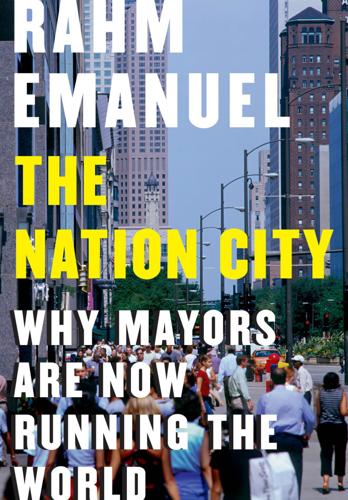
The Nation City: Why Mayors Are Now Running the World
by
Rahm Emanuel
Published 25 Feb 2020
Infrastructure and mass transit systems and other critical city services (like public education and policing) were some of the casualties. Our major cities had lower life expectancy rates than the country as a whole. It didn’t help that city planners from decades earlier had been misguided in some of their approaches. Jane Jacobs, in her 1961 book, The Death and Life of Great American Cities, wrote about one of the biggest problems cities faced: Most urban planning had been focused on business districts and not on building and strengthening the neighborhoods and communities that form the glue that holds cities together. It also didn’t help that some of the mayors of that period were not up to the task.
…
Fallows, Deborah, and James Fallows. Our Towns: A 100,000-Mile Journey into the Heart of America. Pantheon. New York. 2018. Glaeser, Edward. Triumph of the City: How Our Greatest Invention Makes Us Richer, Smarter, Greener, Healthier, and Happier. Penguin. New York. 2011. Jacobs, Jane. The Death and Life of Great American Cities. Random House. New York. 1961. Katz, Bruce, and Jeremy Nowak. The New Localism: How Cities Can Thrive in the Age of Populism. Brookings Institution Press. Washington, D.C. 2018. Quinones, Sam. Dreamland: The True Tale of America’s Opiate Epidemic. Bloomsbury. New York. 2015.
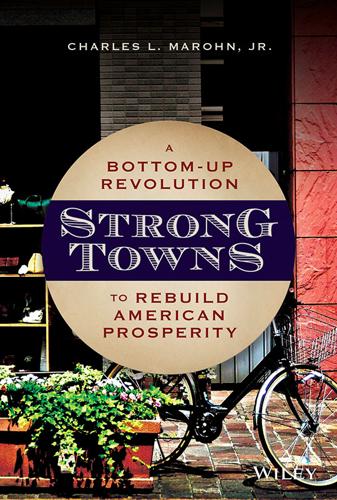
Strong Towns: A Bottom-Up Revolution to Rebuild American Prosperity
by
Charles L. Marohn, Jr.
Published 24 Sep 2019
These opposite rows of buildings were spaced at ratios comfortable to human beings. They were not so close as to feel constrained, but they were not so far that they failed to create an edge. Edges are very important for humans. In our habitats, we are drawn to edges. This is a phenomenon observed by Jane Jacobs in her book The Death and Life of Great American Cities, then elaborated on by Christopher Alexander in A Pattern Language. In public spaces, Jacobs notes that people “stay to the sides,” while Alexander states that people “naturally gravitate toward the edge.” This street in Pompeii provided that opportunity. Biologists call this wall-hugging trait thigmotaxis.
…
Index A Accounting, for infrastructure, 70–71 Acre, value per, 135, 138–142 Alexander, Christopher, 8 Altruism, in community living, 6–7, 26 American Society of Civil Engineers (ASCE), 65–67 Amish society, 217 Anderson, Monte, 160–161 Antifragile (Taleb), 193 Anti-fragile systems, 4, 6 Appreciation, for maintenance staff, 180–183 Arnade, Chris, 214–215 ASCE (American Society of Civil Engineers), 65–67 Assessment process, 77 Automobile reliance: development based on, 27–30 and modern city development, 111–112 productivity and, 140 B Barbell investment approach, 148–150, 150f Better Block Foundation, 159 Bezos, Jeff, 102 Bias, confirmation, 69, 74, 183–186 Bicycles, 112 Big box stores: alternative uses of sites of, 169 productivity for, 136–137 Big project mentality, 184–186 The Big Sort (Bishop), 207–208 “Bipartisan Placemaking: Reaching Conservatives” panel, 210 Bishop, Bill, 207–208 The Black Swan (Taleb), 59, 120 Blighted areas, productivity of, 131–134, 140 Boise State University, 126 Boys & Girls Club of Santa Ana, x Brainerd, Minnesota, 16f, 18f development of infrastructure in, 30–31 experimental development pattern in, 125–126 founding and development of, 16–17 productivity at downtown vs. edge of town, 134–138 traditional vs. modern development in, 131–134 Bretton Woods agreement, 90 Brooklyn, New York, 213–214 Brown, Aaron, 211 Brown, Michael, 114 Budgeting, by cities, 50–57 Building code deficiencies, addressing, 194 Buildings, complex vs. complicated, 20–23 Bureaucracy, 172 Burnham, Daniel, 122 Bush, George W., 209 C California, government decision making in, 197–198 Capital investments, return on, 171–172 Carbon-reduction benefits, 74 Carlson, Curtis, 121 “Carlson's Law,” 121 Cash flow: and debt, 98, 187–192, 188f–190f over life cycle of development project, 52–57, 55f, 56f CBO (Congressional Budget Office), 78–80 Centralization, 198 Chaos, order vs., 121–122 Chicken problem, 195 Cities, 37–62 abandonment of, 109–110 accounting for infrastructure by, 70–71 budgeting and growth in, 50–57 contracting of, 154 Detroit, Michigan, 60–62 development of Pompeii, Italy, 5–10 economic stability of modern, 104–106 engineer's view of, 11 experimental development pattern in, 126–127 filling gaps in, 160–163 and illusion of wealth, 57–60 incremental growth in founding of, 15–20 as infinite game, 38–41 and infrastructure, 44–50 maintenance required for infrastructure in, 115 modern development of, 12 revenues and expenses, 41–44 traditional vs. modern development of, 1–3 Cities and the Wealth of a Nation (Jacobs), 101–102 City Council of Santa Ana, ix, x City engineer, 177t City halls, 43–44 City planner, 177t Class: and neighborhoods, 21–22 and re-urbanization, 116 Clinton, Bill, 209 Clinton, Hillary, 63 Cognitive Architecture (Sussman and Hollander), 8 Cognitive discounting, 65 Collaboration, between government officials and citizens, 195–197 Commers, Jon, 45 Common infrastructure, 130 Community living, 199–218 differing opinions in, 206–212 and extended family, 200–201 as infinite game, 39–40 meaning in, 212–218 in neighborhoods, 202–203 in Pompeii, Italy, 6–7 walking in, 203–206 Complex, adaptive systems: human habitats as, 3–4 and incremental growth, 168 incremental growth of, 15–16, 18–19 rational decision making with, 120–123 Complex buildings, 20–23 Complicated buildings, 20–23 Complicated systems, 11–14 Confirmation bias, 69, 74, 183–186 Conflicts, dealing with, 206–212 Congress for the New Urbanism, 210 Congressional Budget Office (CBO), 78–80 Constraints: and economic stability, 93–96 and gold standard, 90 growth as, 100 prudent, for investments, 164–168 removal of, in modern world, 59–60, 96 Construction costs, 136–137 Consumption, 215–216 Costa Rica, 126–127 The Crash Course (Martenson), 108 Critical systems, 182–183 Cross-generational civic collaboration, 187 D Dallas, Texas, 159 Darwin, Charles, 8 The Death and Life of Great American Cities (Jacobs), 8 Debt: and cash flow, 98 for federal government, 186 for government, 96–100 for local government, 113–114 for place-oriented government, 186–192 for projects with quality-of-life benefits, 187 for state government, 113–114 Debt to income ratio, 97 Decision making: rational, see Rational decision making subsidiarity in, 195–198 Default, on municipal debt, 191 Deneen, Patrick, 211 Density, as urban planning metric, 128–129 Depression economics, 86–89 Detroit, Michigan, 60–62 land values in, 24 renewal of urban, 117–119 Development projects: cash flow over life cycle of, 52–57, 53f, 55f, 56f decisions about failing, 115–120 Diamond, Jared, 58, 59, 84 Dig Deep, 211 Donjek, 45 Downtown, productivity of, 134–140, 139t, 143–144 Duany, Andres, 195 Duggan, Mike, 119 Duncanville, Texas, 160 E Economic development department, 178t Economics: and benefits of infrastructure spending, 72–73 in depressions, 86–89 Economic stability, 83–106 and auto-oriented development, 29–30 and constraints, 93–96 creating, 85–86 and depression economics, 86–89 and focus on growth, 100–102 following World War II, 89–91 and government debt, 96–100 growth vs. wealth, 102–104 of modern cities, 104–106 and post-war boom, 91–93 risk management strategies for, 83–85 Edges, 7–8 Edges of city: center vs., 28 city infrastructure necessary for, 115 productivity of, 134–138, 143–144 Efficiency, designing for, 174–176 Ehrenhalt, Alan, 116 Empire State Building (New York, New York), 129 Employment, in productive places, 133 England, 83 Expenses, and revenues, 41–44 Extended family, 200–201 F Failure, slow, 110–115 Failure to Act (ASCE report), 65–67 Family, extended, 200–201 Fannie Mae, 92 Farmers, risk management strategies of, 83–84 Federal Funds Rate, 97 Federal government: debt for, 186 impact of infrastructure on, 79 Federal Housing Administration (FHA), 89, 92 Federal Reserve, 99 Feedback, in local governments, 173–174 Ferguson, Missouri, 93, 114 FHA (Federal Housing Administration), 89 Financial status, local government's understanding of, 190–191 Finished states, neighborhoods built to, 21–23 “First ring” suburbs, 94 Form-based codes, 193–194 Fragile systems, 4 Franchises, productivity of, 133–134 Freddie Mac, 92 Future, predicting needs for, 19–20, 120–121 G Gaps, in cities, 160–163 Garcia, Anthony, 158 Gas tax, 75 Gawron, Stephen, 161 Gehl, Jan, 8 “General Theory of Walkability,” 206 Gentrification, of urban neighborhoods, 117 Goals, of individuals vs. communities, 40–41 Goland, Carol, 84 Gold reserves, 94 Gold standard, as basis for trade, 90 Government debt, 96–100 Government policies, prioritizing traffic, 29 Great Depression, 87–89, 191 The Great Inversion and the Future of the American City (Ehrenhalt), 116 Great Society, 93 Growth: economic stability and focus on, 100–102 in municipalities, 50–57 as objective of local governments, 176 wealth vs., 102–104 H Haidt, Jonathan, 208, 209, 215 Hardship, response to, 172–174 Hasidic Judaism, 213–214, 217 Hemingway, Ernest, 4 Henwood, Doug, 79 Hierarchies, in local government, 174–176 Highland neighborhood (Shreveport, Louisiana), 220 Highland Park (Shreveport, Louisiana), 220 High land values, 27–30 High Point, North Carolina, 161 Highway bypass corridor, 134–138 Hollander, Justin B., 8, 9 Homeless shelters, xi Homes, changing, 20 Hoover, Herbert, 87 Horizontal expansion, in California, 197 Housing: in California, 197–198 post-war changes in, 92 preference for single-family, 144–145 Housing authority, 178t How to Live in a World We Don't Understand (Taleb), 59 Human habitats, 1–14 as complex, adaptive systems, 3–4 in North America, 1–3 spooky wisdom in, 5–10 as systems that are complicated, 11–14 Hunter-gatherer existence, 58 Hurricane Katrina, 102–103 Hurricane Rita, 102–103 I Illusion of Wealth: and constant maintenance, 152 human response to, 57–60 Illusion of Wealth phase of development, 143 Improvement to Land (I/L) Ratio, 25, 25f, 117 Improvement value, 23–25, 25f Incentives, to fix problems, 113 Income taxes, 72 Incremental changes, implementing, 122–123, 156–157 Incremental growth, 15–35 and complex, adaptive systems, 168 complex vs. complicated buildings in, 20–23 constraints on, 164 and founding of cities, 15–20 good and bad development in, 34–35 and high land values, 27–30 and neighborhood renewal, 23–27 private and public investment in, 30–34 in traditional habitat development, 2 Infill projects, 160 Infrastructure, 63–81 accounting for, 70–71 and American Society of Civil Engineers, 65–67 calculating returns on investment for, 67–69 Congressional Budget Office on, 78–80 development of, 30–34 as investment, 41–42 in modern development, 32 and municipalities, 44–50 perception of need for more, 63–65 ratio of private to public investment in, 129–130 real return on investment, 74–78 secondary effects of, 72–74 Infrastructure Cult: development of, 65–67 paper returns calculated by, 69 Insolvency, 187–192 Interstate highway system, 92 Investment(s), 147–170 barbell investment approach, 148–150 capital, 171–172 conventional vs. strong towns thinking about, 185–186, 186t in filling gaps in cities, 160–163 impact of regulations on, 194 infrastructure as, 41–42 little bets, 150–160 low-risk investments with steady returns, 150–155 prudent constraints for, 164–168 public and private, 30–34, 31f, 32f returns on, see Return on investment in Suburban Retrofit, 168–169 Italy, walking in, 203–204 J Jacobs, Jane, 8, 101–102 Japan, 76 Jimmy's Pizza, 161–162 Job creation, 49, 72–73 Johnson, Neil, 12, 13 Junger, Sebastian, 216–217 K Keynes, John Maynard, 88 Keynesian economic policies, 88 Krugman, Paul, 63, 78 Kunstler, James, 110–111 L Lafayette, Louisiana, 101, 141–144, 151 Landau, Moshe, 213–214, 217 Land value: in declining suburbs, 113 and interstate highway project, 92 and neighborhood renewal, 23–25, 25f in neighborhoods with different types of properties, 165–167, 165f, 166f and suburban development, 27–30 Learning, from previous local investments, 187 Legacy programs, 173 Lifestyle choices, 202, 205–206 “Lifestyle enclaves,” 208 Little bets, 16–18, 150–160 Local economy: as basis for national economy, 101–102 national vs., 103 Local government: changes in, to maintain economic stability, 105–106 debt taken on by, 113–114 funded by state government, 95 impact of infrastructure on, 79–80 profit run by, 37–38, 147 relationship of state and, 198 Long declines, 110–115 “Long emergency,” 110–111 Long Recession of the 1870s, 77 Los Angeles, California, xi Lovable places, 10 Low-risk investments, with steady returns, 150–155 Lydon, Mike, 158 M Maintenance: ability to keep up with, 109 cash-flow debt to cover, 188–192, 188f–190f of development projects, 52–57 of infrastructure, 46–49 need for constant, 151–154 in place-oriented government, 180–183 required for single-family homes, 112 Maintenance department, 179t Manhattan, New York, 24 Martenson, Chris, 108 Meaning, life of, 212–218 Middle class, 92, 93, 144–145 Milan, Italy, 164 Mills Fleet Farm, 134–137 Minicozzi, Joseph, 138–140, 161 “Minnesota Miracle,” 95 Mixed-use neighborhoods, 163, 169 Modern city development: as high-risk investments, 149 as lead by pubic investment, 34–35 productive places in, 131–134 Modern Monetary Theory, 99 Mortgages, during Great Depression, 88–89 Mouzon, Steve, 10, 113 Muskegon, Michigan, 161 N National Association of Home Builders, 136 National economy, local vs., 103 Natural disasters, 102–103 Neighborhoods: abandonment of, 109–110 built to finished states, 21–23 changing in post-war era, 92–93 community living in, 202–203 decline of, 113 gentrification of urban, 117 mixed-use, 163, 169 renewal of, and incremental growth, 23–27 responses to improvements in, 158 structured around religions, 214 in transition sections of Detroit, 118 Neighbors, being involved with, 202–203 New Deal economics, 87–88 New Orleans, Louisiana, 102, 182 Nixon, Richard, 94 Noncritical systems, 182 O Oak Cliff neighborhood (Dallas, Texas), 159 Obama, Barack, 63 Obesity, among Pacific Islanders, 58–59 Options Real Estate, 160 Orange County, California, xi–xii Order, chaos vs., 121–122 The Original Green (Mouzon), 10, 113 Oroville dam (California), 182 Oswego, New York, 152 Oswego Renaissance Association, 152 P Pacific Islanders, 58–59, 183–185 Paper returns on investment, 67–69 Paradox of Avarice, 104 Paradox of Thrift, 88, 104 Pareidolia, 8–9, 9f Parks department, 178t Party analogy, 34–35 A Pattern Language (Alexander), 8 Pension funds, 56–57, 70, 98 Pequot Lakes, Minnesota, 44–46 Perception, of need for more infrastructure, 63–65 Personal preferences, 144–145 Peru, 84 Place-oriented government, 171–198 and confirmation bias, 183–186 designed for efficiency, 174–176 focus on broad wealth creation by, 176–180 maintenance as priority for, 180–183 and regulations, 192–194 response to hardship by, 172–174 subsidiarity in, 195–198 understanding of debt by, 186–192 Political differences, 207 Pompeii, Italy, 5–10 Post-war boom: and economic stability, 91–93 modern city development established in, 12 Power, subsidiarity principle and, 196–198 Prayer of Saint Francis, 218 Prioritization, of maintenance, 180–183 Private development, 40 Private investment: private to public investment ratio, 129–130 public and, 30–34, 31f, 32f Private sector (businesses): response to economic hardship in, 172–173 small, see Small businesses Problem solving, 13–14 Productive places, 125–146 downtown vs. edge of town, 134–138 in past, 125–127 and personal preferences, 144–145 productivity calculations for, 128–130 return on investment, 141–144 traditional vs. modern development in, 131–134 value per acre, 138–141 Productivity, calculations of, 128–130 Project teams, 179–180 Property taxes, 49 Property value, 23–25, 25f Public health, and walking neighborhoods, 205 Public investment: private and, 30–34, 31f, 32f private to public investment ratio, 129–130 returns required for, 147 Public safety department, 179t Q Quality-of-life benefits, 187 Quantitative Easing, 99 R Railroad companies, 77 Rational decision making, 107–123 about failing development systems, 115–120 about long declines, 110–115 within complex, adaptive system, 120–123 and lack of single solution, 107–110 Real return on investment, 74–78 Redevelopment, financial productivity after, 131–134, 139–140, 139t Redundant systems, 182 ReForm Shreveport, 219, 220 Regulations: from place-oriented government, 192–194 and subsidiarity principle, 195–198 Repealing regulations, 192–193 Republican Party, 209 Request for proposal (RFP), 50 Residents, learning concerns of, 156–157 Resources: assumption of abundance of, 12–14 wasted, in modern development, 19 Retreats, strategic, 108–109 Return on investment, 141–144 calculating, for infrastructure, 67–69 for capital projects, 171–172 in cities, 44 and debt taken on by local governments, 187 low-risk investments with steady, 150–155 paper, 67–69 real, 74–78 social, 78–79 Revenues, and expenses, 41–44 RFP (request for proposal), 50 The Righteous Mind (Haidt), 208 Risk management strategies, 83–85 Roaring Twenties, 87 Roberts, Jason, 159 Roosevelt, Franklin, 87, 88 Rotary International, 203 S St.
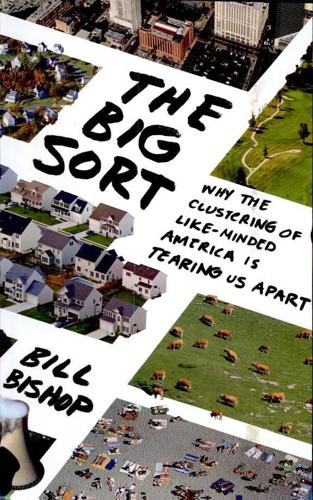
The Big Sort: Why the Clustering of Like-Minded America Is Tearing Us Apart
by
Bill Bishop
and
Robert G. Cushing
Published 6 May 2008
Modernization, Cultural Change, and Democracy: The Human Development Sequence. New York: Cambridge University Press, 2005. Isenberg, Daniel J. "Group Polarization: A Critical Review and Meta-Analysis." Journal of Personality and Social Psychology 50, no. 6 (1986). Jacobs, Jane. Cities and the Wealth of Nations. New York. Vintage Books, 1985. ———. The Death and Life of Great American Cities. New York: Random House, 1961. ———. The Economy of Cities. New York: Vintage Books, 1970. Jacobson, Gary C. "Explaining the Ideological Polarization of the Congressional Parties Since the 1970s." Paper prepared for the annual meeting of the Midwest Political Science Association, 2004.
…
See also Life-style, Post-materialism Culture Wars: The Struggle to Define America (Hunter), [>]–[>] n Cushmg, Robert, [>]–[>], [>], [>], [>], [>], [>], [>]–[>], [>] Dahl, Robert A., [>], [>] Daily Kos website, [>] Dallas, Tex. blacks in, [>], [>]; conservatives in, [>]; creative-class workers in, [>]; as high-tech city, [>] n, migration to, [>], [>], [>]; and presidential election (2004), [>], and social problems of Grapevine, [>], transportation in, [>] Dalton, Russell, [>], [>] Damon, Matt, [>] Dare to Discipline (Dobson), [>] Darnovsky, Marcy, [>] Daugherty, Gerald, [>]–[>] Day, Dick, [>]–[>], [>] DDB Needham Life Style survey, [>] Dean, Howard, [>], [>] The Death and Life of Great American Cities (Jacobs), [>] n Death penalty, [>] n Defenders of Wildlife, [>] Defense Department, U.S., [>] Delahunt, Bill, [>] Delaware, [>]–[>] DeLay, Tom, [>] n, [>] n Deliberative polls and Deliberation Day, [>]–[>], [>] n Democracy and benefits of apathy, [>]–[>]; cleavages and stability of U.S. political system, [>]; and communication, [>]–[>]; current status of, [>]–[>]; niche democracy, [>], paradox of, [>]–[>] Democracy Alliance, [>] Democratic Party age of Democrats, [>]–[>], and American Legislative Issue Campaign Exchange (ALICE), [>]; and blacks, [>]–[>]; canvassers for, [>]–[>], [>] n; characteristics of Democrats, [>]–[>], [>] n [>]–[>], [>]–[>], [>], church membership and religious beliefs of Democrats, [>], [>], [>]–[>], [>], no, [>], [>]–[>], [>]–[>], [>], [>]; and class, [>]–[>]; communication between Republican Party and, [>]–[>], [>], and conspiracy theory of political segregation, [>]–[>], and decline in public trust, [>]–[>]; and education, [>]–[>]; and families, [>]; and future of politics of migration, [>]–[>]; and gender gap, [>], [>] n, [>]; and high-tech cities, [>], [>]–[>]; and immigrants, [>], [>], income of Democrats, [>], [>], and Jews, [>] n, judges in, [>], [>] n; and liberal organizations mirroring conservative organizations, [>]–[>]; media preferences of Democrats, [>]–[>], in mid-1960s, [>]–[>], [>]–[>]; and midterm elections (2006), [>]–[>], [>], [>]–[>], [>]; and moral values, [>]–[>]; in 1950s, [>]–[>], and party loyalty, [>], [>]; polarization between Republican Party and, [>]–[>], [>]–[>], [>] n, [>]–[>], and political marketing, [>]–[>], and political segregation, [>], and population density, [>], and presidential campaign (2004), [>]–[>], [>]–[>], [>]–[>]; and presidential elections, [>]–[>], [>], [>]–[>], [>], [>]; and race, [>], [>], and rural areas, [>]–[>]; and straight-ticket voting, [>]–[>], [>]–[>] n, and tipping phenomenon in presidential elections, [>]–[>] AND ISSUES, abortion, [>]; economic issues, [>], [>], environmental issues, [>]–[>], [>] n, [>]–[>], [>], [>]; gun ownership, [>], homosexuality and gay marriage, [>], [>], Hurricane Katrina, [>]; Iraq War, [>], [>], [>], [>], [>], liberal view of, [>]; states'rights, [>]; stem cell research, [>]–[>], [>] n IN SPECIFIC STATES: Colorado, [>]–[>], Florida, [>], Kentucky, [>]–[>], [>]–[>]; Maryland, [>]; Minnesota, [>], [>]–[>], Missouri, [>]; Montana, [>], New Hampshire, [>]–[>] n; Ohio, [>], Oregon, [>]–[>], [>], [>]–[>]; Virginia, [>] Demographic shifts.
…
The greater number of civic organizations (such as choral societies) made northern Italy's economy more vibrant and its government more efficient than those in the less connected south [back] *** *Solow's paper "Technical Change and the Aggregate Production Function" led to his being awarded the 1987 Nobel Prize in economics. [back] *** *Jane Jacobs is best known for her book on urban design, The Death and Life of Great American Cities (1961), a work that undergirds today's New Urbanist movement. But most of Jacobs's time was spent producing her trilogy about economic growth The Economy of Cities (1969), Cities and the Wealth of Nations (1984), and The Nature of Economies (2000). [back] *** *More recently, MIT president Susan Hockfield noted that in semiconductor electronics, "the applied work transformed the fundamental research—not just the other way around" (speech, Brookings Institution, April 28, 2006).
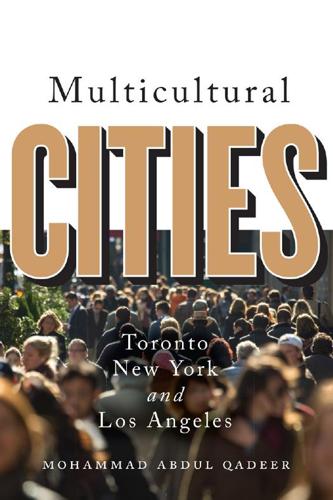
Multicultural Cities: Toronto, New York, and Los Angeles
by
Mohammed Abdul Qadeer
Published 10 Mar 2016
A Time for Reconciliation, Report of the Commission de Consultation sur les Pratiques d’Accommodement Reliées aux Différences Culturelles, (Quebec, 2008), 19. 43 Yasmeen Abu-Laban and Baha Abu-Laban, “Reasonable Accommodation in a Global Village,” Policy Options 26, no. 8 (2007), 30. 44 Julius Grey, “The Paradox of Reasonable Accommodation,” Policy Options 26, no. 8 (2007), 34–5. Notes to pages 36–44 279 45 Peter Hall, Cities in Civilization (London: Weidenfeld & Nicolson, 1998), 6. 46 Jane Jacobs, The Death and Life of Great American Cities (New York: Vintage Books, 1992), 14. 47 Richard Florida, The Flight of the Creative Class (New York: Collins, 2005), 62. 48 William Shakespeare, Coriolanus, act 3, scene 1. 49 Janet Abu-Lughod, Changing Cities: Urban Sociology (New York: HarperCollins, 1991), 140. 50 James Holston and Arjun Appadurai, “Cities and Citizenship,” Public Culture 8 (1996),188–9. 51 Ibid., 200. 52 Ash Amin, “The Good City,” Urban Studies 43, nos. 5/6 (May 2006),1012. 53 Susan S, Fainstein, The Just City (Ithaca; Cornell University Press, 2010), 3. 54 Ibid., 43. 55 Leonie Sandercock, Mongreal Cities (London: Continuum, 2003), 87. 56 Henri Lefebvre, Writings on Cities, trans.
…
Waters, and Jennifer Holdaway, Inheriting the City (New York: Russell Sage Foundation, 2008), 355. 25 New York Times, “India Hitching Hopes on Subway,” 4 May 2010, http:// www.nytimes.com/glogin?URI=http%3A%2F%2Fwww.nytimes.com%2F2 010%2F05%2F14%2Fworld%2Fasia%2F14delhi.html%3F_r%3. 26 Jane Jacobs, The Death and Life of Great American Cities (New York: Random House, 1961; Vintage Books, 1991), 32. 27 Lyn Lofland’s views are paraphrased by Hutter, Experiencing Cities, 204–5. 28 Ibid., 205. 29 Joe Frienson, “The GTA’s Matchless Sports,” Globe and Mail, 14 August 2011, M1. 30 New York Times, “Playing a Sport with Bats and Balls, but No Pitcher,” 3 April 2008, http://www.nytimes.com/glogin?
…
Isaac, Reginald. “The Dynamics of Urban Renewal.” In Taming Metropolis, edited by Wentworth Elderedge, 784–98. New York: Anchor Books, 1967. Iver, Pico. The Global Soul. New York: Viking Books, 2000. Jacobs, Jane. Cities and the Wealth of Nations. Harmondsworth: Viking, 1984. Jacobs, Jane. The Death and Life of Great American Cities. New York: Vintage Books, 1992. Jacobson, Matthew. Whiteness of a Different Color: European Immigrants and the Alchemy of Race. Cambridge, MA: Harvard University Press, 1998. Kaisinitz, Philip, John H. Mollenkopf, Mary C. Waters, and Jennifer Holdaway. Inheriting the City. New York: Russell Sage Foundation, 2008.
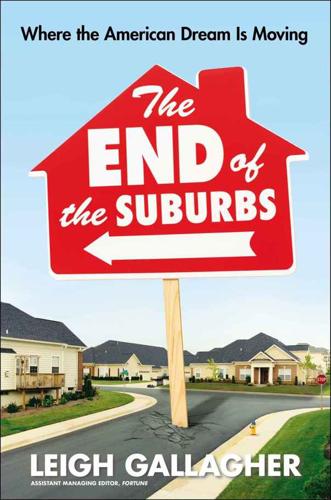
The End of the Suburbs: Where the American Dream Is Moving
by
Leigh Gallagher
Published 26 Jun 2013
Then there was Jane Jacobs, the writer and urban activist who championed the preservation of small-scale, authentic city neighborhoods and who is perhaps best known for beating back Robert Moses’s efforts to build an expressway through lower Manhattan in the 1960s. Her influential 1961 book, The Death and Life of Great American Cities, laid out her argument for the preservation of what she famously dubbed the “intricate ballet” of city sidewalks in their natural form, referring to the commerce, activity, and lively interplay among people that dense, varied neighborhood streets encouraged. (Jacobs spends several passages describing this ballet on her own stretch of Hudson Street, which is my neighborhood now, and I can vouch that her description of its various characters—children heading to the neighborhood’s St.
…
In 2002 a report: Reid Ewing, Rolf Pendall, and Don Chen, Measuring Sprawl and Its Impact, Smart Growth America, 2002. “There is no ‘there’ there”: Gold and Ritsch, “Swallowed by Urban Sprawl.” The historian Lewis Mumford: Jackson, Crabgrass Frontier, pp. 237, 244; Lewis Mumford, The Culture of Cities (Mariner Books, 1970). Her influential 1961 book: Jane Jacobs, The Death and Life of Great American Cities (Random House, 1961). The definitive critique of twentieth-century urban planning. It’s hard to overstate Jacobs’s role in urban planning, and her own artful explanation of the “sidewalk ballet” is worth citing in full here. She wrote that under the seeming disorder of cities, there was a “marvelous order for maintaining the safety of the streets and the freedom of the city.”
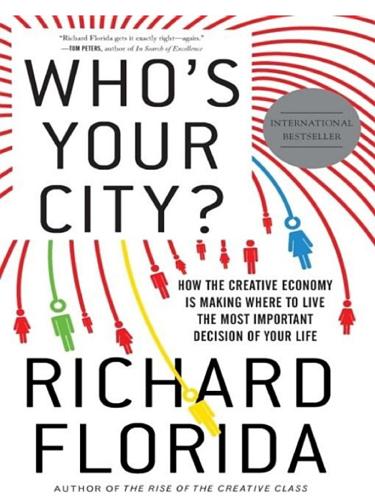
Who's Your City?: How the Creative Economy Is Making Where to Live the Most Important Decision of Your Life
by
Richard Florida
Published 28 Jun 2009
As Ricardo famously theorized, discretely defined countries have incentive to specialize in different kinds of industries, which would allow them to gain and maintain “comparative advantage” over others.1 The first person to see this was the great urbanist Jane Jacobs, who is best known for her scathing critique of urban planning, The Death and Life of Great American Cities, and two other very important books, The Economy of Cities and Cities and the Wealth of Nations.2 In The Economy of Cities (1969) Jacobs refutes the long-standing theory that cities emerged only after agriculture had become sufficiently productive to create a surplus beyond what was needed to survive.
…
These data are updated annually and are available on the census website. 3 Veolia Observatory of Urban Lifestyles, Life in the City, 2008. 4 Charles Tiebout, “A Pure Theory of Local Expenditures,” Journal of Political Economy 64, 5, 1956, pp. 416-424. 5 In particular, the work of Jane Jacobs: The Death and Life of Great American Cities, Vintage, 1992 (1st ed., 1961); The Economy of Cities, Vintage, 1970; and Cities and the Wealth of Nations, Vintage, 1985. Much of my own research on this subject is summarized in The Rise of the Creative Class, Basic Books, 2002. Chapter 2 1 Thomas Friedman, The World Is Flat, Farrar, Straus & Giroux, 2005. 2 The original article is Frances Cairncross, “The Death of Distance,” The Economist, September 30, 1995.
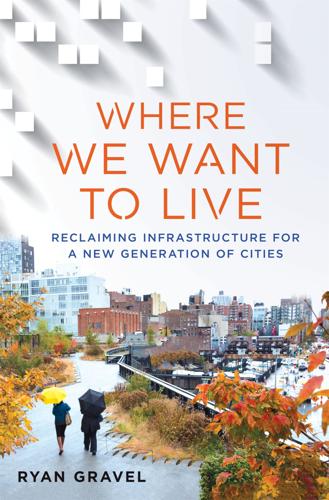
Where We Want to Live
by
Ryan Gravel
Published 2 Feb 2016
The serious and intransigent problems facing our country today are just now beginning to sink in. While they may yet go unnoticed in Congress or in state legislatures, they are increasingly evident in corporate conference rooms and around family dinner tables. In the five decades since Jane Jacobs wrote her landmark book, The Death and Life of Great American Cities, the physical growth of our metropolitan areas has been defined primarily by the forces she was fighting against. She was our preeminent citizen-planner and community activist. She fought with pragmatism, not nostalgia, in defense of the essential inner workings of public life that make our cities worth living in.
…
Ibid., 72–73. Chapter 15: Up Ahead 1. Atlanta Region Metropolitan Planning Commission, Up Ahead, A Regional Land Use Plan for Metropolitan Atlanta (Atlanta, 1952), 65, 72. 2. Ibid., 65, 72. 3. Ibid., 65, 72, 75. 4. Ibid., 65, 74. 5. Jane Jacobs, The Death and Life of Great American Cities (New York: Random House, 1961), 50. Index The index that appeared in the print version of this title does not match the pages in your e-book. Please use the search function on your e-reading device to search for terms of interest. For your reference, the terms that appear in the print index are listed below.
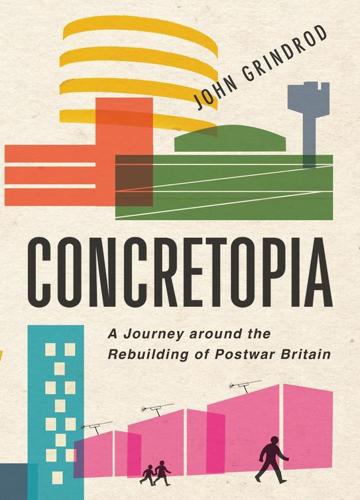
Concretopia: A Journey Around the Rebuilding of Postwar Britain
by
John Grindrod
Published 2 Nov 2013
It was a mixed social experiment. They were nervous about having lots and lots of large council estates,’ said Jim. He sat back, attempting to conjure up some kind of context for me. ‘By the end of the sixties Jane Jacobs had written her book in America’ – he was referring to the unlikely bestseller, The Death and Life of Great American Cities – ‘and there were lots of texts about “social engineering” it was called, steering people into these places. The town planning world was getting nervous about endlessly building council houses.’ ‘It’s funny, when you come from renting somewhere in London to renting somewhere here it didn’t seem like a big issue to me,’ Jo recalled with a shrug.
…
Young architectural historians Dan Cruikshank and Colin Amery, in their short, sharp shock of a book, The Rape of Britain, described the redevelopment of towns such as Worcester, Bath and Hereford as ‘an officially sponsored competition to see how much of Britain’s architectural heritage could be destroyed in 30 years.’3 They were echoing a cry from across the Atlantic. Jane Jacobs’ 1961 book The Death and Life of Great American Cities had become, in its own way, as influential as Ebenezer Howard’s Garden Cities of To-morrow. In it she railed against the visions of modern life championed by Howard and Le Corbusier, and their ‘dishonest mask of pretend order, achieved by ignoring or suppressing the real order that is struggling to exist and to be served’.4 Instead she advocated a return to the bustle of traditional street life, before comprehensive development schemes and neighbourhood planning had simplified towns to death with their pedestrianised precincts and wholesale disruption of old street patterns.
…
Notes 1 Evelyn Sharp, The Ministry of Housing and Local Government, Allen and Unwin, 1969, p11 2 Gavin Stamp in Elain Harwood and Alan Powers (ed.), The Sixties, The Twentieth Century Society, 2002, p135 3 Colin Amery and Dan Cruikshank, The Rape of Britain, Elek, 1975, p10 4 Jane Jacobs, The Death and Life of Great American Cities, Vintage, 1961 (Vintage Edition 1992), p15 5 Robert Matthew in Miles Glendinning, Modern Architect, RIBA Publishing, 2008, p461 6 Robert Matthew in Miles Glendinning, Modern Architect, RIBA Publishing, 2008, p476 7 Norman Dennis, People and Planning, Faber and Faber, 1970, p297 8 Norman Dennis, People and Planning, Faber and Faber, 1970, p346 9 Norman Dennis, People and Planning, Faber and Faber, 1970, p330 10 John R.
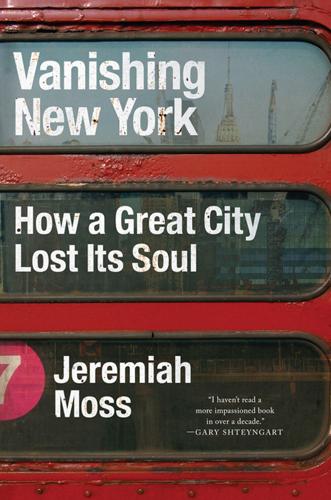
Vanishing New York
by
Jeremiah Moss
Published 19 May 2017
If, on the other hand, you are troubled by New York’s twenty-first-century transformation, if you lament the loss of the city’s unique character and wonder what the hell happened, then read on. You will find the lost city in these pages, through a (sometimes painfully) detailed account of its disappearance. When all is said and done, you might end up with a broken heart. Either way, you’ve been warned. To borrow the first line of Jane Jacobs’s classic, The Death and Life of Great American Cities: “This book is an attack on current city planning and rebuilding.” It is an attack on the luxury vision of New York that characterized the Bloomberg years. It is an attack on suburbanization, hyper-gentrification, and all that led up to it. A plea for the soul of the city, this book is not a nostalgia trip, but it is about history.
…
It is undeniable that New York has been remade into a city for the superrich. Among the many effects of this transformation has been a profound shift in the everyday psyche of the city—how it feels to walk down the street, eat in a restaurant, even move through the hallways of your own building. As Updike said, the superrich can be lousy neighbors. In The Death and Life of Great American Cities, Jane Jacobs wrote about the way that people living in tenements and working out of mom-and-pop shops keep a close watch over the streets, while newer, richer residents turn a blind eye. She told a story about a scene in Greenwich Village when it looked like a strange man was about to kidnap a little girl.
…
Series B, Human Geography 71, no. 1 (1989). ———. Rebel Cities: From the Right to the City to the Urban Revolution. New York: Verso Books, 2013. Jackson, Kenneth. Crabgrass Frontier: The Suburbanization of the United States. New York: Oxford University Press, 1987. Jacobs, Jane. The Death and Life of Great American Cities. New York: Vintage, 1992. Jones, Jacqueline. A Dreadful Deceit: The Myth of Race from the Colonial Era to Obama’s America. New York: Basic Books, 2013. Kasson, John. Amusing the Million: Coney Island at the Turn of the Century. New York: Hill & Wang, 1978. Klein, Naomi. The Shock Doctrine: The Rise of Disaster Capitalism.

The Wikipedia Revolution: How a Bunch of Nobodies Created the World's Greatest Encyclopedia
by
Andrew Lih
Published 5 Jul 2010
Urban Jungle The plight of Wikipedia growing from small community to larger digital metropolis is something both Joseph Reagle in his Ph.D. work on Wikipedia and Steven Johnson in Emergence note as being similar to problems of urban planning. There is no better historical example than that explored in Jane Jacobs’s book The Death and Life of Great American Cities, her critique of the modernist planning policies of the 1950s and 1960s, an era when New York City developer Robert Moses was razing entire swaths of neighborhoods for planned housing projects and communities. Jacobs argued for preserving her small neighborhood on Hudson Street and resisting massive urban renewal, because the intimate sidewalks served an important social function.
…
title=Wikipedia:Be_bold& oldid=38947. 30. http://lists.wikimedia.org/pipermail/wikien-l/ 2003-February/001149.html. 31. http://en.wikipedia.org/wiki/Wikipedia:Advice_for_new_administrators. 32. http://en.wikipedia.org/wiki/Wikipedia:Awareness_statistics. 33. http://stats.wikimedia.org/EN/TablesWikipediaEN.htm. 34. 4,687 editors made more than 100 edits each that month. 35. http://wikisummaries.org/index.php?title=The_Death_and_Life_of_Great_American _Cities & oldid=5639 (retrieved June 8, 2007). 36. http://en.wikipedia.org/wiki/User_talk:Rambot/Delete 17:32, 11 Sep 2003 (UTC). 37. http://en.wikipedia.org/wiki/Wikipedia:Bots#Restrictions_on _specific_tasks. 38. http://en.wikipedia.org/wiki/User:Seth_Ilys/Dot_Project. 39. http:// en.wikipedia.org/wiki/User:Seth_Ilys/Dot_Project. 40. http://en.wikipedia.org/w/index.php?
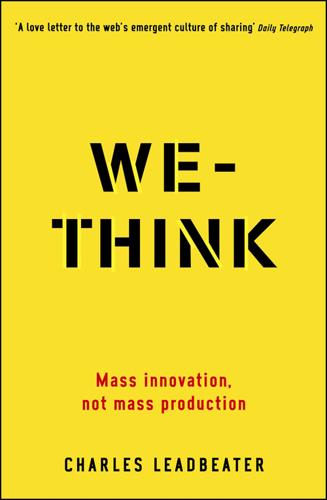
We-Think: Mass Innovation, Not Mass Production
by
Charles Leadbeater
Published 9 Dec 2010
Available from http://userinnovation.mit. edu/papers/6.pdf; Eric von Hippel and Georg von Krogh, ‘Open Source Software and the Private-Collective Innovation Model: Issues for Organization Science’, Organization Science 14.2 (2003), pp. 209–23; Eric von Hippel, ‘Horizontal Innovation Networks – By and For Users’, MIT Sloan School of Management Working Paper No. 4366–02, June 2002 12 Sonali Shah, ‘Open Beyond Software’, in Chris DiBona, Danese Cooper and Mark Stone (Eds), Open Sources 2.0 (O’Reilly, 2006) 13 Henry Jenkins, Convergence Culture (New York University Press, 2006) 14 Henry Jenkins, Fans, Bloggers, and Gamers (New York University Press, 2006) 15 Pekka Himanen, The Hacker Ethic and the Spirit of the Information Age (London: Secker & Warburg, 2001) 16 John Roberts, The Modern Firm (Oxford University Press, 2004) 17 Jane Jacobs, The Death and Life of Great American Cities (Vintage, 1992) 18 John Micklethwait and Adrian Wooldridge, The Company (London: Weidenfeld & Nicolson, 2003) 19 Henry Hansmann, The Ownership of Enterprise (Cambridge, MA: Belknap Harvard, 1996) 20 James Boyle, ‘The Second Enclosure Movement and the Construction of the Public Domain’, Law and Contemporary Problems 66.1&2 (2003), pp.33–74.
…
Available from http://www.mit.edu/people/mkgray/ net/web-growth-summary.html Häikiö, Martti, Nokia: The Inside Story (Pearson, 2002) Hall, Peter A. and David Soskice (Eds), Varieties of Capitalism (Oxford University Press, 2001) Hansmann, Henry, The Ownership of Enterprise (Cambridge, MA: Belknap Harvard, 1996) Hardin, Garrett, ‘The Tragedy of the Commons’, Science 162 (1968), 1243–48 Hargadon, Andrew, How Breakthroughs Happen (Boston, MA: HBS Press, 2003) Hartley, John, ‘Culture Business and the Value Chain of Meaning’, The New Economy, Creativity and Consumption – A Symposium (Brisbane: Queensland University of Technology Publications, 2002), pp. 39–46 Hayward, Peter J., A Natural History of the Seashore (HarperCollins, 2004) Himanen, Pekka, The Hacker Ethic and the Spirit of the Information Age (Secker & Warburg, 2001) Homer-Dixon, Thomas, The Upside of Down: Catastrophe, Creativity, and the Renewal of Civilisation, (Souvenir Press Ltd, 2007) Hyde, Lewis (1979), The Gift: How the Creative Spirit Transforms the World (Edinburgh: Canongate, 2006) InterAcademy Council, Inventing a Better Future (Amsterdam: IAC, 2004) Illich, Ivan, Tools for Conviviality (New York: Harper & Row, 1973) Illich, Ivan, Energy and Equity (Calder & Boyars, 1974) Illich, Ivan, Limits to Medicine (Marion Boyars, 2002) Illich, Ivan, Deschooling Society (Marion Boyars, 2004) Isaacs, William, Dialogue and the Art of Thinking Together (Currency, 1999) Israel, Paul, Edison: A Life of Invention (John Wiley, 1998) Jacobs, Jane, The Death and Life of Great American Cities (Vintage, 1992) Jenkins, Henry, Convergence Culture (New York University Press, 2006) Jenkins, Henry, Fans, Bloggers, and Gamers (New York University Press, 2006) Jensen, Mallory, ‘Emerging Alternatives: A Brief History of Weblogs’, 2003. Available from http://www.cjr.org/ issues/2003/5/blog-jensen.asp Joyce, Patrick, The Rule of Freedom (Verso, 2003) Kapor, Mitch, blog.kapor.com Kapor, Mitch, ‘Does the Open Source Model Apply Beyond Software?’
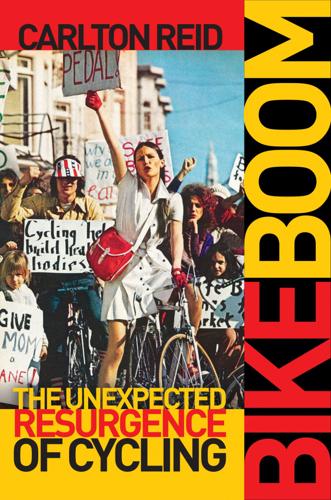
Bike Boom: The Unexpected Resurgence of Cycling
by
Carlton Reid
Published 14 Jun 2017
A journalist for the Architectural Forum, Jacobs rode around Greenwich Village on a bicycle, her handbag stashed in a wicker basket on the front. With her grey thatch and owlish glasses, and her undeniably brilliant writing, she is now usually portrayed as a David-vs.-Goliath heroine, with Moses as Goliath. In fact, the two only sparred in person once, and Moses appears only fleetingly in Jacobs’s great 1961 work, The Death and Life of Great American Cities. Moses is usually painted as a monster intent on putting cars where we now know cars shouldn’t go, but this ignores his massive earlier influence on New York. For 44 years, from 1924 until 1968, Moses built parks, highways, bridges, playgrounds, housing, tunnels, zoos, and exhibition halls.
…
What was required instead, believed Schumacher, were small-scale “appropriate technologies.” The bicycle, believed the bike activists (“biketivists”), was more of an appropriate technology for city use than the smelly, dangerous, gas-guzzling, space-hungry automobile. Jane Jacobs’s The Death and Life of Great American Cities was the second non-cycling philosophical tome on the bookshelf of every card-carrying cycle activist of the 1970s, with the third being Ivan Illich’s Energy and Equity of 1974. CHICAGO-BASED Edward Aramaic explicitly linked cycling with environmentalism when he founded Bicycle Ecology and organized a “pedal-in” in October 1970.
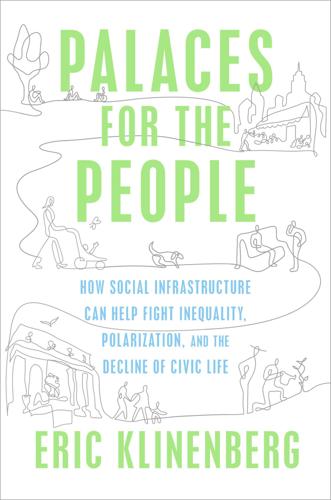
Palaces for the People: How Social Infrastructure Can Help Fight Inequality, Polarization, and the Decline of Civic Life
by
Eric Klinenberg
Published 10 Sep 2018
“allows a people to choose their own way”: Ashley Carse, “Keyword: Infrastructure—How a Humble French Engineering Term Shaped the Modern World,” in Infrastructures and Social Complexity: A Companion, ed. Penny Harvey, Casper Bruun Jensen, and Atsuro Morita (London: Routledge, 2016). produce the material foundations for social life: The classic text about how small businesses and commercial operators shape daily social life is Jane Jacobs’s The Death and Life of Great American Cities (New York: Vintage, 1961). In recent years, the eminent sociologist Elijah Anderson has been writing about what he calls “the cosmopolitan canopy,” places where people from different backgrounds “not only share space but seek out each other’s presence,” and occasionally forge relationships as well.
…
occupancy rate was 35 percent: Colin Marshall, “Pruitt-Igoe: The Troubled High-Rise That Came to Define Urban America,” Guardian, April 22, 2015. “Walking through Pruitt-Igoe”: Newman, Creating Defensible Space, 11. “neat and well maintained”: Ibid. “Across the street from Pruitt-Igoe”: Ibid. “eyes on street”: Jane Jacobs, The Death and Life of Great American Cities (New York: Vintage, 1961), 35. “With social variables constant”: Newman, Creating Defensible Space, 11. “an accord about acceptable behavior”: Ibid., 25, 11–12. 1972 report, Defensible Space: The report was not limited to St. Louis. In New York City, Newman found that residents of a low-rise public housing complex in Brownsville experienced 34 percent fewer overall crimes and 74 percent fewer indoor crimes than their neighbors in the nearby high-rise Van Dyke projects.
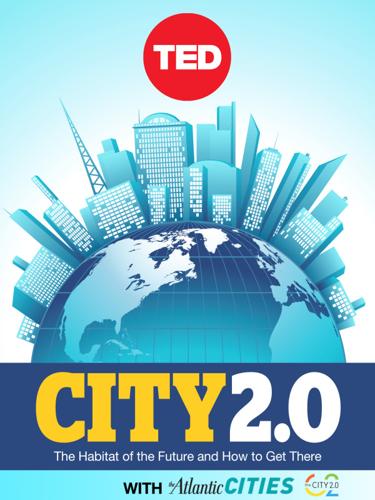
City 2.0: The Habitat of the Future and How to Get There
by
Ted Books
Published 20 Feb 2013
Most cities are the outcome, the vector sum, of innumerable small acts bearing no discernible overall intention. — James C. Scott, Seeing Like a State Cities have the capability of providing something for everybody, only because, and only when, they are created by everybody. — Jane Jacobs, The Death and Life of Great American Cities * * * We are living on an urban planet; our cities are growing at spectacular rates. This growth has created new energy and excitement (cities account for 70 percent of the global economy), and it has highlighted the dysfunctions of cities. Most of our cities, particularly the fastest-growing ones, are messy, confusing places, even for the citizens who call them home.
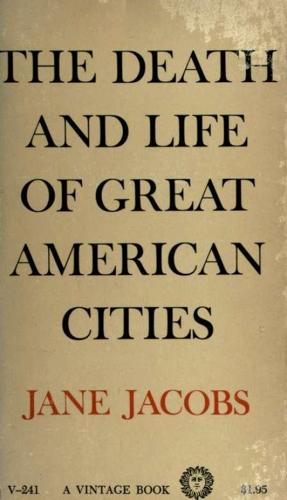
The death and life of great American cities
by
Jane Jacobs
Published 1 Nov 1961
The DEATH and LIFE of GREAT AMERICAN CITIES Jane Jacobs Jane Jacobs was born in Scranton, Pennsylvania, and now lives in Toronto. In addition to The Death and Life of Great American Cities, she is the author of Cities and the Wealth of Nations, The Question of Separatism, The Economy of Cities, and, most recently, Systems of Survival. ALSO BY Jane Jacobs Systems of Survival: A Dialogue on the Moral Foundation of Commerce and Politics Cities and the Wealth of Nations: Principles of Economic Life The Question of Separatism: Quebec and the Struggle over Sovereignty The Economy of Cities VINTAGE BOOKS EDITION, DECEMBER 1992 Copyright © 1961 by Jane Jacobs Copyright renewed 1989 by Jane Jacobs All rights reserved under International and Pan-American Copyright Conventions Published in the United States by Vintage Books, a division of Random House, Inc., New York, and simultaneously in Canada by Random House of Canada Limited, Toronto Originally published in hardcover by Random House, Inc., New York, in 1961 Acknowledgment is made to the following publications for permission to reprint portions of this book which first appeared in their pages: Architectural Forum, the Columbia University Forum, Harper’s Magazine, The Reporter.
…
ALSO BY Jane Jacobs Systems of Survival: A Dialogue on the Moral Foundation of Commerce and Politics Cities and the Wealth of Nations: Principles of Economic Life The Question of Separatism: Quebec and the Struggle over Sovereignty The Economy of Cities VINTAGE BOOKS EDITION, DECEMBER 1992 Copyright © 1961 by Jane Jacobs Copyright renewed 1989 by Jane Jacobs All rights reserved under International and Pan-American Copyright Conventions Published in the United States by Vintage Books, a division of Random House, Inc., New York, and simultaneously in Canada by Random House of Canada Limited, Toronto Originally published in hardcover by Random House, Inc., New York, in 1961 Acknowledgment is made to the following publications for permission to reprint portions of this book which first appeared in their pages: Architectural Forum, the Columbia University Forum, Harper’s Magazine, The Reporter. Library of Congress Cataloging-in-Publication Data Jacobs, Jane, 1916– The death and life of great American cities / Jane Jacobs.—1st Vintage Books ed. p cm Originally published: New York: Random House, [1961] ISBN 0-679-74195-X 1 City planning—United States 2 Urban renewal—United States. 3. Urban policy—United States I. Title HT167.J33 1992 307.76′097 3—dc20 92-50082 Ebook ISBN 9780525432852 v4.1 a TO NEW YORK CITY where I came to seek my fortune and found it by finding Bob, Jimmy, Ned and Mary for whom this book is written too Acknowledgment So many scores of persons helped me with this book, wittingly and unwittingly, that I shall never fully be able to acknowledge the appreciation I owe and feel.
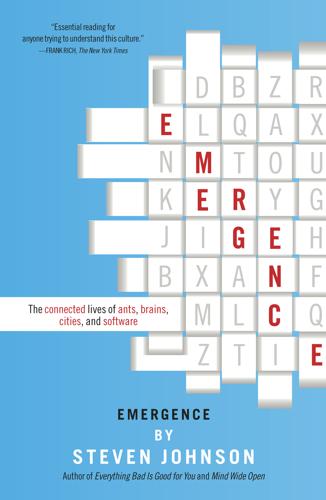
Emergence
by
Steven Johnson
Still, the top-heavy structure of mass media may keep those loops relatively muted for the foreseeable future, at least where the tube is concerned. Feedback, after all, is usually not a television thing. You need the Web to hear it wail. * * * In June of 1962, a full year after the appearance of The Death and Life of Great American Cities, Lewis Mumford published a scathing critique of Jane Jacobs’s manifesto in his legendary New Yorker column, “The Sky Line.” In her prescriptions for a sidewalk-centric urban renewal, “Mother Jacobs”—as Mumford derisively called her—offered a “homemade poultice for the cure of cancer.”
…
Mechanical Intelligence. Vol. 3 of The Collected Works of Alan Turing. New York: Elsevier Science Publishing, 1992. Innes, Judith E., and David E. Booher. “Metropolitan Development as a Complex System: A New Approach to Sustainability.” Economic Development Quarterly 13 (1999): 141–56. Jacobs, Jane. The Death and Life of Great American Cities. New York: Vintage, 1961. ———. The Nature of Economies. New York: Modern Library Original, 2000. Johnson, George. Fire in the Mind: Science, Faith and the Search for Order. New York: Vintage, 1995. Johnson, Steven. Interface Culture: How New Technology Transforms the Way We Create and Communicate.
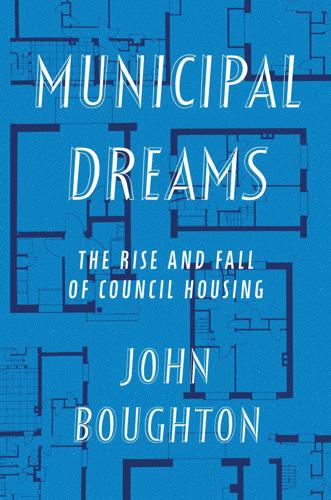
Municipal Dreams: The Rise and Fall of Council Housing
by
John Boughton
Published 14 May 2018
It wasn’t, however, just the organisational model of council housing that was wrong according to its opponents. On many occasions it was the new housing’s actual form that came under attack. There was, by the 1980s, an established literature challenging many of the cherished ideals of modern urban planning and redevelopment. This was represented most famously in Jane Jacobs’ 1961 book, The Death and Life of Great American Cities, which argued for dense, mixed-used neighbourhoods fostering, in her view, vibrant communities against the dead hand of those who would zone and isolate. This critique – and its defence of street life – was extended to the large public housing schemes that had appeared in some American inner cities.
…
A New Future for the Cottage Estates (Routledge, 2016), 91. 4UK Government, ‘Table 208 House Building: Permanent Dwellings Started, by Tenure and Country’, gov.uk, accessed 9 March 2017. 5For details of legislation, see Alan Murie, ‘The Right to Buy: History and Prospect’, History and Policy, November 2015, historyandpolicy.org, accessed 30 January 2017. 6Norman Tebbit, Speech to the Conservative Party Conference, 15 October, 1981. 7Brian Lund, Housing Problems and Housing Policy (Longman, 1996), 123. 8Ian Cole and Robert Furbey, The Eclipse of Council Housing (Routledge, 1994), 188–9. 9Quoted in Brian Milligan, ‘Right-to-Buy: Margaret Thatcher’s Controversial Gift’, BBC News Online, 10 April 2013, bbc.co.uk, accessed 31 January 2017. 10Richard Harris and Peter Larkham (eds), Changing Suburbs: Foundation, Form and Function (Routledge, 2003), 68. 11Reinout Kleinhans and Maarten van Ham, ‘Lessons Learned from the Largest Tenure-Mix Operation in the World: Right to Buy in the United Kingdom’, Cityscape: A Journal of Policy Development and Research, vol. 15, no. 2, 2013, 110. 12Ray Forrest and Alan Murie, Selling the Welfare State: The Privatisation of Public Housing (Routledge, 1991), 11. 13Figures drawn from Steve Wilcox, Housing Finance Review 1999/2000 (Joseph Rowntree Foundation, 1999), ukhousingreview.org.uk, accessed 1 February 2017. 14Quoted in John Stewart and Gerry Stoker (eds), The Future of Local Government (Macmillan, 1989), 89. 15Jane Jacobs, The Death and Life of Great American Cities (Vintage Books, 1992), 44–3. 16Horizon, ‘The Writing on the Wall’, broadcast on BBC 2, 18 November 1974, available on youtube.com, accessed 8 February 2017. 17Herzberg, ‘Housing at World’s End, Chelsea: Appraisal’. 18Alice Coleman, ‘Design Disadvantage in Southwark’, The Dulwich Society Journal, Summer 2008, dulwichsociety.com, accessed 7 February 2017. 19Alice Coleman, Utopia on Trial: Vision and Reality in Planned Housing (Hilary Shipman, 1985), 22. 20Valerie Grove, Sunday Times, 7 June 1987, cited in Graham Stewart, Robin Hood Gardens Blackwall Reach (Wild ReSearch, ND), 15. 21Charles Jencks, The New Paradigm in Architecture: The Language of PostModernism (Yale University Press, 2002), 18. 22‘Life at Deck Level’, Southwark Civic News, July 1968. 23Southwark Sparrow, February 1987. 24Castle Vale Housing Action Trust, Castle Vale Masterplan Written Statement, September 1993. 25Messenger, ‘Haven for Hoodlums’. 26Bill Hillier, ‘City of Alice’s Dreams’, Architects’ Journal, vol. 184, no. 28, 1986, 39. 27One of Coleman’s team wrote a fuller treatment of the estate (which she anonymised as ‘Omega’).

Data Action: Using Data for Public Good
by
Sarah Williams
Published 14 Sep 2020
See also: Miami City Planning and Zoning Board, “The Miami Long Range Plan”; Wilbur Smith and Associates, “A Major Highway Plan for Metropolitan Dade County, Florida”; Smith and Associates, “Alternates for Expressways.” 67 Mohl, “Stop the Road.” 68 Peter Hall, “The Turbulent Eighth Decade: Challenges to American City Planning,” Journal of the American Planning Association 55, no. 3 (September 30, 1989): 275–282, https://doi.org/10.1080/01944368908975415. 69 Roberta Brandes Gratz, The Battle for Gotham: New York in the Shadow of Robert Moses and Jane Jacobs (New York: Nation Books, 2010). 70 Gratz, The Battle for Gotham; Jane Jacobs, The Death and Life of Great American Cities (New York: Random House, 1961). 71 Sherry Arnstein, “A Ladder of Citizen Participation,” Journal of the American Institute of Planners 35. no. 4 (1969): 216–224. 72 John Forester, Planning in the Face of Power (Oakland: University of California Press, 1988). 73 James J. Glass, “Citizen Participation in Planning: The Relationship Between Objectives and Techniques,” Journal of the American Planning Association 45, no. 2 (April 1979): 180–189, https://doi.org/10.1080/01944367908976956. 74 John Forester, The Deliberative Practitioner: Encouraging Participatory Planning Processes (Cambridge, MA: MIT Press, 1999). 75 Kevin Lynch, The Image of the City (Cambridge, MA: MIT Press, 1960). 76 Jennifer S.
…
Inka Khipu (Fiber Recording Device). Circa 1400–1532. Cords, knotted and twisted; cotton and wool, Overall: 85 x 108 cm (33 7/16 x 42 1/2 in.). https://clevelandart.org/art/1940.469. Interview with Iyad Kheirbek of [New York City Department of Mental Health and Hygiene], January 2015. Jacobs, Jane. The Death and Life of Great American Cities. New York: Random House, 1961. “James Madison to W. T. Barry, August 4, 1822.” Image. Library of Congress, Washington, DC. Accessed January 26, 2019. https://www.loc.gov/resource/mjm.20_0155_0159/?st=list. Jin, Xiaobin, Ying Long, Wei Sun, Yuying Lu, Xuhong Yang, and Jingxian Tang.
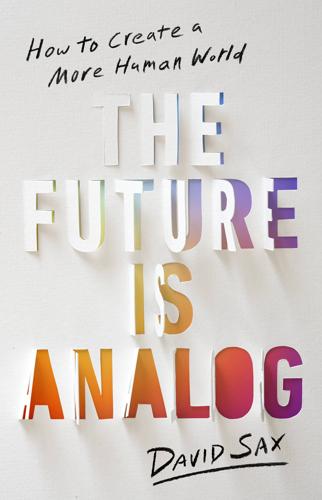
The Future Is Analog: How to Create a More Human World
by
David Sax
Published 15 Jan 2022
Thanks to Robert Caro’s epic biography, The Power Broker, Moses is a reviled, thoroughly disgraced figure whose vision of the future of cities is widely recognized as destructive and outmoded. Meanwhile, Jacobs became the patron saint of the future of cities, based on the innovations she identified in her 1961 book The Death and Life of Great American Cities: wider sidewalks, more public spaces, better public transit, more varied uses for parks, prioritizing pedestrians and bikers. Fewer cars and more people. Jacobs’s ideas remain the most forward-looking ones in urban planning, but they were not new even in the 1960s. They are based on returning cities to the sourdough equivalent of urban planning, the kind Americans experience on their first trip to Europe, when they marvel at just how many lovely plazas and street cafés they have over there, how pleasant it is to walk around, and how pointless it is to drive around Rome.
…
Jaegerhaus, Walter. “What’s the Matter with American Cities?” Common Edge. February 7, 2022. Goldmark, Sandra. Fixation: How to Have Stuff Without Breaking the Planet. Washington, DC: Island Press, 2020. Gel, Jan. Cities for People. Washington, DC: Island Press, 2010. Jacobs, Jane. The Death and Life of Great American Cities. New York: Random House, 1961. Caro, Robert A. The Power Broker: Robert Moses and the Fall of New York. New York: Knopf, 1974. Vinsel, Lee, and Andrew L. Russell. The Innovation Delusion: How Our Obsession with the New Has Disrupted the Work That Matters Most. New York: Currency, 2020.

Reinventing Discovery: The New Era of Networked Science
by
Michael Nielsen
Published 2 Oct 2011
Among the more formative accounts for me were Ben Rich’s Skunk Works [184], Richard Rhodes’s The Making of the Atomic Bomb [183], and Robert Colwell’s The Pentium Chronicles [45]. A little further afield, Peter Block’s book Community: The structure of belonging [18] contains many insights about the problems of building community. And, finally, Jane Jacobs’s masterpiece The Death and Life of Great American Cities [98] is a superb account of how very large groups tackle a core human problem: how to make a place to live. Networked science, in general: The potential of computers and the network to change the way science is done has been discussed by many people, and over a long period of time.
…
Reaffirmation and extension of NHGRI rapid data release policies: Large-scale sequencing and other community resource projects, February 2003. http://www.genome.gov/10506537. [97] In one instant a left-lane nation swerves right. Life, September 15, 1967. [98] Jane Jacobs. The Death and Life of Great American Cities. Toronto: Random House of Canada, 1961. [99] Irving Lester Janis. Groupthink: Psychological Studies of Policy Decisions and Fiascoes. Boston: Houghton Mifflin, 1983. [100] Eamon Javers. The pit bull of public relations. Business Week, April 17, 2006. [101] Ayodele Samuel Jegede.

The Coming of Neo-Feudalism: A Warning to the Global Middle Class
by
Joel Kotkin
Published 11 May 2020
PART VI The New Geography of Feudalism A metropolitan economy, if it is working well, is constantly transforming many poor people into middle-class people, many illiterates into skilled (or even educated) people, many greenhorns into competent citizens…. Cities don’t lure the middle class. They create it. —Jane Jacobs, The Death and Life of Great American Cities CHAPTER 16 The New Gated City Few sights are more thrillingly suggestive of artful modernity than the Chicago skyline. The city center along Lake Michigan is one of the most vibrant business districts in the nation, boasting numerous corporate headquarters and drawing affluent, highly skilled people from across America’s vast Midwest.1 In 2017, Chicago ranked second only to the tech hub Seattle among major American cities for the number of active construction cranes.2 Yet just a short drive away from the cranes and gleaming towers is a landscape of utter devastation.
…
utm_source=Mic+Check&utm_campaign=2b200dd408-Thursday_July_167_15_2015&utm_medium=email&utm_term=0_51f2320b33-2b200dd408-285306781. 53 Katy Murphy, “The California Dream is tough to afford if you’re under 40,” Mercury News, February 21, 2018, https://www.mercurynews.com/2018/02/18/the-california-dream-is-tough-to-afford-if-youre-under-40/; Joel Kotkin and Wendell Cox, “Fading Promise: Millennial Prospects in the Golden State,” Center for Demographics and Policy, May 5, 2017, http://centerforcaliforniarealestate.org/publications/Kotkin-Fading-Dream-printable.pdf. 54 Center for Opportunity Urbanism, Beyond Gentrification. 55 John Aidan Byrne, “The Exodus of New York City’s endangered middle class,” New York Post, December 22, 2018, https://nypost.com/2018/12/22/the-exodus-of-new-york-citys-endangered-middle-class/; Jane Jacobs, The Death and Life of Great American Cities (New York: Vintage, 1962), 282. 56 National Urban Coalition, Displacement: City Neighborhoods in Transition, Washington, D.C., 1978. 57 Kristian Behrens and Frederic Robert-Nicoud, “Urbanization Makes the World More Unequal,” VoxEU, July 24, 2014, https://voxeu.org/article/inequality-big-cities. 58 Richard Florida, “Mapping the New Urban Crisis,” City Lab, April 13, 2017, https://www.citylab.com/equity/2017/04/new-urban-crisis-index/521037/; Patrick Sharkey, “Rich Neighborhood, Poor Neighborhood: How Segregation Threatens Social Mobility,” Brookings, December 5, 2013, https://www.brookings.edu/blog/social-mobility-memos/2013/12/05/rich-neighborhood-poor-neighborhood-how-segregation-threatens-social-mobility/. 59 Helen Raleigh, “Gentrification Provokes a Cofee Clash in Denver’s Five Points,” Wall Street Journal, December 22, 2017, https://www.wsj.com/articles/gentrification-provokes-a-coffee-clash-in-denvers-five-points-1513983831; Cameron McWhirter, “Atlanta’s Growing Pains Are Getting Worse,” Wall Street Journal, August 31, 2018, https://www.wsj.com/articles/atlantas-growing-pains-are-getting-worse-1535707800; Richard Campanella, “Gentrification and Its Discontents: Notes From New Orleans,” New Geography, February 28, 2013, http://www.newgeography.com/content/003526-gentrification-and-its-discontents-notes-new-orleans; “Google abandons Berlin base after two years of resistance,” Guardian, October 24, 2018, https://www.theguardian.com/technology/2018/oct/24/google-abandons-berlin-base-after-two-years-of-resistance; Chantal Braganza, “Why opponents of gentrification have taken to the streets of Hamilton,” TVO, April 5, 2018, https://tvo.org/article/current-afairs/why-opponents-of-gentrification-have-taken-to-the-streets-of-hamilton; David Streitfeld, “Protesters Block Google Buses in San Francisco, Citing ‘Techsploitation,’” New York Times, May 31, 2018, https://www.nytimes.com/2018/05/31/us/google-bus-protest.html?

Ghost Road: Beyond the Driverless Car
by
Anthony M. Townsend
Published 15 Jun 2020
Yet while such fears aren’t misplaced—it’s easy to see pedestrian areas becoming overwhelmed by conveyors—it may be possible to program them to be so deferential that we may not mind. That’s the thinking behind an effort at MIT’s Aerospace Controls Lab, which is using deep learning to help computers understand the “intricate sidewalk ballet” described by urbanist Jane Jacobs in her 1961 classic The Death and Life of Great American Cities. Researchers have already successfully programmed a conveyor with enough sense to learn our unwritten rules of body language and smoothly move through crowds. But if faking human moves doesn’t solve sidewalk gridlock, conveyor makers may simply try to make their machines more cute.
…
Burns, Reinventing the Automobile: Personal Urban Mobility for the 21st Century (Cambridge, MA: MIT Press, 2010), 24. 56“up to four bags of groceries”: “Marble’s Delivery Robots Hit the Ground to Map Out Arlington, Texas,” AUVSI, August 21, 2018, https://www.auvsi.org/industry-news/marbles-delivery-robots-hit-ground-map-out-arlington-texas. 57a global web of design and engineering, manufacturing: “Starship Technologies,” Crunchbase, accessed February 11, 2019, https://www.crunchbase.com/organization/starship-technologies#section-investors. 57the city’s Board of Supervisors to enact a temporary ban: Adam Brinklow, “San Francisco Ready to Permit Robots on City Sidewalks,” Curbed SF, March 14, 2018, https://sf.curbed.com/2018/3/14/17120628/san-francisco-robot-ban-fees-yee-tech. 57“intricate sidewalk ballet”: Jane Jacobs, The Death and Life of Great American Cities (New York: Random House, 1961), 92. 57a conveyor with enough sense to learn our unwritten rules: Jennifer Chu, “New Robot Rolls with Rules of Pedestrian Conduct,” MIT News, Massachusetts Institute of Technology, August 29, 2017, http://news.mit.edu/2017/new-robot-rolls-rules-pedestrian-conduct-0830. 57“students held a candlelight vigil for it”: Carolyn Said, “Kiwibots Win Fans at UC Berkeley as They Deliver Fast Food at Slow Speeds,” San Francisco Chronicle, May 26, 2019, https://www.sfchronicle.com/business/article/Kiwibots-win-fans-at-UC-Berkeley-as-they-deliver-13895867.php. 58capping a sudden surge of venture-capital investment: Leslie Hook and Tim Bradshaw, “Silicon Valley Start-Ups Race to Win in Driverless Delivery Market,” Financial Times, January 30, 2018, https://www.ft.com/content/decb36d8-056b-11e8-9650-9c0ad2d7c5b5. 58Ford plans to launch one based on a pickup truck chassis: Joann Muller, “One Big Thing: Ford CEO Says AV Progress Isn’t All about Technology,” Axios, October 12, 2018, https://www.axios.com/newsletters/axios-autonomous-vehicles-d682a456-7a3d-4e62-bcf0-5b322f82df48.html. 585.14-meter-long vehicle can carry 12 passengers: “Vision Urbanetic: On Demand, Efficient and Sustainable: Vision Urbanetic Answers the Question of Future Urban Mobility,” Daimler, September 10, 2018, https://media. daimler.com/marsMediaSite/en/instance/ko.xhtml?
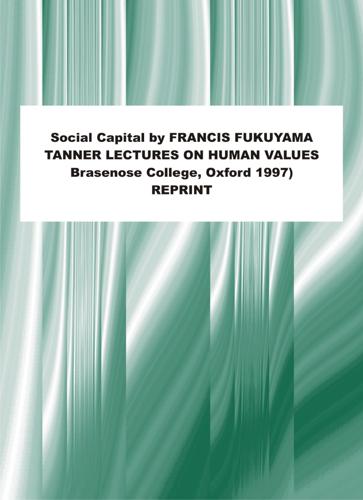
Social Capital and Civil Society
by
Francis Fukuyama
Published 1 Mar 2000
I want to address each of these issues, and in particular how social capital is produced and consumed in an increasingly complex, high-tech economy like that of the United States. SOCIAL CAPITAL : DEFINITIONS The first use of the term “social capital” that I am aware of was in Jane Jacobs’s classic work The Death and Life of Great American Cities, in which she explained that the dense social networks that existed in older, mixed-use urban neighborhoods constituted a form of social capital and were far more responsible for cleanliness, absence of street crime, and other quality-of-life measures than were formal institutional factors like police protection.2 1 These are the broad themes of Trust: T h e Social Virtues and the Creation o f Prosperity (New York: Free Press, 1995). 2 Jane Jacobs, T h e Death and Life o f Great American Cities (New York: Vintage Books, 1961), p. 138
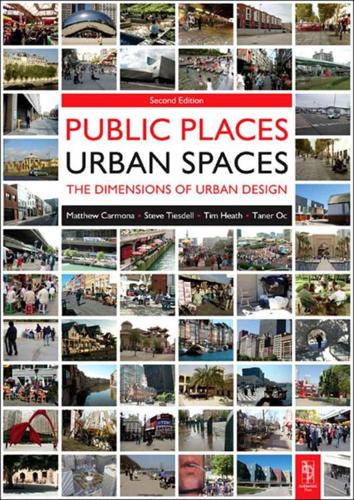
Public Places, Urban Spaces: The Dimensions of Urban Design
by
Matthew Carmona
,
Tim Heath
,
Steve Tiesdell
and
Taner Oc
Published 15 Feb 2010
Identifying Kevin Lynch as a key proponent of this approach, Jarvis (1980: 58) highlights how Lynch shifted the focus of urban design in two ways: first, in terms of the appreciation of the urban environment – rejecting the notion that this was an exclusive and elitist concern, Lynch emphasised that pleasure in urban places was a commonplace experience – and, second, in terms of the object of study – instead of examining the physical and material form of urban places, Lynch (1960: 3) suggested examining people’s perceptions and mental images. Another key proponent was Jane Jacobs, whose book The Death and Life of Great American Cities (1961) attacked many of the fundamental concepts of ‘modernist’ urban planning, heralding many aspects of contemporary urban design (see Chapter 2). Jacobs (1961: 386) argued the city could never be a work of art because art was made by ‘selection from life’, while a city was ‘… life at its most vital, complex and intense.’
…
He also observes that, in cities that have evolved organically, the smallest and typologically most complex urban blocks are found at the centre, with blocks growing larger and typologically simpler towards the periphery before finally dissolving into single freestanding objects. Small Blocks Small blocks are nevertheless often advocated for a variety of reasons including vitality, permeability, visual interest and legibility – Jacobs (1961: 191–9), for example, devoted a chapter of The Death and Life of Great American Cities, to ‘The Need for Small Blocks’ because of the increased vitality and choice such layouts offer. Krier (1990: 198) also prefers small blocks for reasons of increased urbanity:‘If the main cause for small blocks and a dense pattern is primarily economic, it is this very same reason which has created the intimate character of a highly urban environment.
…
An organicist view is evident in the writing of some of the great planning seers of the first half of the twentieth century, notably Geddes (1915), famously a botanist, and Mumford (1934, 1938, 1961). This tradition was continued by Jacobs (1961, 1969, 2000), Alexander (1965, 1979) and Alexander et al (1977, 1987). In the final chapter of The Death and Life of Great American Cities (1961), for example, Jane Jacobs was among the first in the urban design field to draw attention to organised complexity, while in ‘A City is Not a Tree’ (1965), Alexander’s starting point was that ‘artificial’ cities did not have the complexity, life and vitality of ‘natural’ cities.
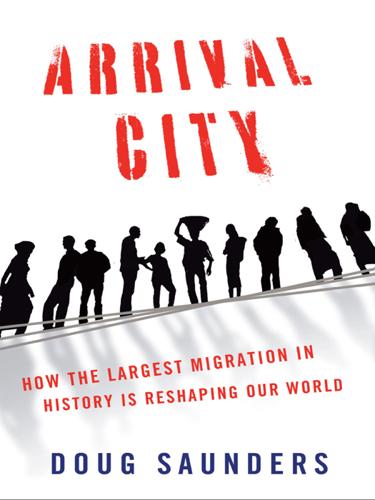
Arrival City
by
Doug Saunders
Published 22 Mar 2011
Such social gatherings were no longer possible in the new apartments or the useless, anonymous public square.4 Despite its poverty, the old neighborhood’s density, its mix of business and residences, and its privately owned space and access to the street gave it a potential for human mixing, mutual security, and entrepreneurship that could never exist in a low-density project. From the beginning, its residents knew it would become “the projects,” a place without hope of arrival. Jacobs was inspired by this shock of realization to write The Death and Life of Great American Cities, which argued that urban neighborhoods should be treated as organic entities, permitted to grow, change, and develop functions as their residents desire, without restrictions on usage, intensity, or change. This liberal, organic view of urbanism was shared by the sociologist William Whyte, who demonstrated the importance of density and concentration, and the architect-planner Oscar Newman, whose 1972 study, Defensible Space, demonstrated that dense, privately owned spaces with access to the street created a community sense of self-surveillance and security.5 These ideas influenced a generation of urban thinkers and played a huge role in the revitalization of the urban cores of Western cities in the 1970s and ’80s.
…
Housing Policy Debate 15, no. 1 (2004): 3. 10 ARRIVING IN STYLE 1 Gerben Helleman and Frank Wassenber, “The Renewal of What Was Tomorrow’s Idealistic City, Amsterdam’s Bijlmermeer High-Rise,” Cities 21, no. 1 (2004); Ronald Van Kempen et al., eds., Restructuring Large Housing Estates in Europe (Bristol: The Policy Press, 2005). 2 Helleman and Wassenber, “The Renewal of What Was Tomorrow’s Idealistic City, Amsterdam’s Bijlmermeer High-Rise,” 8. 3 Maurice Crul and Liesbeth Heering, eds., The Position of the Turkish and Moroccan Second Generation in Amsterdam and Rotterdam (Amsterdam: Amsterdam University Press, 2008), 63–85, 166. 4 Doug Saunders, “Citizen Jane,” The Globe and Mail, Oct. 11, 1997. 5 William H. Whyte, City: Rediscovering the Center (New York: Doubleday, 1989); Oscar Newman, Defensible Space: Crime Prevention through Urban Design (New York: MacMillan, 1972). 6 Jane Jacobs, The Death and Life of Great American Cities (New York: Random House, 1961), 221. 7 Alice Coleman, Utopia on Trial: Vision and Reality in Planned Housing (London: Longwood, 1985). 8 Narayan, Pritchett and Kapoor, Moving Out of Poverty, 223–72. 9 Recent exposés of the failure of aid include Dambisa Moyo, Dead Aid: Why Aid Is Not Working and How There Is Another Way for Africa (London: Allen Lane, 2009); William Easterly, The White Man’s Burden: Why the West’s Efforts to Aid the Rest Have Done So Much Ill and So Little Good (Oxford: Oxford University Press, 2007).
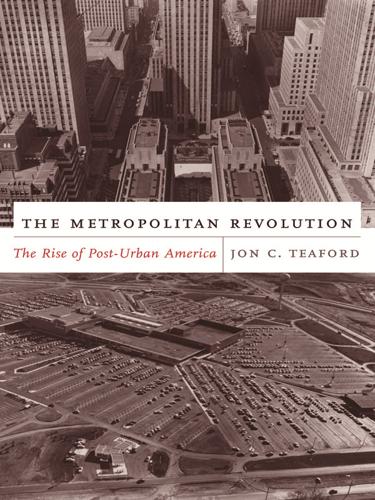
The Metropolitan Revolution: The Rise of Post-Urban America
by
Jon C. Teaford
Published 1 Jan 2006
Designed to link the Holland Tunnel on Manhattan’s West Side with the Manhattan and Williamsburg bridges across the East River, the expressway would have cut a giant swath through Lower Manhattan, forcing almost two thousand families from their homes and displacing over eight hundred businesses. Jacobs attacked the expressway as a “monstrous and useless folly” and dismissed her opponents’ contentions as “piffle.”102 Eventually, Jacobs again triumphed; the expressway was never built. While Jacobs was embroiled in the West Village clash, her highly influential book The Death and Life of Great American Cities appeared, explaining the urban vision underlying her protests. Rejecting renewal dogma, she wrote: “There is a wistful myth that if only we had enough money to spend … we could wipe out all our slums in ten years, reverse decay in the great, dull gray belts that were yesterday’s and day-before-yesterday’s suburbs, anchor the wandering middle class and its wandering tax money, and perhaps even solve the traffic problem.”
…
Clarence Davies III, Neighborhood Groups and Urban Renewal (New York: Columbia University Press, 1966), p. 88. 99. Ibid., p. 94. 100. New York Times, 19 October 1961, p. 1. 101. Davies, Neighborhood Groups and Urban Renewal, p. 104. 102. New York Times, 7 December 1962, p. 32. 103. Jane Jacobs, The Death and Life of Great American Cities (New York: Random House, 1961), p. 4. 104. Ibid., pp. 9–10. 105. Ibid., p. 50. 4. The Debacle 1. “Can the Big Cities Ever Come Back?” U.S. News & World Report, 4 September 1967, pp. 28, 31. 2. Robert A. Beauregard, Voices of Decline: The Postwar Fate of US Cities (Oxford: Blackwell, 1993), p. 201. 3.

Exponential: How Accelerating Technology Is Leaving Us Behind and What to Do About It
by
Azeem Azhar
Published 6 Sep 2021
, National Defense University Press, 12 July 2016 <http://ndupress.ndu.edu/Media/News/News-Article-View/Article/834357/will-technological-convergence-reverse-globalization/> [accessed 6 September 2020]. 26 Nick Butler, ‘US Energy Independence Has Its Costs’, Financial Times, 2019 <https://www.ft.com/content/20870c24-0b86-11ea-b2d6-9bf4d1957a67> [accessed 10 May 2021]. 27 ‘Urban Population (per cent of Total Population)’, World Bank Data <https://data.worldbank.org/indicator/SP.URB.TOTL.IN.ZS> [accessed 11 January 2021]. 28 Azeem Azhar, ‘Don’t Call Time on the Megacity’, Exponential View, 20 May 2020 <https://www.exponentialview.co/p/-dont-call-time-on-the-megacity> [accessed 13 January 2021]. 29 Genevieve Giuliano, Sanggyun Kang and Quan Yuan, ‘Agglomeration Economies and Evolving Urban Form’, The Annals of Regional Science, 63(3), 2019, pp. 377–398 <https://doi.org/10.1007/s00168-019-00957-4>. 30 Cheng Ting-Fang, ‘How a Small Taiwanese City Transformed the Global Chip Industry’, Nikkei Asia, 15 December 2020 <https://asia.nikkei.com/Business/Technology/How-a-small-Taiwanese-city-transformed-the-global-chip-industry> [accessed 13 January 2021]. 31 Jane Jacobs, The Death and Life of Great American Cities (New York: Random House, 1961), p. 31. 32 West, Scale, pp. 281–88. 33 ‘Bright Lights, Big Cities’, The Economist, 4 February 2015 <https://www.economist.com/node/21642053> [accessed 20 March 2021]. 34 Jeff Desjardins, ‘By 2100 None of the World’s Biggest Cities Will Be in China, the US or Europe’, World Economic Forum, 20 July 2018 <https://www.weforum.org/agenda/2018/07/by-2100-none-of-the-worlds-biggest-cities-will-be-in-china-the-us-or-europe/> [accessed 20 March 2021]. 35 ‘Cities Worldwide Will Struggle, but Will Avoid a Mass Exodus’, The Economist, 17 November 2020 <https://www.economist.com/the-world-ahead/2020/11/17/cities-worldwide-will-struggle-but-will-avoid-a-mass-exodus> [accessed 20 March 2021]. 36 ‘COVID-19 and the Myth of Urban Flight’, Knowledge@Wharton, 1 December 2020 <https://knowledge.wharton.upenn.edu/article/covid-19-and-the-myth-of-urban-flight/> [accessed 13 January 2021]. 37 Samrat Sharma, ‘India’s Rural-Urban Divide: Village Worker Earns Less than Half of City Peer’, Financial Express, 12 December 2019 <https://www.financialexpress.com/economy/indias-rural-urban-divide-village-worker-earns-less-than-half-of-city-peer/1792245/> [accessed 18 March 2021]. 38 ‘Is There Really an Ever-Widening Rural-Urban Divide in Europe’, Euler Hermes Global, 17 July 2019 <https://www.eulerhermes.com/en_global/news-insights/economic-insights/Is-there-really-an-ever-widening-rural-urban-divide-in-Europe.html> [accessed 18 March 2021]. 39 Patrick Greenfield, ‘Uber Licence Withdrawal Disproportionate, Says Theresa May’, The Guardian, 28 September 2017 <http://www.theguardian.com/technology/2017/sep/28/uber-licence-withdrawal-disproportionate-says-theresa-may> [accessed 23 March 2021]. 40 ‘Why Cities and National Governments Clash over Migration’, Financial Times, 4 June 2019 <https://www.ft.com/content/319ec1f6-5d25-11e9-840c-530737425559>. 41 John Perry Barlow, ‘A Declaration of the Independence of Cyberspace’, January 1996 <https://www.eff.org/cyberspace-independence> [accessed 7 January 2020]. 42 Andrei Soldatov Borogan Irina, ‘How the 1991 Soviet Internet Helped Stop a Coup and Spread a Message of Freedom’, Slate, August 2016 <https://slate.com/technology/2016/08/the-1991-soviet-internet-helped-stop-a-coup-and-spread-a-message-of-freedom.html> [accessed 31 July 2020]. 43 Berhan Taye and Sage Cheung, ‘The State of Internet Shutdowns in 2018’, Access Now, 8 July 2019 <https://www.accessnow.org/the-state-of-internet-shutdowns-in-2018/> [accessed 19 July 2020]. 44 Claudia Biancotti, ‘India’s Ill-Advised Pursuit of Data Localization’, Pieterson Institute for International Economics, 9 December 2019 <https://www.piie.com/blogs/realtime-economic-issues-watch/indias-ill-advised-pursuit-data-localization> [accessed 20 March 2021]. 45 DLA Piper, Data Protection Laws of the World. 46 Alan Beattie, ‘Data Protectionism: The Growing Menace to Global Business’, Financial Times, 14 May 2018 <https://medium.com/financial-times/data-protectionism-the-growing-menace-to-global-business-f994da37e9e2> [accessed 26 March 2021]. 47 Ian Bremmer, ‘Why We Need a World Data Organization.
…
I shall not comply with your requirement to remove this picture.’, Aftenposten, 8 September 2016 <https://www.aftenposten.no/meninger/kommentar/i/G892Q/dear-mark-i-am-writing-this-to-inform-you-that-i-shall-not-comply-wit> [accessed 1 October 2020] Hardin, Garrett, ‘The Tragedy of the Commons’, Science, 162(3859), 1968, pp. 1243–1248 <https://doi.org/10.1126/science.162.3859.1243> Haskel, Jonathan, and Stian Westlake, Capitalism without Capital: The Rise of the Intangible Economy (Princeton, NJ: Princeton University Press, 2018) Holzhausen, Arne, and Timo Wochner, ‘Is There Really an Ever-Widening Rural-Urban Divide in Europe’, Euler Hermes Global, 17 July 2019 <https://www.eulerhermes.com/en_global/news-insights/economic-insights/Is-there-really-an-ever-widening-rural-urban-divide-in-Europe.html> [accessed 18 March 2021] ‘How Covid-19 Is Revealing the Impact of Disinformation on Society’, King’s College London, 25 August 2020 <https://www.kcl.ac.uk/news/how-covid-19-is-revealing-the-impact-of-disinformation-on-society> [accessed 3 January 2021] Howe, Jeff, ‘The Rise of Crowdsourcing’, Wired, 1 June 2006, <https://www.wired.com/2006/06/crowds/> [accessed 28 September 2020] Intangible Asset Market Value Study, Ocean Tomo <https://www.oceantomo.com/intangible-asset-market-value-study/> [accessed 27 August 2020] Jacobs, Jane, The Death and Life of Great American Cities (New York: Random House, 1961) Janeway, William H., Doing Capitalism in the Innovation Economy: Reconfiguring the Three-Player Game between Markets, Speculators and the State (Cambridge, UK: Cambridge University Press, 2018) Jean, Joel, Patrick Richard Brown and Institute of Physics (Great Britain), Emerging Photovoltaic Technologies (Bristol, UK: IOP Publishing, 2020) <https://iopscience.iop.org/book/978-0-7503-2152-5> [accessed 12 October 2020] Kallenborn, Zachary, and Philipp Bleek, ‘Drones of Mass Destruction: Drone Swarms and the Future of Nuclear, Chemical, and Biological Weapons’, War On the Rocks, 14 February 2019 <https://warontherocks.com/2019/02/drones-of-mass-destruction-drone-swarms-and-the-future-of-nuclear-chemical-and-biological-weapons/> [accessed 26 April 2021] Karlis, Nicole, ‘DoorDash Drivers Make an Average of $1.45 an Hour, Analysis Finds’, Salon, 19 January 2020 <https://www.salon.com/2020/01/19/doordash-drivers-make-an-average-of-145-an-hour-analysis-finds/> [accessed 27 March 2021] Katsifis, Dimitrios, ‘The CMA Publishes Final Report on Online Platforms and Digital Advertising’, The Platform Law Blog, 6 July 2020 <https://theplatformlaw.blog/2020/07/06/the-cma-publishes-final-report-on-online-platforms-and-digital-advertising/> [accessed 30 March 2021] ———, ‘Economic Possibilities for Our Grandchildren’, in Essays in Persuasion (London: Palgrave Macmillan UK, 2010), pp. 321–332 <https://doi.org/10.1007/978-1-349-59072-8_25> Khan, Lina M., ‘Amazon’s Antitrust Paradox’, Yale Law Journal, 126(3), January 2017, pp. 710–805 Klenert, David, Enrique Fernández-Macías and José-Ignacio Antón, ‘Don’t Blame It on the Machines: Robots and Employment in Europe’, VoxEU, 24 February 2020 <https://voxeu.org/article/dont-blame-it-machines-robots-and-employment-europe> [accessed 10 September 2020] Klinger, Joel, Juan Mateos-Garcia, and Konstantinos Stathoulopoulos, ‘A Narrowing of AI Research?’
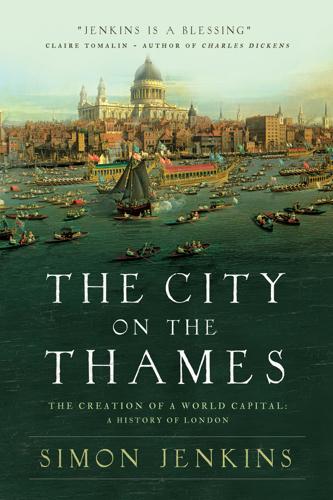
The City on the Thames
by
Simon Jenkins
Published 31 Aug 2020
Back gardens were replaced by unpoliced open space. Rather than house more people, the new blocks housed fewer. From 1950 to 1970, London’s population fell by 9 per cent and that of Inner London by 17 per cent. The concept of a city neighbourhood was analysed at the time by the American sociologist, Jane Jacobs, in her The Death and Life of Great American Cities (1961). Jacobs’s account of why people liked streets was rooted in her understanding of their social geography. It was that of the front door, its steps, the line of vision down a road from overlooking windows, and less tangible factors such as the nature and continuity of tenancy, family structure and employment.
…
Dorothy 110 Georgian Group (conservation group) 284 German immigrants 206–7, 229 Gerrard Street 84, 207 Ghent 26 Gherkin (30 St Mary Axe; skyscraper) 290, 310, 312 Gibbon, Edward 107 Gibbs, James 95, 102, 105, 108 Gibraltar 94 Gidea Park 210 Gilbert, Sir William Schwenk 182, 200 Gillray, James 130 gin drinking 96, 111–12, 276, 318 GLA see Greater London Authority Gladstone, William Ewart 164, 168, 176, 184 Glasgow 131, 161, 175, 278 Glass, Ruth 271 GLC see Greater London Council GLDP see Greater London Development Plan Globe Theatre 52 Glorious Revolution (1688) 89–91, 103 Gloucester Road 179 Godwin of Wessex 22 Golden Lane Estate 252–3 Golders Green 203, 209, 229–30; Hippodrome (theatre) 230 Gomme, Sir Laurence 191 Good Friday Agreement (1999) 290–91 Goodwin, Sir Reg 285 Google (technology company) 330 Gordon, Lord George 117 Gordon riots (1780) 117–18, 119 gothic architecture 30, 40, 51, 81; revival 152, 153, 178, 198 Gracechurch Street 19, 284, 310, 338 Grafton, Henry FitzRoy, 1st Duke of 124, 125 Grand Remonstrance (1641) 63–4, 90 grand tour 105 Grant, Bernie 299 Graves, Robert 284 Gray’s Inn 42, 85, 215 Gray’s Inn Road 139 Great Central Railway 194–5 Great Eastern, SS 175 Great Eastern Railway 165, 166, 209–10 Great Exhibition (1851) 170, 171, 181 Great Fire (1666) 1, 75–6, 80, 81; post-fire reconstruction 76–83, 86, 244 Great Northern Railway 165 Great Plague (1665) 1, 73–5, 80 Great Portland Street 220; Holy Trinity Church 137 Great Reform Act (1832) 149–50, 155, 175 Great Stink (1858) 164, 259 Great Storm of 1987 296 Great War (1914–18) 214–17, 234, 237, 238, 240 Great West Road 232 Great Western Railway 165, 209–10 Greater London Authority (GLA) 308–9 Greater London Council (GLC): abolition 288–9; elections 264, 274–5, 280, 282, 285, 287; formation 263; housing estates 266, 269–70, 285; powers 263–5, 287; planning and redevelopment 263–4, 265, 278–83, 285, 291, 292 Greater London Development Plan (GLDP) 263, 279–80 Greater London Regional Planning Committee 226 Greece, ancient 4, 137 Greek immigrants 172, 206 Green, William Curtis 210 green belt 55, 77, 230–31, 242, 251 Green Park 46, 70, 84, 147 Greenwich 17, 95, 125, 135, 156, 182, 210; council housing estates 266, 269; Placentia Palace 51; Queen’s House 59; view from 5, 265 Gregory the Great, Pope 17, 18 Grenfell Tower fire (2017) 322 Gresham, Sir Richard 48–9 Gresham, Sir Thomas 49–50, 84 Gresham College 49 Grey, Charles, 2nd Earl 149 Gropius, Walter 232 Grossmith, George and Weedon, Diary of a Nobody 180, 181 Grosvenor, Sir Richard 101 Grosvenor, Sir Thomas 101 Grosvenor estate 101, 139–40, 165–6, 169, 199, 250 Grosvenor House 220 Grosvenor Square 73, 103, 118, 123, 126, 187, 230, 259 Guildhall 31, 39, 64, 76, 79, 188; site 14 Guildhall Yard 9 guilds and livery companies 26, 29, 31, 34–5, 41, 80, 86, 88, 93, 116, 198 Gunnersbury 112 Guy’s Hospital 176 Gwynn, John 119, 242 Hackney 143, 218, 243, 307, 329; churches 136, 137; council housing estates 266; slum clearance 266 Hackney, Borough of 289, 301 hackney carriages and taxis 67, 167, 205 Hackney Downs (park) 183 Hackney Wick 329 Hadrian, Roman Emperor 11 Hainault 210 Hair (musical) 261 Haley, Bill 248 Hamley, William 128 Hammersmith 144, 171, 256 Hammersmith Bridge 317 Hammersmith Palais 144 Hampstead 112, 136, 141, 144, 164, 171, 183, 217, 264; Church Row 125; Fitzjohn’s Avenue 183; Haverstock Hill 204; Kenwood House 59, 123; station 203 Hampstead Garden Suburb 209, 210 Hampstead Heath 182–3, 203, 309; Parliament Hill Fields 5, 183 Hampton Court Palace 45, 91, 92 Handel, George Frideric 108, 111; Water Music 108 Hanover Square 102, 103, 105, 128, 259; St George’s Church 102, 110, 189 Hans Town 104, 139–40, 179 Hanseatic League 32, 34 Hanway, Jonas 119 Harald Hardrada, King of Norway 24 Hardwick, Thomas 137 Hardwick Hall 52 Harley family 102–3 Harley Street 306 Harlow 251 Harold, King 22, 24–5, 27 Harrington estate 179 Harrod, Charles Digby 181 Harrod’s (department store) 181, 200, 290 Harrow 231 ‘harrowing of the north’ (11th century) 25 Harvey Nichols (department store) 181 Hastings, Battle of (1066) 24 Hatchard, John 128 Hatfield 251 Hatherley, Owen 311 Hatton Garden 82 Haussmann, Georges-Eugène, redevelopment of Paris 134, 173–4, 180, 199, 326 Havering, Borough of 331 Hawksmoor, Nicholas 95, 105 Haydn, Joseph 128 Haymarket 8, 72, 84, 186; New Zealand House 257, 280; theatres 128, 181 Hayward Gallery 247 Hazlitt, William 183 Heath, Sir Edward 274, 275, 283 Heathrow 8; airport 239, 290, 291, 303, 307, 324 Hellfire Club 116 Hemel Hempstead 251 Hendon 207, 223, 229 Henrietta Maria of France, Queen Consort 61, 72 Henrietta Street 61, 128 Henry II, King 28, 30 Henry III, King 30–31, 64 Henry IV, King 39 Henry IV, King of France 88 Henry V, King 39 Henry VII, King 39, 40, 42, 43, 153 Henry VIII, King 42, 43–7, 48, 49, 50, 51 Herbert, Sir Edwin (later Baron Tangley) 263, 264 heroin 277 Heseltine, Michael, Baron 279, 292 Hess, Myra 236 Hibbert, Christopher 84 high-rise buildings see tall buildings Highbury 207 Highgate 38, 75, 76, 182, 183, 217; Highpoint One 232; Whittington Hospital 39 Highway, The (East End) 131 Hill, Octavia 183, 186–7, 223 Hilton, Conrad 257 Hilton Hotel 257, 265, 290 Hippodrome (theatre) 200 Hitler, Adolf 224, 234, 235, 240, 241 Hobhouse, Hermione 141, 169 Hoby, George 138 Hogarth, William 106, 107, 108, 111–12, 118, 198 Hogenberg, Frans 50–51 Holbein, Hans 62 Holborn 11, 51, 65, 85, 165, 197, 264, 281; Barnard’s Inn Hall 49; Staple Inn 76, 86 Holden, Charles 227, 229 Holford, William, Baron 251, 281 Holland, Henry 104, 139–40 Holland House 169–70 Holland Park 179 Hollar, Wenceslaus 63 Holy Trinity Church, Marylebone 137 Holy Trinity Church, Sloane Street 198 Holy Trinity Priory, Aldgate 27, 45–6 Home, Elizabeth, Countess of 123–4 homelessness and rough sleeping 160, 188, 215, 298, 321, 331, 336 homosexuality 260, 261, 299 Hong Kong 253, 324 Honorius, Roman Emperor 13 Hooke, Robert 70, 77, 80 Hoover factory 228 Hopkins, Sir Michael 294 Horse Guards Parade 98, 284 horse-drawn transport 71, 144, 156, 167, 177, 193, 205 Hounslow Heath 112 Houses of Parliament see Palace of Westminster Housing Act (1969) 273 housing associations 298, 321 Howard de Walden family 103, 124, 220 Howard, Keble, The Smiths of Surbiton 211 Howe, Sir Geoffrey (later Baron Howe of Aberavon) 292 Hoxton 82, 140, 181, 216, 300, 307 Huggin Hill 13, 338 Hugo, Victor 174 Huguenots 48, 88, 93, 94, 96, 107–8, 116, 275 Hull 32 Humber (river) 324 Hundred Years War 34, 38, 39 Hungerford Market 145 Hunt, Leigh 183 Hunt, William Holman, The Awakening Conscience 142 hunting grounds 46–7, 132 Hus, Jan 38 Hyams, Harry 255–6, 258, 314 Hyde Park 46, 59, 70, 170, 174, 219, 304; Rotten Row 101; Serpentine 225; underpass 197 Hyde Park Corner 65, 100, 140, 284, 321, 325; Apsley House 147, 149, 221 Ibsen, Henrik 182 Iceni (tribe) 10, 17 IMF (International Monetary Fund) 239 Imperial College 171, 284 Imperial Institute 284 Improved Industrial Dwellings Company 187 ‘In and Out’ (Naval and Military) Club 147, 221 Independents (nonconformist church) 66 Indian immigrants 275 industrial unrest 116, 148, 189, 219, 233, 276, 292 infant mortality: London 112, 176, 216; Paris 173 Inner London Education Authority 264–5, 288 Inner Temple 42 inns of court 42, 85, 215 Institute for Public Policy Research 303 International Monetary Fund (IMF) 239 Interregnum see Commonwealth of England IRA bombing campaign (1970s) 290–91, 304 Iraq invasion (2003) 304 Irish immigrants 95, 117, 275 Iron Age 8 Ironsides (Parliamentarian cavalry) 68 Irving, Sir Henry 182 Isabella I, Queen of Castile 42 Islamist terrorism 291, 304–5 Isle of Dogs 131, 175, 292–3, 294, 300; Samuda estate 267; Spire London 313–14, 324; see also Canary Wharf Isle of Wight 132, 133; Osborne House 139, 162 Islington 75, 76, 112, 136, 143, 171, 182, 242, 243, 271, 272, 280, 300; Angel 256; City Road 109, 325; Copenhagen Fields 163; Newington Green 136; Sadler’s Wells Theatre 181, 329 Italian immigrants 32, 34, 172, 206, 207 Jack the Ripper 185 Jackson, Alan 231, 233 Jackson, Eric 257 Jacob’s Island 185 Jacobs, Jane, The Death and Life of Great American Cities 268 Jamaica 94 James I, King 54, 57–60, 85 James II, King 86, 88–90 James, Henry 186 James Street (Covent Garden) 61 Jeffreys, George, 1st Baron 88 Jenkins, Roy, Baron Jenkins of Hillhead 260, 261, 277 Jermyn Street 138 Jerusalem, Holy Sepulchre 28 jewellery trade 82, 206 Jews 31, 67, 136, 207, 229, 275; expulsion from England (1290) 32, 67 John, King 27, 29, 30 John of Gaunt, Duke of Lancaster 35, 36, 38 John Barnes (department store) 181 Johns, Ted 293 Johnson, Boris 315–17, 318, 319, 324, 328 Johnson, Samuel 98, 107, 109, 118, 126 Jonathan’s coffee house 93 Jones, Sir Horace 179 Jones, Inigo 58–9, 61–2, 81, 85, 105, 122, 333 Jonson, Ben 52 Joseph, Sir Keith (later Baron Joseph) 269 Joseph, Sir Maxwell 250 journalism see newspapers and journalism Jubilee Line 204, 281, 294–5 Julius Caesar 9 Jutes 16–17 Keats, John 182 Kellett, John 168, 209 Kennedy, John F. 303 Kennington 194 Kennington Common, Chartist rally (1848) 162 Kensal Green 164 Kensington: origins of name 17; 17th century 76, 91; 18th century 97, 125; 19th century 168, 169–71, 179, 181; 20th century 201, 230, 243, 263, 271, 284; 21st century 323; see also North Kensington; South Kensington Kensington and Chelsea, Royal Borough of 264, 270, 323 Kensington Gardens 46, 91, 169–70 Kensington Palace (formerly Nottingham House) 91, 97, 169, 263, 303 Kensington Palace Gardens 169–70 Kent, William 97, 98, 104, 105, 220 Kentish Town 125, 172, 272 Kenton 232 Kenwood House 59, 123 Kew Gardens 296 Kew Palace 89 Khan, Sadiq 317, 318 Kiev 21 Kilburn 264, 272, 275 King Street (City) 79 King Street (Covent Garden) 61 King William Street 167, 194 King’s Cross 143, 307, 329–30, 339; station 148, 165, 167, 179 King’s Lynn 32 King’s Men (theatre company) 57 King’s Road 140, 261, 323 Kingsland Road 10, 275 Kingston-upon-Thames 113, 232; bypass 228; School of Art 252–3 Kingsway 197 Kip, Jan 89 Kneller, Sir Godfrey 89 Knight, Frank and Rutley (estate agents) 220 Knight, Valentine 77 Knights of St John 27 Knights Templar 27–8 Knightsbridge 139–40, 179, 199, 263, 283; Barracks 257; Bowater House 256; department stores 181, 200, 290; One Hyde Park 256, 323 Knyff, Leonard 89 Koh-i-Noor diamond 170 Komisarjevsky, Theodore 232 Koolhaas, Rem 310 Kossuth, Lajos 172 Kray family 277 Kuala Lumpur 328 Kubrick, Stanley 269 Kynaston, David 295 Labelye, Charles 114 Ladbroke estate 141–2, 170, 280, 328 Lady Chatterley trial (1960) 260 Ladykillers, The (film) 248 Lagos 326 Lamb, Charles 127, 183 Lambeth: 18th century 113, 120, 123; 19th century 166, 181, 185; 20th century 201; 21st century 185, 339 Lambeth, Borough of 275, 289, 311, 321; town hall 201 Lambeth Palace 35, 51, 61 Lancaster Gate 141, 263 Lancaster House 147, 197 Land Securities (property company) 249 Landseer, Sir Edwin 146–7 Langham Place 222; All Souls Church 135; Broadcasting House 222; Langham Hotel 284 languages and dialects 16, 17, 21, 22, 26, 30, 40, 161, 299, 337 Lansbury, George 218–19, 225 Lansdowne House 220–21 Larkin, William 59 Lasdun, Sir Denys 247 Laurence Pountney Hill 94, 338 Lavender Hill Mob, The (film) 248 Lawrence, D.
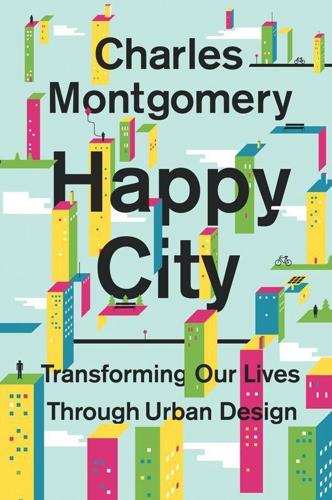
Happy City: Transforming Our Lives Through Urban Design
by
Charles Montgomery
Published 12 Nov 2013
I had been warned about the pathological aggression of Parisian drivers, and the streets were still full of them. But Britton and I were not the only ones on two wheels. There were dozens of other Vélib’ users around us. There were so many of us out there that drivers had to pay attention. They had to make room. In The Death and Life of Great American Cities, Jane Jacobs described the ballet that takes place on crowded sidewalks as people make eye contact and find their way around one another. I felt a similar if supercharged dynamic coming to life in Paris’s traffic lanes. With cars and bikes and buses mixed together, none of us could be sure what we would find on the road ahead of us.
…
In 2008, for example: Hawthorne, Christopher, “Atlantic on the Move,” Los Angeles Times, May 13, 2012, www.latimes.com/entertainment/news/arts/boulevards/la-ca-atlantic-boulevard-los-angeles-index,0,378106.htmlstory (accessed October 22, 2012). More than three hundred cities: Borys, Hazel, and Emily Talen, “Form-Based Codes? You’re Not Alone,” PlaceShakers and NewsMakers, www.placemakers.com/how-we-teach/codes-study (accessed April 29, 2013). 13. Save Your City, Save Yourself Jane Jacobs: Jacobs, Jane, The Death and Life of Great American Cities (New York: Random House, 1961). writing haiku: Naparstek, Aaron, Honku: The Zen Antidote to Road Rage (New York: Random House, 2003). Jon Orcutt: Gleaned from Naparstek, Streetsblog, and DOT bios and press releases. Chan K’in Viejo: “Chan K’in Viejo, 104; Led Mexican Tribe,” New York Times, January 2, 1997, www.nytimes.com/1997/01/02/world/chan-k-in-viejo-104-led-mexican-tribe.html (accessed July 1, 2009).

The Bookshop: A History of the American Bookstore
by
Evan Friss
Published 5 Aug 2024
In the West Village, a fifty-one-year-old said he preferred to park near the tables: “No one’s going to break into my car, because the bookstore is always open.” The booksellers understood as much. “I’m a public character,” Hasan said, referring to a concept from Jane Jacobs’s most influential book, The Death and Life of Great American Cities. A Village resident herself, Jacobs argued that people like Hasan were what made a neighborhood a neighborhood. A comfortingly regular sight, they spread neighborhood news, added vitality, and gained community trust. “People like me are the eyes and ears of this street,” Hasan maintained.
…
GO TO NOTE REFERENCE IN TEXT A few residents maintained: Ladd, “Bookseller Boom on City Streets.” GO TO NOTE REFERENCE IN TEXT a fifty-one-year-old: David Bahr, “2 Peddlers, New Tension,” NYT, October 13, 1996. GO TO NOTE REFERENCE IN TEXT “People like me are”: Jane Jacobs, The Death and Life of Great American Cities (New York: Vintage, 1963), 35, 68–71; and Duneier, Sidewalk, 6, 17–18. GO TO NOTE REFERENCE IN TEXT It was how: Brown and Duneier, Sidewalk. GO TO NOTE REFERENCE IN TEXT One of the attorneys: Duneier, Sidewalk, 234–39. GO TO NOTE REFERENCE IN TEXT But they still: Local Law No. 33 (1982); and Local Law No. 45 (1993).
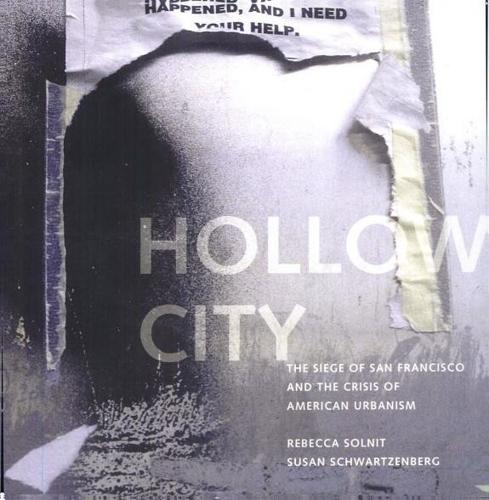
Hollow City
by
Rebecca Solnit
and
Susan Schwartzenberg
Published 1 Jan 2001
report went the neighborhood because single-family houses had been converted into apartments, convalescent hospitals and rooming houses and because (It is "stores, industry and houses are haphazardly intermingled." just this intermingling that suburban design sought to eliminate and that Jane Jacobs's 1961 manifesto, The Death and Life of Great American Cities, celebrates as key to the vitality of urban None of life.) the reports mentions that Fillmore Street had Harlem of the West, where jazz become the clubs and a lively nightlife flourished. My octogenarian neighbor who emigrated to the Western Addition from Texas around the time of the Second World War still speaks fondly of the elegant arches of lights that used to adorn Fillmore Street, of the six movie theaters, the of the street its hotels with wonderful jazz clubs, the liveliness at all hours.

City: A Guidebook for the Urban Age
by
P. D. Smith
Published 19 Jun 2012
Harcourt and Jens Ludwig, ‘Broken Windows: New Evidence from New York City and a Five City Social Experiment’, University of Chicago Law Review, 73 (2006), cited from Anna Minton, Ground Control: Fear and Happiness in the Twenty-First-Century City (London: Penguin, 2009), 146. 54. Jane Jacobs, The Death and Life of Great American Cities (1961; repr. Harmondsworth: Penguin, 1994), 42–7. 55. Paul Lewis, ‘CCTV in the sky: police plan to use military-style spy drones’, Guardian (23 January 2010); cf. Sophie Body-Gendrot, ‘Confronting Fear’, in Ricky Burdett and Deyan Sudjic, eds, The Endless City (London: Phaidon, 2007), 356, and Minton (2009), 31. 56.
…
Axelrod, Inventing Autopia: Dreams and Visions of the Modern Metropolis in Jazz Age Los Angeles (Berkeley: University of California Press, 2009), 245. 60. Andrzej J. L. Zieleniec, ‘Parks’, in Hutchison (2010), 583. It is a phrase scorned by Jane Jacobs as ‘science-fiction nonsense’: The Death and Life of Great American Cities (1st 1961; repr. London: Penguin, 1994), 101. 61. Zieleniec, in Hutchison (2010), 583. 62. Zieleniec, in Hutchison (2010), 584. 63. Strabo cited from Michael Seymour, ‘Classical Accounts’, in I. L. Finkel and M. J. Seymour, eds, Babylon: Myth and Reality (London: British Museum Press, 2008), 107. 64.
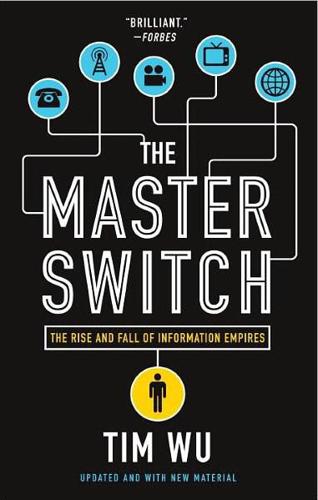
The Master Switch: The Rise and Fall of Information Empires
by
Tim Wu
Published 2 Nov 2010
Schumacher, in 1973 wrote Small Is Beautiful: Economics As If People Mattered, developing the concept of “enoughness” and sustainable development.11 Jane Jacobs, the great theorist of urban planning, expresses a no less incendiary disdain for centralization, and as in Hayek, the indictment is based on an inherent neglect of humanity. In her classic The Death and Life of Great American Cities, she relies on careful firsthand observations made while walking around cities and new developments to determine how Olympian planners like Robert Moses were going wrong.12 There was no understanding, let alone regard, for the organic logic of the city’s neighborhoods, a logic discernible only on foot.
…
Leopold Kohr, The Breakdown of Nations (London: Routledge & Paul, 1957), ix. 11. Schumacher’s idea of “enoughness” stemmed from his studies of what he called “Buddhist economics.” See Ernst F. Schumacher, Small Is Beautiful: Economics As If People Mattered (New York: Harper & Row, 1973). 12. Jane Jacobs, The Death and Life of Great American Cities (New York: Vintage Books, 1961). 13. Frederick W. Taylor, The Principles of Scientific Management (New York: Harper & Bros., 1911). 14. Jon Postel wrote this into the “Robustness Principle,” Section 2.10 of the Transmission Control Protocol (January 1980), available at http://tools.ietf.org/html/rfc761#section-2.10. 15.
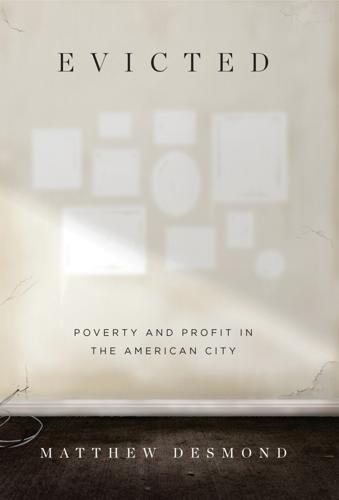
Evicted: Poverty and Profit in the American City
by
Matthew Desmond
Published 1 Mar 2016
“The public peace—the sidewalk and street peace—of cities is not kept primarily by the police, necessary as police are. It is kept primarily by an intricate, almost unconscious, network of voluntary controls and standards among the people themselves, and enforced by the people themselves.” So wrote Jane Jacobs in The Death and Life of Great American Cities. Jacobs believed that a prerequisite for this type of healthy and engaged community was the presence of people who simply were present, who looked after the neighborhood. She has been proved right: disadvantaged neighborhoods with higher levels of “collective efficacy”—the stuff of loosely linked neighbors who trust one another and share expectations about how to make their community better—have lower crime rates.3 A single eviction could destabilize multiple city blocks, not only the block from which a family was evicted but also the block to which it begrudgingly relocated.
…
In other words, unforced movers whose previous move was involuntary were far more likely to cite housing or neighborhood problems as the reason for moving than were unforced movers whose previous move was also unforced. Not only do poor renters disproportionately experience involuntary displacement, but involuntary displacement itself brings about subsequent residential mobility. See Desmond et al., “Forced Relocation and Residential Instability Among Urban Renters.” 3. Jane Jacobs, The Death and Life of Great American Cities (New York: Random House, 1961), 31–32; Robert Sampson, Great American City: Chicago and the Enduring Neighborhood Effect (Chicago: University of Chicago Press, 2012), especially 127, 146–47, 151, 177, 231–32. For an ethnographic take on the uses of public space, see Mitchell Duneier, Sidewalk (New York: Farrar, Straus and Giroux, 1999). 4.
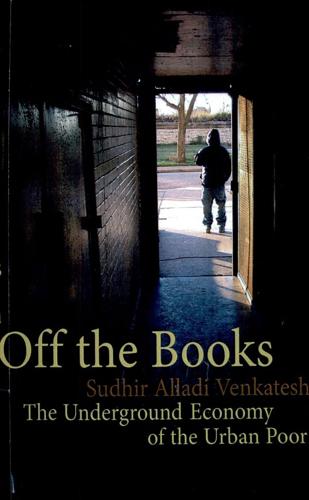
Off the Books
by
Sudhir Alladi Venkatesh
See Mary Patillo, Black Picket Fences: Privilege and Peril in the Black Middle Class (Chicago: University of Chicago Press, 1999). 12. Martin Sanchez Jankowski provides a systematic analysis of how gangs develop relationships with persons and organizations in the wider community. See his Islands in the Street (Berkeley: University of California Press, 1991). 13. For the classic rendition, see Jane Jacobs, The Death and Life of Great American Cities (New York: Vintage, 1961), 30. 14. Robert Sampson has developed the notion of "collective efficacy"—the "working trust and shared willingness of residents to intervene in sharing social control. The concept of collective efficacy captures the link between cohesion—especially working trust—and shared expectations for action."
…
For more information on community policing in Chicago, see also the program evaluation series and community policing working papers published by the Institute for Policy Research at Northwestern University; Wesley Skogan and Susan Hartnett, Community Policing: Chicago Style (New York: Oxford Community Press, 1997); Wesley Skogan, "Community Policing in Chicago," in Community Policing, ed. Geoffrey Alpert and Alex Piquero (Prospect Heights, Ill.: Waveland Press, 1998), 159-174; David Weisburd and Anthony Braga, Prospects and Problems in an Era of Police Innovation: Contrasting Perspectives (Cambridge: Cambridge University Press, 2005). 9. Cf. Jane Jacobs, The Death and Life of Great American Cities (New York: Random House, 1961). 10. Other sociologists examining public space have taken up Jacobs's writings to highlight the capacity of vibrant streetfare to enable social control. Duneier's study of a middle- to upper-class Manhattan neighborhood documented the contribution made by the local street vendors and sidewalk booksellers to the local sense of public safety.

Stacy Mitchell
by
Big-Box Swindle The True Cost of Mega-Retailers
and
the Fight for America's Independent Businesses (2006)
Tolbert, “Minding Our Own Business: Local Retail Establishments and the Future of Southern Civic Community,” Social Forces 83, no. 4 (June 2005): 1309– 28; Robert D. Putnam, Bowling Alone: The Collapse and Revival of American Community (New York: Simon & Schuster, 2000). 8. Charles Tolbert, interview, Sept. 26, 2005. 9. Lyson interview. 10. Jane Jacobs, The Death and Life of Great American Cities (New York: Random House, 1961), 61. 274 NOTES 11. Ibid., 56. 12. Tolbert interview. 13. Ibid. 14. Neal Coonerty, interview, Sept. 22, 2005, and Oct. 7, 2005; Christina Waters, “The Key to the City,” Metro Santa Cruz, Nov. 7–13, 1996; Robin Musitelli, “Community Gets Behind the Books,” Santa Cruz Sentinel, Oct. 18, 1994, 1. 15.
…
Lisa Rother, interview, Jan. 19, 2006; “Taos, New Mexico, Votes to Keep Store Size Limit,” Hometown Advantage Bulletin, Apr. 1, 2003; “Taos, New Mexico, Battles Big Boxes Again,” Hometown Advantage Bulletin, Feb. 1, 2003. 37. For more on European superstore regulation, see Ken Baar, Legislative Tools for Preserving Town Centres and Halting the Spread of Hypermarkets and Malls Outside of Cities (New York: Institute for Transport and Development Policy, Mar. 2002). 38. Jane Jacobs, The Death and Life of Great American Cities (New York: Random House, 1961). 39. Town of North Elba Planning Board, “Statement of Findings and Decision: Proposed Wal-Mart Store,” Jan. 9, 1996. 40. Again, see the Institute for Local Self-Reliance’s Web site at www.newrules .org/retail for more details and the text of these ordinances. 41.
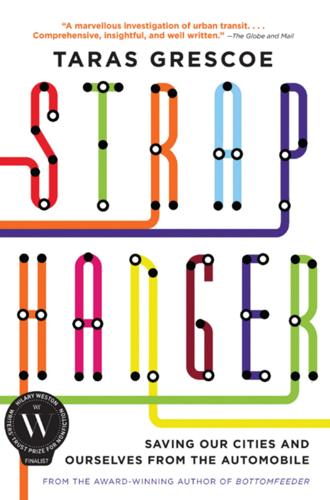
Straphanger
by
Taras Grescoe
Published 8 Sep 2011
From her home on Hudson Street, the author and activist orchestrated theatrical opposition to Moses’s projects, burning cars in effigy in Washington Square, and tossing the stenographer’s paper around the stage of a public hearing to protest the building of the Lower Manhattan Expressway. In The Death and Life of Great American Cities, she pinpointed the appeal of such neighborhoods as Boston’s North End and her own Greenwich Village, arguing that it was the disorderly vestiges of nineteenth-century street life—shops and residences cheek by jowl, with the bartender sweeping his sidewalk keeping an eye on the neighbors’ kids playing hopscotch—that made them safe and viable urban spaces.
…
Grynbaum, Michael M. “Mayor Takes Subway—by Way of SUV.” The New York Times, August 1, 2007. Hood, Clifton. 722 Miles: The Building of the Subways and How They Transformed New York. New York: Simon & Schuster, 1993. “In a Blizzard’s Grasp.” The New York Times, March 13, 1888. Jacobs, Jane. The Death and Life of Great American Cities. New York: Vintage, 1961. Kennedy, Randy. Subwayland: Adventures in the World Beneath New York. New York: St. Martin’s Griffith, 2004. Neuman, William. “Cars Clogging New York? Most Are from the City.” The New York Times, January 12, 2007. “New York’s First Underground Railway.”

The Lonely Century: How Isolation Imperils Our Future
by
Noreena Hertz
Published 13 May 2020
Illusion of Order: The False Promise of Broken Windows Policing (Cambridge, Mass: Harvard University Press, 2001). Held, David. Models of Democracy. Third Edition (Cambridge: Polity Press, 2006). Hortulanus, R., A. Machielse, and L. Meeuwesen, eds. Social Isolation in Modern Society (London: Routledge, 2009). Jacobs, Jane. The Death and Life of Great American Cities (New York: Random House, 1961). Jung, Carl. Memories, Dreams, Reflections. Translated by Clara Winston and Richard Winston. Edited by Aniela Jaffe (New York: Vintage, 1989). Levy, David. Love and Sex With Robots (New York: HarperCollins, 2007). Lynch, James. A Cry Unheard: New Insights into the Medical Consequences of Loneliness (Baltimore: Bancroft Press, 2000).
…
While it does not have the highest total number of people experiencing homelessness, San Francisco has one of the fastest growing homeless populations in the US, having risen a shocking 30% just between 2017 and 2018, by one measure (Jill Cowan, ‘San Francisco’s Homeless Population Is Much Bigger Than Thought, City Data Suggests’, New York Times, 19 November 2019, https://www.nytimes.com/2019/11/19/us/san-francisco-homeless-count.html). 24 James Walker, ‘Invisible in plain sight: fighting loneliness in the homeless community’, Open Democracy, 31 July 2019, https://www.opendemocracy.net/en/opendemocracyuk/invisible-plain-sight-fighting-loneliness-homeless-community/. 25 See Jane Jacobs, The Death and Life of Great American Cities (Random House, 1961). 26 ‘Welcome to the neighbourhood’, Royal Wharf, https://www.royalwharf.com/neighbourhood/. 27 Robert Booth, ‘Subsidised tenants are excluded from pool and gym in London block’, Guardian, 1 November 2018, https://www.theguardian.com/society/2018/nov/01/subsidised-tenants-are-excluded-from-pool-and-gym-in-london-tower. 28 Harriet Grant, ‘Too poor to play: children in social housing blocked from communal playground’, Guardian, 25 March 2019, https://www.theguardian.com/cities/2019/mar/25/too-poor-to-play-children-in-social-housing-blocked-from-communal-playground. 29 The company, for its part, claims that such exclusion was never its policy. 30 Harriet Grant, ‘Disabled children among social tenants blocked from communal gardens’, Guardian, 27 September 2019, https://www.theguardian.com/cities/2019/sep/27/disabled-children-among-social-tenants-blocked-from-communal-gardens. 31 ‘New UWS development could have separate entrance for poorer people’, West Side Rag, 12 August 2013, https://www.westsiderag.com/2013/08/12/new-uws-development-could-have-separate-entrance-for-poorer-people; Adam Withnall ‘“Poor door” controversy extends to Washington DC as affordable housing “wing” given entrance on different street – next to the loading bay’, Independent, 4 August 2014, https://www.independent.co.uk/news/world/americas/poor-door-controversy-extends-to-washington-dc-as-affordable-housing-wing-given-entrance-on-9646069.html; Hilary Osborne, ‘Poor doors: the segregation of London’s inner–city flat dwellers’, Guardian, 25 July 2014, https://www.theguardian.com/society/2014/jul/25/poor-doors-segregation-london-flats. 32 Adam Withnall, ‘“Poor door” controversy extends to Washington, D.C. as affordable housing “wing” given entrance on different street – next to the loading bay’; New York has now closed the loophole that allowed buildings with separate entrances to qualify for the ‘inclusionary housing’ tax break.
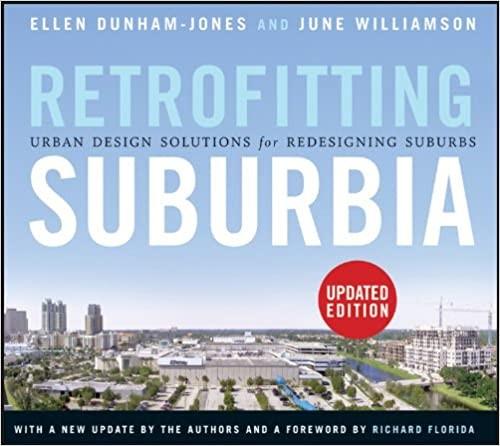
Retrofitting Suburbia, Updated Edition: Urban Design Solutions for Redesigning Suburbs
by
Ellen Dunham-Jones
and
June Williamson
Published 23 Mar 2011
The silver lining to the failure of a big box is the availability of cheap space for alternative uses. This is especially important for nonprofit groups, cultural facilities, or local shops that cannot generally afford new construction or extensive site work yet are in need of central locations to best serve their constituents. In The Death and Life of Great American Cities, published in 1961, Jane Jacobs criticized how urban renewal and large swaths of “one-age construction” robbed cities of older, affordable buildings—a vital asset for diversity. “Chain stores, chain restaurants, and banks go into new construction. But neighborhood bars, foreign restaurants, and pawn shops go into older buildings.
…
Brian Lorch, “Auto-Dependent Induced Shopping: Exploring the Relationship between Power Centre Morphology and Consumer Spatial Behaviour,” Canadian Journal of Urban Research 14:2 (Winter 2005): 364–384. 26 Marlon Boarnet, Randall Crane, Daniel Chatman, and Michael Manville, “Supercenters and the Transformation of the Bay Area Grocery Industry,” Bay Area Economic Forum, 2004. 27 Mitchell, Big-Box Swindle, 121. 28 Wal-Mart has had a successful strategy of opening several stores in an area and closing them after approximately five years (by which time they are generally very successful and have killed off much of the local competition) in order to open a superstore. See Dunham-Jones, “Temporary Contracts.” 29 Mitchell, Big-Box Swindle, 10. 30 Jane Jacobs, The Death and Life of Great American Cities (New York: Vintage, 1961), 188. 31 Several of these examples came from artist Julia Christensen’s website, http://www.bigboxreuse.com. She has a book forthcoming on the subject. 32 Eve M. Kahn, “Thinking Inside the Big Box,” New York Times, May 12, 2005. 33 Michele Schwartz, “Open on Sundays: When Wal-Mart Moves Out, Churches Move In,” Preservation Online, April 21, 2006, available at http://www.nationaltrust.org/Magazine/archives/arch_story/042106p.htm. . 34 Fred Perpall, telephone interview by Ellen Dunham-Jones, December 13, 2007. 35 In 2005 they also expanded a half mile up the street and opened Chelsea’s Kitchen in a former off-trackbetting bar.
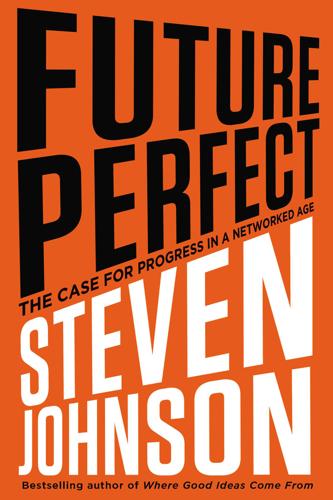
Future Perfect: The Case for Progress in a Networked Age
by
Steven Johnson
Published 14 Jul 2012
Bradford DeLong, at http://econ161.berkeley.edu/econ_articles/reviews/seeing_like_a_state.html, along with Henry Farrell’s response, “Seeing ‘Seeing Like a State’” at http://crookedtimber.org/2008/02/05/seeing-like-seeing-like-a-state/. Hayek’s arguments are nicely summarized in his 1945 essay “The Use of Knowledge in Society,” which appeared in The American Economic Review. Jane Jacobs’s attack on centralized planning appears in her classic work, The Death and Life of Great American Cities. For a comprehensive history of the birth of the Internet, see Where Wizards Stay Up Late, by Matthew Lyon and Katie Hafner, as well as Stewart Brand’s interview with Paul Baran, “Founding Father,” in Wired. I first came across the concept of “positive deviance” in the article “Design Thinking for Social Innovation,” by Tim Brown and Jocelyn Wyatt, in the Stanford Social Innovation Review.

Rendezvous With Oblivion: Reports From a Sinking Society
by
Thomas Frank
Published 18 Jun 2018
People’s voices were often said to be vibrant. As were, say, notes played on an oboe. To apply the adjective to a “community” or a “scene,” on the other hand, was extremely unusual back then. In fact, the word “vibrant” does not seem to appear at all in Jane Jacobs’s 1961 urban classic The Death and Life of Great American Cities, even though that book is often remembered as the manifesto of vibrancy theory. How the expression made the leap from novelty to gold-plated bureaucratic buzzword is anyone’s guess. The real force behind our mania for the vibrant is the nation’s charitable foundations. For organized philanthropy, “vibrant” seems to have become the one-stop solution for all that ails the American polis.
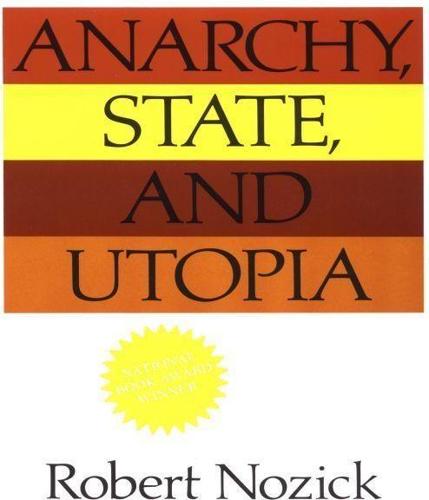
Anarchy State and Utopia
by
Robert Nozick
Published 15 Mar 1974
(See Ludwig von Mises, Socialism, Part II, Human Action. Chapters 4, 7—9.) 7. Microeconomic explanations of the effects of outside intervention in a market, and of the establishment and nature of the new equilibria. 8. Jane Jacobs’ explanation of what makes some parts of cities safe in The Death and Life of Great American Cities (New York: Random House, 1961). 9. The Austrian theory of the trade cycle. 10. Karl Deutsch and William Madow’s observation that in an organization with a large number of important decisions (which can later be evaluated for correctness) to be made among few alternatives, if large numbers of people have a chance to say which way the decision should be made, a number of persons will gain reputations as sage advisers, even if all randomly decide what advice to offer.
…
“Pareto Optimal Redistribution.” American Economic Review 49, no. 4 (September 1969):542-56. Hospers, John. Libertarianism. Los Angeles: Nash, 1971. Hospers, John. “Some Problems about Punishment and the Retaliatory Use of Force.” Reason (November 1972) and (January 1973). Jacobs, Jane. The Death and Life of Great American Cities. New York: Vantage Books, 1963. Kant, Immanuel. Groundwork of the Metaphysic of Morals. Translated by H. J. Paton as The Moral Law. London: Hutchinson, 1956. Kant, Immanuel. The Metaphysical Elements of Justice. Translated by John Ladd. Indianapolis: Bobbs-Merrill, 1965. Kessell, Reubin.

City Squares: Eighteen Writers on the Spirit and Significance of Squares Around the World
by
Catie Marron
Published 11 Apr 2016
In the case of Italian piazze, French places, and Spanish plazas, the restaurants, cafés, and shops that line the perimeters encourage the ease of human encounters. But their openness can also give city squares a feeling of desertion. They’re places where people with time on their hands hang out—the jobless, the old, the lonely. In The Death and Life of Great American Cities, Jane Jacobs quoted an Indiana woman on her town square: “Nobody there but dirty old men who spit tobacco juice and try to look up your skirt.” The square in front of the Paris city hall used to be called Place de Grève and was for centuries a place for unemployed Parisians to gather in search of work, which gave French its word for “labor strike.”
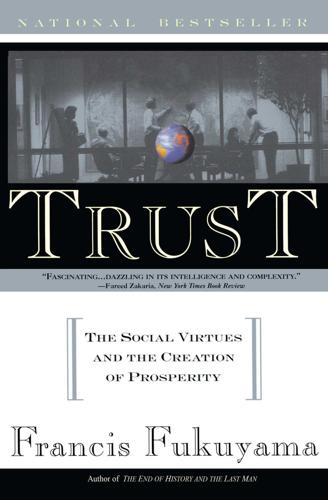
Trust: The Social Virtue and the Creation of Prosperity
by
Francis Fukuyama
Published 1 Jan 1995
Coleman, “Social Capital in the Creation of Human Capital,” American Journal of Sociology 94 (1988): S95-S120. See also Robert D. Putnam, “The Prosperous Community: Social Capital and Public Life,” American Prospect 13 (1993): 35-42; and Putnam, “Bowling Alone,” Journal of Democracy 6 (1995): 65-78. According to Putnam, the first use of the term social capital was by Jane Jacobs, in The Death and Life of Great American Cities (New York: Random House, 1961), p. 138. 9Gary S. Becker, Human Capital: A Theoretical and Empirical Analysis, 2d ed. (New York: National Bureau of Economic Research, 1975). CHAPTER 2. THE TWENTY PERCENT SOLUTION 1On this aspect of Adam Smith, see Jerry Z. Muller, Adam Smith in His Time and Ours (New York: Free Press, 1992). 2The neomercantilists share with earlier Marxist and Keynesian critics an emphasis on the importance of the state as an economic actor.
…
Huntington, Samuel P. and Weiner, Myron, eds., Understanding Political Development (Boston: Little, Brown and Co., 1987). Hutcheon, Robin, First Sea Lord: The Life and Work of Sir Y. K. Pao (Hong Kong: Chinese University Press, 1990). Imai, Ken’ichi, “The Corporate Network in Japan,” Japanese Economic Studies 16 (1986): 3-37. Jacobs, Jane, The Death and Life of Great American Cities (New York: Random House, 1961). Jacobs, Norman, The Origins of Modern Capitalism in Eastern Asia (Hong Kong: Hong Kong University Press, 1958). Jacoby, Sanford, “The Origins of Internal Labor Markets in Japan,” Industrial Relations 18 (1979): 184-196. Jamieson, Ian, Capitalism and Culture: A Comparative Analysis of British and American Manufacturing Organizations (London: Gower, 1980). -----, “Some Observations on Socio-Cultural Explanations of Economic Behaviour,” Sociological Review 26 (1978): 777-805.

Scale: The Universal Laws of Growth, Innovation, Sustainability, and the Pace of Life in Organisms, Cities, Economies, and Companies
by
Geoffrey West
Published 15 May 2017
Which I translate to mean: cities are emergent complex adaptive social network systems resulting from the continuous interactions among their inhabitants, enhanced and facilitated by the feedback mechanisms provided by urban life. 2. ST. JANE AND THE DRAGONS No one is more identified with viewing cities through the collective lives of their citizens than the famous urban writer-theorist Jane Jacobs. Her defining book, The Death and Life of Great American Cities, had an enormous influence across the globe on how we think about cities and how we approach “urban planning.”3 It’s required reading for anyone interested in cities whether a student, a professional, or just an intellectually curious citizen. I suspect that every mayor of every major city in the world has a copy of Jane’s book sitting somewhere on his or her bookshelf and has read at least parts of it.
…
Moore, “Predators and Prey: A New Ecology of Competition,” Harvard Business Review 71(3) (1993): 75. 2. The results of the program are summarized in the volume edited by D. Lane, et al., Complexity Perspectives in Innovation and Social Change (Berlin: Springer-Verlag, 2009). 3. Jane Jacobs, The Death and Life of Great American Cities (New York: Random House, 1961). 4. Interviewed by Bill Steigerwald in the June 2001 issue of Reason magazine. 5. B. Barber, If Mayors Ruled the World: Dysfunctional Nations, Rising Cities (New Haven, CT: Yale University Press, 2013). 6. B. Bryson, Down Under (New York: Doubleday, 2000). 7.
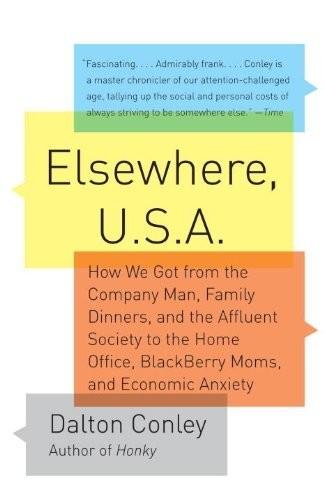
Elsewhere, U.S.A: How We Got From the Company Man, Family Dinners, and the Affluent Society to the Home Office, BlackBerry Moms,and Economic Anxiety
by
Dalton Conley
Published 27 Dec 2008
Ronna Larsen, “The Skyrocketing Number of Bank Branches,”e-merging Directions, Colliers Turley Martin Tucker Commerical Real Estate Services, at http://www.ctmt.com/pdfs/emergingDirections/BankBranches Skyrocket.pdf. 9. Juliet Schor, “The Social Death of Things,” working paper, 2007. 10. Barry Schwartz, The Paradox of Choice: Why More Is Less (New York: HarperCollins, 2004). SHOOT THE MOON 1. Jane Jacobs, The Death and Life of Great American Cities (New York: Vintage Books, 1961). 2. For this observation I must credit Natalie Jeremijenko’s research in“Share This Book” (PhD diss., University of Queensland, Aust). 3. “A Guide to UHF Television Production,” 2004-2007, at http://www.indiana.edu/~radiotv/wtiu/uhf.shtml. 4. Ian Grey, “Tee-Construction: A Brief History of the T-Shirt," at http://www.vintageskivvies.com/pages/archives/articles/readersubmissions/history ofthet-shirt.html. 5.5.
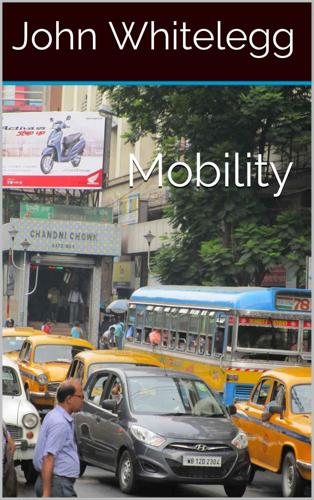
Mobility: A New Urban Design and Transport Planning Philosophy for a Sustainable Future
by
John Whitelegg
Published 1 Sep 2015
ITDP (2008) Sustainable Transport Award Nominees, Sustainable transport, Winter 2008, No 20, page 29, Institute for Transportation and Development, New York. ITDP (2013) Footpath design. A guide to creating footpaths that are safe, comfortable and easy to use, ITDP, New York. ITDP, Gehl Architects and Nelson Nyggard (2010) Our cities ourselves, 10 principles for transport in urban life, ITDP, New York. Jacobs, J (1961) The Death and Life of Great American Cities. The failure of town planning, Random House, USA. James, A (2014) The death of the habitats directive, World Transport Policy and Practice, volume 20, number 2/3, 97-107. Jerrett, M, McConnell, R, Chang, C, Wolch, J, Reynolds, K, Lurman, F, Gilliland, F and Berhane, K (2010) Automobile traffic around the home and attained body mass index: a longitudinal cohort study of children aged 10-18 years, Prev Med 50: S50-8.
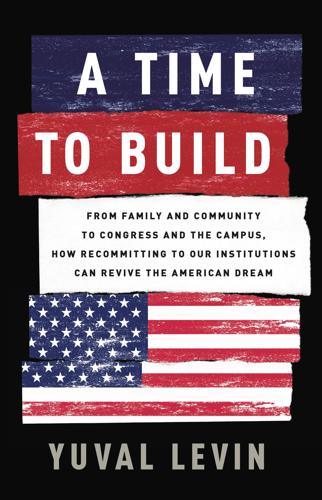
A Time to Build: From Family and Community to Congress and the Campus, How Recommitting to Our Institutions Can Revive the American Dream
by
Yuval Levin
Published 21 Jan 2020
In his (very) short story “A Radically Condensed History of Postindustrial Life,” David Foster Wallace perfectly captures this social dynamic of online life: “When they were introduced, he made a witticism, hoping to be liked. She laughed extremely hard, hoping to be liked. Then each drove home alone, staring straight ahead, with the very same twist to their faces.” David Foster Wallace, Brief Interviews with Hideous Men (New York: Little, Brown & Co., 1999), 1. 5. Jane Jacobs, The Death and Life of Great American Cities (New York: Random House, 1961). See particularly chapters 11 and 12. 6. Adam Mosseri, “Building a Better News Feed for You,” Facebook (press release), https://newsroom.fb.com/news/2016/06/building-a-better-news-feed-for-you/. 7. Stephen Marche, “The Crisis of Intimacy in the Age of Digital Connectivity,” Los Angeles Review of Books, October 15, 2018. 8.

To Show and to Tell: The Craft of Literary Nonfiction
by
Phillip Lopate
Published 12 Feb 2013
Winnicott: Winnicott on the Child, Playing and Reality Karen Horney: Feminine Psychology Leslie H. Farber: The Ways of the Will Adam Phillips: On Kissing, Tickling, and Being Bored Jules Henry: Pathways to Madness Architecture and Landscape Lewis Mumford: Sidewalk Critic, The Lewis Mumford Reader Ada Louise Huxtable: On Architecture Jane Jacobs: The Death and Life of Great American Cities J. B. Jackson: Landscape in Sight William H. Whyte: The Essential William H. Whyte Robert Venturi, Denise Scott Brown, and Steven Izenour: Learning from Las Vegas Dance Edwin Denby: Dancers, Buildings and People in the Streets Arlene Croce: Croce on Dance, The Fred and Ginger Book Elizabeth Kendall: Where She Danced Art Denis Diderot: Diderot on Art John Ruskin: The Stones of Venice Harold Rosenberg: Discovering the Present Clement Greenberg: Collected Essays and Criticism Meyer Schapiro: Impressionism, Modern Art Robert Smithson: The Collected Writings John Berger: Ways of Seeing, Selected Essays Robert Hughes: Nothing If Not Critical Sports Red Smith: The Red Smith Reader, To Absent Friends A.

Dreyer's English: An Utterly Correct Guide to Clarity and Style
by
Benjamin Dreyer
Published 15 Jan 2019
I’ll wager you’re adept at the use of apostrophes for simple possessives: the dog’s toy Meryl Streep’s umpteenth Oscar As to common—that is, not proper—nouns ending with an s, one doesn’t, at least not in recently published text,*21 encounter the likes of the boss’ office the princess’ tiara which I find positively spooky-looking, and for most of us, then, the boss’s office the princess’s tiara is the no-brainer way to go. Trouble knocks at the door, though, when terminal s’s occur at the ends of proper nouns. When the talk turns to, say, the writer of Great Expectations and Our Mutual Friend or the urban activist and author of The Death and Life of Great American Cities or the nemesis of said urban activist and author, how do we style their ownership? Well, I can certainly tell you how I style them: Charles Dickens’s novels Jane Jacobs’s advocacy Robert Moses’s megalomania Though you may come across much discussion elsewhere regarding the appending or not appending of post-apostrophe s’s based on pronunciation,*22 convention, or what day of the week it is, I think you’ll find that, as with the universal application of the series comma, you’ll save yourself a lot of thinking time by not thinking about these s’s and just applying them.

Survival of the Friendliest: Understanding Our Origins and Rediscovering Our Common Humanity
by
Brian Hare
and
Vanessa Woods
Published 13 Jul 2020
Published online February 23, 2016, https://www.washingtonpost.com/news/morning-mix/wp/2016/02/23/donald-trump-on-protester-id-like-to-punch-him-in-the-face/. 93. J. Diamond, “Trump: I Could Shoot Somebody and Not Lose Voters” CNN Politics (2016). Published online January 24, 2016, http://www.cnn.com/2016/01/23/politics/donald-trump-shoot-somebody-support/. 94. Jane Jacobs, The Death and Life of Great American Cities (New York: Vintage, 2016). 95. Richard Florida, The New Urban Crisis: How Our Cities Are Increasing Inequality, Deepening Segregation, and Failing the Middle Class, and What We Can Do About It (UK: Hachette, 2017). 96. R.T.T. Forman, “The Urban Region: Natural Systems in Our Place, Our Nourishment, Our Home Range, Our Future,” Landscape Ecology 23 (2008), 251–53. 97.
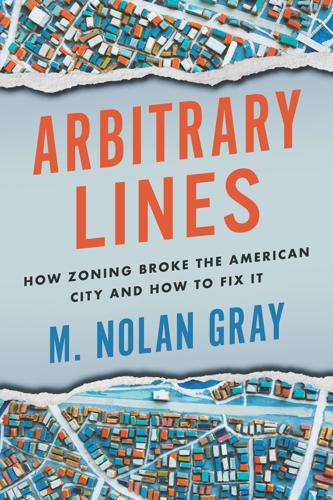
Arbitrary Lines: How Zoning Broke the American City and How to Fix It
by
M. Nolan Gray
Published 20 Jun 2022
The following section draws heavily from this earlier blog post, which also draws heavily on Siegan, Land Use without Zoning. 11. Siegan, Land Use without Zoning. 12. We might put on some DJ Screw, for added effect. 13. Bertaud, Order without Design; inspired in turn by Hayek, “Use of Knowledge in Society.” 14. Jane Jacobs, The Death and Life of Great American Cities (New York: Vintage, 1961). 15. Such an arrangement flips the script of zoning, forcing those with the more restrictive land-use preferences to partly shoulder the cost of their land-use preferences. 16. Houston Code of Ordinances, Chapter 30. 17. Houston Code of Ordinances, Chapter 10, Articles VIII and XI. 18.
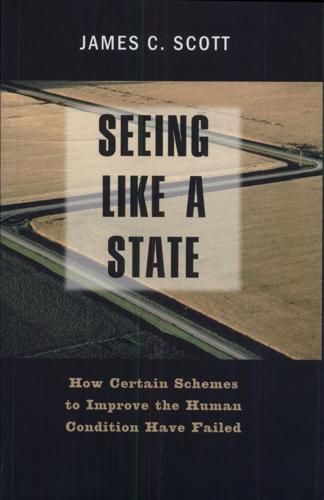
Seeing Like a State: How Certain Schemes to Improve the Human Condition Have Failed
by
James C. Scott
Published 8 Feb 1999
The small-scale street trader, the hawker or the rehris (barrows) have been banned from the city center, so that even where sources of interest and activity could be included, if only to reduce the concreted barrenness and authority of the chowk, these are not utilized."75 As in Brasilia, the effort was to transcend India as it existed and to present Chandigarh's citizens-largely administrators-with an image of their own future. As in Brasilia, the upshot was another unplanned city at the periphery and the margins, one that contradicted the austere order at the center. The Case Against High-Modernist Urbanism: Jane Jacobs Jane Jacobs's book The Death and Life of Great American Cities was written in 1961 against a high tide of modernist, functional urban planning. Hers was by no means the first criticism of high-modernist urbanism, but it was, I believe, the most carefully observed and intellectually grounded critique.76 As the most comprehensive challenge to contemporary doctrines of urban planning, it sparked a debate, the reverberations of which are still being felt.
…
An interesting parallel case from the same time period is Rachel Carson's Silent Spring (Boston: Houghton Mifflin, 1962). Carson began her influential attack on the profligate use of insecticides by asking a homely but powerful question: "Where have all the songbirds gone?" 80. Jane Jacobs, The Death and Life of Great American Cities (New York: Vintage Books, 1961), p. 15. 81. Ibid., p. 376. The early constructivist Le Corbusier would not have disavowed this view as a matter of principle, but as a matter of practice he was always greatly concerned with the sculptural properties of an urban plan or a single buildingsometimes with brilliant results, as in Notre-Dame-du-Haut, Ronch amp (1953). 82.
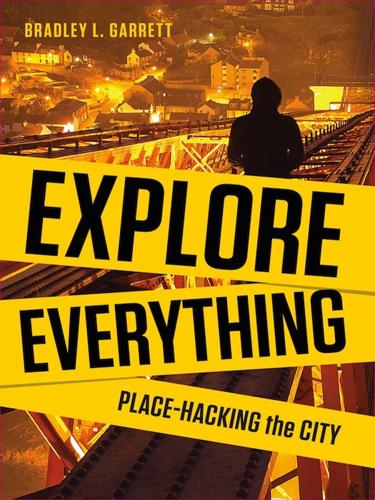
Explore Everything
by
Bradley Garrett
Published 7 Oct 2013
, New Statesman, 18 July 2012; Anon., ‘Graffiti Raids across London as Police Sanitise City Ready for Olympics’, atthelondonvandal.com/2012/07/graffiti-raids-across-london-as-police-sanitise-city-ready-for-olympics. 15 Rik Scarce, ‘A Law to Protect Scholars’, at skidmore.edu/newsitems/features/chronicle081205.htm (12 August 2005). 16 David Pescovitz, ‘Beating the Bounds Railwalk Project Shut Down’, at boingboing.net/2008/03/10/beating-the-bounds-r.html (10 March 2008). 17 ‘ASA Code of Ethics’, at asanet.org/images/asa/docs/pdf/EthicsCode.pdf; Jaschik, ‘Protecting His Sources’, Inside Higher Ed., 4 December 2009. 18 ‘(U//FOUO) National Counterterrorism Center: Urban Exploration Offers Insight into Critical Infrastructure Vulnerabilities’, at publicintelligence.net/nctc-urban-exploration (19 November 2012). 19 Jane Jacobs, The Death and Life of Great American Cities (New York: Random House, 1961). 20 Lisette Josephides, ‘Representing the Anthropologist’s Predicament’, in Allison James, Jenny Hockey and Andrew Dawson, eds, AfterWriting Culture: Epistemology and Praxis in Contemporary Anthropology (London: Routledge, 1997), p. 32, cited in Sarah Pink, Doing Visual Ethnography: Images, Media and Representation in Research (Manchester: Manchester University Press, 2001), p. 4. 21 Pinder, ‘Urban Interventions’, p 734.
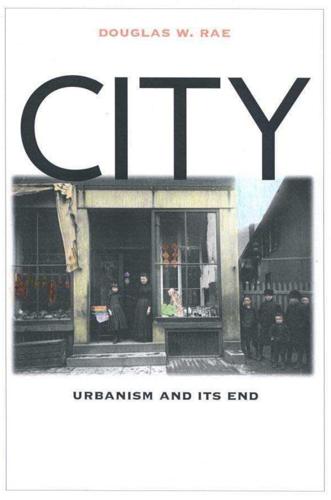
City: Urbanism and Its End
by
Douglas W. Rae
Published 15 Jan 2003
Fassett, UI: History of an Electric Company (New Haven: United Illuminating, 1990), 173. 45. Contact with strangers, handled with responses that allow civil cooperation well short of personal intimacy, is at the heart of Jane Jacobs’ justly celebrated work on urbanism. See Jacobs, The Death and Life of Great American Cities (New York: Random House, 1961). See also Lyn H. Lofland, A World of Strangers (New York: Basic Books, 1973). For a more developed theoretical treatment of contact with diversity, see Richard Sennett, The Uses of Disorder (New York: Norton, 1970). Gerald Frug has constructed an inspiring and complex theory of urban change that hinges to a considerable degree on overcoming the sorting processes of late twentieth-century urban regions.
…
Isaac, Jeffrey C. Power and Marxist Theory: A Realist View. Ithaca, N.Y.: Cornell University Press, 1987. Jackson, Kenneth T. Crabgrass Frontier: The Suburbanization of the United States. New York: Oxford University Press, 1987. Jacobs, Jane. The Economy of Cities. New York: Vintage, 1969. ———. The Death and Life of Great American Cities. New York: Random House, 1961. Jaffe, Harry S., and Tom Sherwood. Dream City: Race, Power, and the Decline of Washington, D.C. New York: Simon & Schuster, 1994. Janick, Herbert. “Yale Blue: Unionization at Yale University, 1931–1985.” Labor History 28, no. 3 (1987): 349–69. Jargowsky, Paul A.
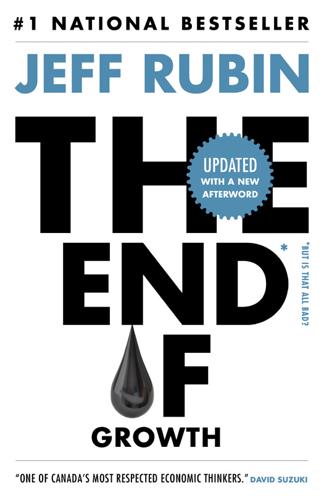
The End of Growth
by
Jeff Rubin
Published 2 Sep 2013
CHAPTER 6: THE DANISH RESPONSE this page: Information about Denmark’s environmental track record, including its level of carbon dioxide emissions since 1990, comes from figures available through the State of Green, a government-backed initiative to raise international awareness of the country’s green credentials (www.stateofgreen.com). this page: The argument for the relationship between urban population density and vibrant cities is well documented. Jane Jacobs, for one, argued convincingly against urban sprawl in her seminal work The Death and Life of Great American Cities, which has influenced thoughts on urban planning since its publication in 1961. CHAPTER 7: ZERO-SUM WORLD this page: The figures for Venezuela’s oil exports to the United States come from the EIA. US oil imports from Venezuela reached a high of 1.77 million barrels a day in 1997.

The Autonomous Revolution: Reclaiming the Future We’ve Sold to Machines
by
William Davidow
and
Michael Malone
Published 18 Feb 2020
But a different scenario now seems just as plausible, which is that more and more people will choose to live in more densely populated areas that are served by intelligent public transportation. This could create an apartment construction boom. The cities of the future may come to look and feel more like the old cities that Jane Jacobs celebrated and mourned in her book The Death and Life of Great American Cities half a century ago—lively, diverse federations of mixed-use neighborhoods, but powered by twenty-first-century infrastructure. The amount of construction required to create this autonomous country of the future is massive. The American Society of Civil Engineers (ASCE) has estimated that the country has a $3.6 trillion backlog and it is planning to spend only $2 trillion by 2020.44 Completing the projects identified by the society in a five-year period would require spending an additional $300 billion a year, or about 2 percent of GDP.
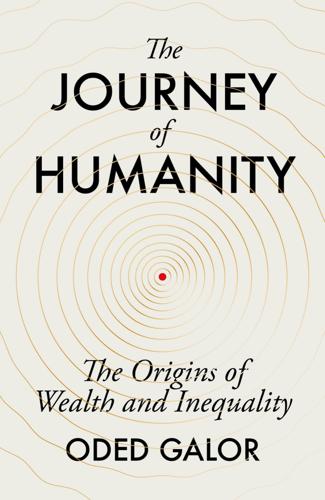
The Journey of Humanity: The Origins of Wealth and Inequality
by
Oded Galor
Published 22 Mar 2022
Hume, David, ‘Essays, Moral, Political, and Literary’, from Essays and Treatises on Several Subjects, Vol. 1, Bell & Bradfute, 1825, p. 112. Hunt, Terry L., and Carl P. Lipo, ‘Late Colonization of Easter Island’, Science 311, no. 5767 (2006): 1603–6. Jackson, Tim, Prosperity Without Growth: Foundations for the economy of tomorrow, Taylor & Francis, 2016. Jacobs, Jane, The Death and Life of Great American Cities, Vintage, 2016. Jedwab, Remi, Noel D. Johnson and Mark Koyama, ‘Pandemics, Places, and Populations: Evidence from the Black Death’, CEPR Discussion Papers DP13523 (2019). Jelinek, Arthur J., ‘The Tabun cave and Paleolithic man in the Levant’, Science 216, no. 4553 (1982): 1369–75.

The New Class Conflict
by
Joel Kotkin
Published 31 Aug 2014
Robert Caro, The Power Broker: Robert Moses and the Fall of New York (New York: Vintage, 1975), pp. 143–44; Becky Nicolaides, “How Hell Moved From the Cities to the Suburbs,” in Kevin M. Kruse and Thomas J. Sugure, The New Suburban History (Chicago: Univ. of Chicago Press, 2006), p. 87. 75. Jane Jacobs, The Death and Life of Great American Cities (New York: Random House, 1961), p. 357. 76. Nicolaides, “How Hell Moved From the Cities to the Suburbs,” pp. 91–97. 77. William Vogt, Road to Survival (New York: William Sloane, 1948), p. 284. 78. Michael Janofsky, “Gore Offers Plan to Control Suburban Sprawl,” New York Times, January 12, 1999. 79.
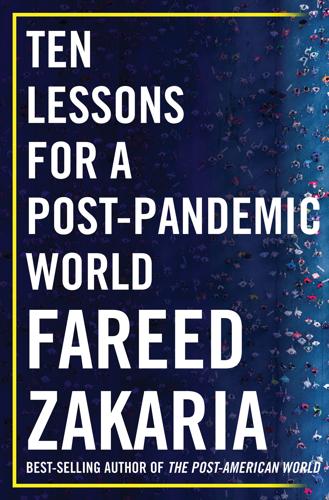
Ten Lessons for a Post-Pandemic World
by
Fareed Zakaria
Published 5 Oct 2020
See map in the digital version: https://www.nytimes.com/2016/04/17/opinion/sunday/a-new-map-for-america.html. 140 pushed ahead with the agreement: Ivo Daalder, “Why Cities Need Their Own Foreign Policies,” Politico, May 6, 2017. 141 stay in Columbus: Alina Dizik, “New Residents Are Spending Big in Columbus,” Wall Street Journal, November 7, 2019. 141 “Death and Life of Great Cities”: Drawn from the title of Jane Jacobs’s masterwork, The Death and Life of Great American Cities (New York: Random House, 1961). 141 “This City now doth”: William Wordsworth, “Composed Upon Westminster Bridge, September 3, 1802.” 142 “Here is New York”: Elwyn Brooks White, Here Is New York (1949), 21. 142 “Genuine, rich diversity”: Jane Jacobs, “Can Big Plans Solve the Problem of Renewal?
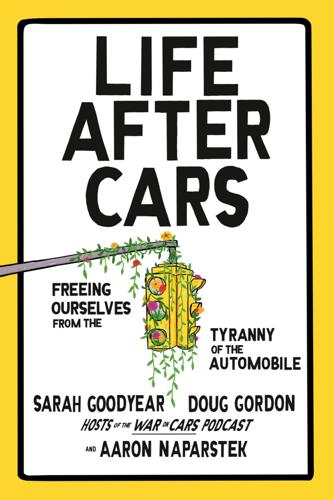
Life After Cars: Freeing Ourselves From the Tyranny of the Automobile
by
Sarah Goodyear
,
Doug Gordon
and
Aaron Naparstek
Published 21 Oct 2025
In the special, Groucho says that “our love affair with the automobile” started long ago, and that “it was a real love affair, one that changed our whole way of life.” The phrase became part of the popular lexicon almost overnight. Produced the same year that Jane Jacobs published her seminal book The Death and Life of Great American Cities, and airing just as the highway revolts were gaining steam, Groucho’s hyping of the “love affair” was a brilliant defensive ploy on the part of the automobile industry. For generations, that hype has successfully obscured the darker reality of a world built for cars. People over Parking On August 10, 2018, Madison Lyden, a twenty-three-year-old tourist from Australia, was riding a bicycle on Central Park West when an Uber driver suddenly pulled ahead of her into the painted bike lane.
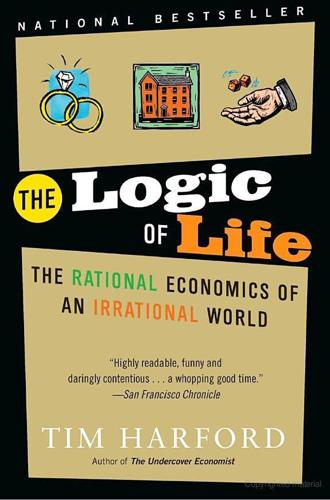
The Logic of Life: The Rational Economics of an Irrational World
by
Tim Harford
Published 1 Jan 2008
Department of Justice press release, February 21, 2006, www.usdoj.gov/usao/dc/Press_Releases/2006_Archives/Feb_2006/06060.html, summarizes the evidence, which Reginald Jones accepted, entering an “Alford” plea, which asserted his innocence but accepted that enough evidence existed to convict him. Newspaper accounts include “Horrific Attack, Heroic Rescue,” The Washington Post, July 7, 2005, and “Blood, Sweat, and Fear,” FT Magazine, August 27, 2005. I was one of the witnesses to the attack. Jane Jacobs: Jane Jacobs, The Death and Life of Great American Cities 1961; rept. New York: Vintage 1992). Two economists: Edward Glaeser and Bruce Sacerdote, “The Social Consequences of Housing,” NBER Working Paper 8034, December 2000, papers.nber.org/papers/W8034. The British ghettos are up: U.K. white population from the Office for National Statistics, www.statistics.gov.uk/cci/nugget.asp?

The New Urban Crisis: How Our Cities Are Increasing Inequality, Deepening Segregation, and Failing the Middle Class?and What We Can Do About It
by
Richard Florida
Published 9 May 2016
Urbanism for All Acknowledgments About the Author More Advance Praise for The New Urban Crisis Appendix Notes Index For Mila Any city, however small, is in fact divided into two, one the city of the poor, the other of the rich. —PLATO, THE REPUBLIC Cities have the capability of providing something for everybody, only because, and only when, they are created by everybody. —JANE JACOBS, THE DEATH AND LIFE OF GREAT AMERICAN CITIES PREFACE I was born in Newark, New Jersey, in 1957, back when it was a thriving city, bustling with iconic department stores, morning and evening newspapers, libraries and museums, a busy downtown, and a large middle class. My parents both came of age in the city’s Italian district, and they still lived there when I was born, in an apartment near the city’s verdant Branch Brook Park.
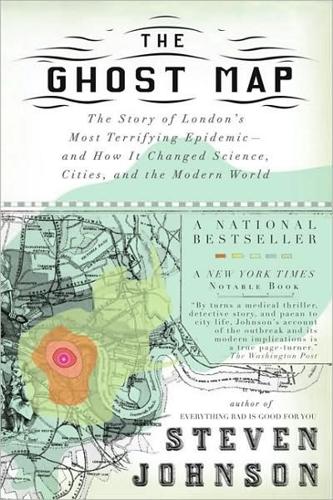
The Ghost Map: A Street, an Epidemic and the Hidden Power of Urban Networks.
by
Steven Johnson
Published 18 Oct 2006
Cambridge, MA: Harvard University Press, 1995. Iberall, Arthur S. “A Physics for Studies of Civilization.” Self-Organizing Systems: The Emergence of Order, ed. F. Eugene Yates. New York and London: Plenum Press, 1987. Jacobs, Jane. The Economy of Cities. New York: Random House, 1969. ——. The Death and Life of Great American Cities. New York: Vintage, 1992. ——. The Nature of Economies. New York: Modern Library, 2000. Kelly, John. The Great Mortality: An Intimate History of the Black Death, the Most Devastating Plague of All Time. New York: HarperCollins, 2005. Koch, Tom. Cartographies of Disease: Maps, Mapping, and Medicine.

Peers Inc: How People and Platforms Are Inventing the Collaborative Economy and Reinventing Capitalism
by
Robin Chase
Published 14 May 2015
This order is all composed of movement and change, and although it is life, not art, we may fancifully call it the art form of the city and liken it to the dance—not to a simple-minded precision dance with everyone kicking up at the same time, twirling in unison and bowing off en masse, but to an intricate ballet in which the individual dancers and ensembles all have distinctive parts which miraculously reinforce each other and compose an orderly whole. The ballet of the good city sidewalk never repeats itself from place to place, and in any one place it is always replete with new improvisations. —JANE JACOBS, THE DEATH AND LIFE OF GREAT AMERICAN CITIES I LOVE THIS PASSAGE by urban planner Jane Jacobs. Her description of a city street that works—a place where infrastructure encourages the intricate ballet of life to flourish—is an analogy for what is required when building a Peers Inc platform. It took months of eighteen-hour days to ready Zipcar for launch.

Norman Foster: A Life in Architecture
by
Deyan Sudjic
Published 1 Sep 2010
Even Yale’s gymnasium is built in exuberant gothic style, and it comes equipped with a tower not much less imposing than that of Durham Cathedral. It is, in short, a university that might have been imagined by Ralph Lauren. But beyond its gothic zone, New Haven in Foster’s day was suffering from the early symptoms of the urban decay that Jane Jacobs identified in her book, The Death and Life of Great American Cities: a rotting centre and spreading affluent suburbs. Away from the security of the city lights and the campus police it would become a troubled place to live after the race riot of 1967. There were whole streets in New Haven in which the only functioning buildings were adult cinemas.

The Weightless World: Strategies for Managing the Digital Economy
by
Diane Coyle
Published 29 Oct 1998
Figures from LETS Make Money Work for People, by Gill Seyfang and Colin Williams, Kindred Spirit, August 1997. In The Independent, London, 19 July 1995. Quoted in The New York Times, 29 September 1996. In Meadows, Work Out — or Work In? Interview in Independent on Sunday, London, 5 May 1996. The Death and Life of Great American Cities, Jane Jacobs, 1961. In Making Welfare Work, 1995. In Economic Trends, July 1996. Chapter Five. Fear of Flexibility ‘Bill Clinton has created ten million jobs — and two of them are mine.’ It was one of the classic jokes of President Clinton’s 1996 re-election campaign. The US economy has had an unparalleled record of high job creation and low unemployment since the trough of its recession in 1992.
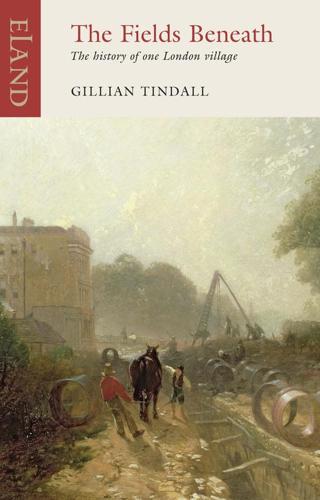
The Fields Beneath: The History of One London Village
by
Gillian Tindall
Published 1 Oct 2002
Hole, James, The Homes of the Working Classes, with Suggestions for their Improvement, 1866. Hollinshead, John, Ragged London, 1861. Hoskins, W. G., English Landscapes, 1977. Howitt, William, The Northern Heights of London, 1869. Hughson, David, London, 1809. Ilive, Survey of London, 1742. Jacobs, Jane, The Death and Life of Great American Cities, 2002. Jenkins, Simon, Landlords to London; the story of a capital and its growth, 1975. Jeffcot, Eric, ‘Old Roads’ (article in St Pancras Journal Vol. 8, No. 1). Kellet, John R., Railways and Victorian Cities, 1979. Laslett, Peter, The World We Have Lost, 1968. Lee, Charles E., St Pancras Church and Parish, 1955 (published by the Parochial Church Council).
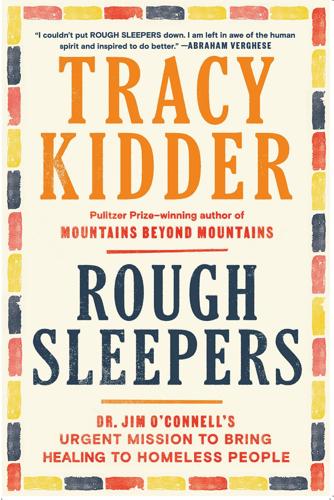
Rough Sleepers: Dr. Jim O'Connell's Urgent Mission to Bring Healing to Homeless People
by
Tracy Kidder
Published 17 Jan 2023
“You were a troublemaker from the start,” his mother liked to say. He grew up in Boston’s North End, known to outsiders for its Italian restaurants and American heirlooms—the Old North Church, Paul Revere’s house. “The healthiest place in the city,” Jane Jacobs called the neighborhood, in The Death and Life of Great American Cities. The streets, she wrote, had an “atmosphere of buoyancy, friendliness and good health.” The North End of Tony’s childhood was a harsher place. Outsiders used to say that a single woman could walk its streets in perfect safety, but this was true, Tony said, only if the woman was white.
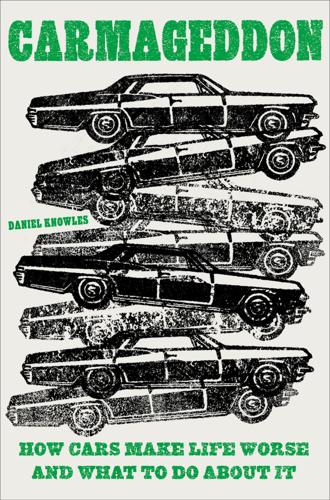
Carmageddon: How Cars Make Life Worse and What to Do About It
by
Daniel Knowles
Published 27 Mar 2023
And then he took her to one of the new planned neighborhoods that was meant to replace the slums and it was desolate. “He showed me the ‘after’ street, all fixed up, and there was just one person on it, a bored little boy kicking a tire in the gutter,” she told a panel in San Francisco much later, in 2004. That motivated her despair. In 1961, Jacobs published a book, The Death and Life of Great American Cities, which remains probably the best book about urban planning ever written. In the introduction she talks about the visionaries who believed, if they just had enough money, that could “wipe out all our slums in ten years, reverse decay in the great, dull gray belts that were yesterday’s and day-before-yesterday’s suburbs, anchor the wandering middle class and its wandering tax money, and perhaps even solve the traffic problem.”

The Warhol Economy
by
Elizabeth Currid-Halkett
Published 15 Jan 2020
It’s useful to start with a little history on the evolution of Jacobs’ ideas. Jacobs despised contemporary urban planning, with its knee-jerk tendency to impose physical order on the apparent chaos of the city. Such planning, she argued, dampened creativity, spontaneity, and organic, authentic urban life. In her 1961 book, The Death and Life of Great American Cities, Jacobs turned the entire fields of urban planning and urban sociology on their heads. City planning was then focused on creating high-rise housing projects and big parks, both of which stunted the natural composition of urban life. Jacobs argued that these types of projects did not foster the environments that allowed for consistent and spontaneous human interaction, in other words, the social places where people actually interacted.
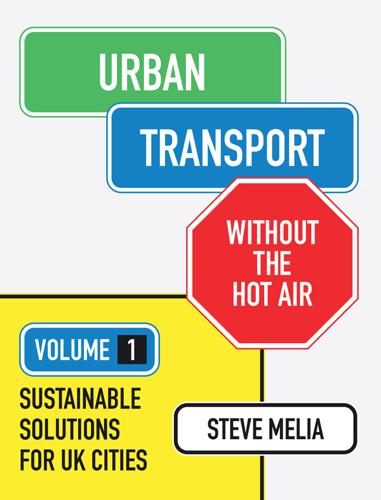
Urban Transport Without the Hot Air, Volume 1
by
Steve Melia
Other sources include my own notes made in 2007 and: Frankignoulle, Pierre and Bodson, Edith (1996) ‘Le campus universitaire comme espace public: des représentations aux pratiques’. Études de communication. On: edc.revues.org/2453 308 Reproduced courtesy of l’Université Catholique de Louvain 309 UCL (2013) ‘L’UCL à Louvain-la-Neuve: Modernité et tradition d’une ville piétonne’. On:www.uclouvain.be 310 See : Jacobs, Jane (1961) The Death and Life of Great American Cities. New York: Random House. 311 See: Mcallister, Gilbert (1946) ‘Planning New Towns’. The Spectator. 5 April. p. 8 On: archive.spectator.co.uk 312 Colleyn Mathieu (2013) ‘Bruxelles veut le RER “maintenant, tout de suite”’ La Libre Belgique. 3 October. 313 Hermia, J-P. and Eggerickx, T (2007) ‘Louvain-la-Neuve : une démographie atypique’.

Everything Is Obvious: *Once You Know the Answer
by
Duncan J. Watts
Published 28 Mar 2011
People have been fascinated with what sociologists call the small-world problem for nearly a century, since the Hungarian poet Frigyes Karinthy published a short story called “Chains” in which his protagonist boasts that he can connect himself to any other person in the world, whether a Nobel Prize winner or a worker in a Ford Motor factory, through a chain of no more than five acquaintances. Four decades later, in her polemic on urban planning The Death and Life of Great American Cities, the journalist Jane Jacobs described a similar game, called messages, that she used to play with her sister when they first moved to New York: The idea was to pick two wildly dissimilar individuals—say a headhunter in the Solomon Islands and a cobbler in Rock Island, Illinois—and assume that one had to get a message to the other by word of mouth; then we would each silently figure out a plausible, or at least possible, chain of persons through whom the message could go.
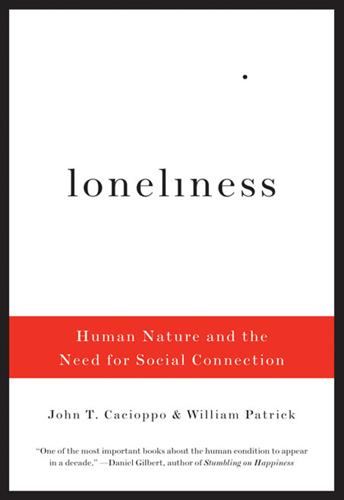
Loneliness: Human Nature and the Need for Social Connection
by
John T. Cacioppo
Published 9 Aug 2009
The apartheid government of South Africa went so far as to destroy a wide swath of Cape Town—a mixed-race area called District Six—precisely because of its rich sense of community. The harmony that had flourished among the district’s crowded mix of blacks and whites and Asian immigrants gave the lie to the ruling party’s agenda of racial separatism. In the 1960s urbanists like Jane Jacobs launched a counteroffensive. Jacobs’s book The Death and Life of Great American Cities is her paean to her own “village”—Greenwich Village in New York City. In its pages she extols the vitality of life on a smaller, more compact scale, where people live and work on the same block. She writes about the greater trust and sense of connection, as well as the enriching, serendipitous encounters that result.
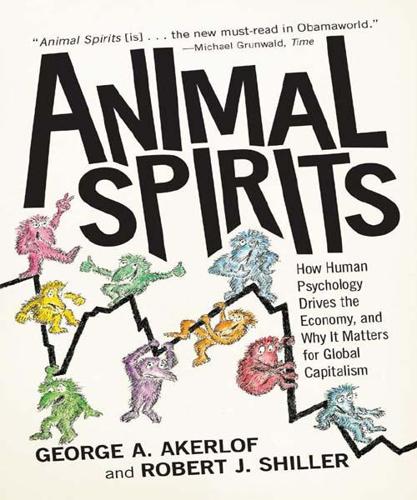
Animal Spirits: How Human Psychology Drives the Economy, and Why It Matters for Global Capitalism
by
George A. Akerlof
and
Robert J. Shiller
Published 1 Jan 2009
National Bureau of Economic Research Working Paper 9701, May. Ikegami, Eiko, 2005. Bonds of Civility: Aesthetic Networks and the Political Origins of Japanese Culture. Cambridge, Mass.: Cambridge University Press. Ip, Greg. 1994. “Routine No Longer Governs Crow’s Life.” Financial Post (Toronto), April 28, p. 15. Jacobs, Jane. 1961. The Death and Life of Great American Cities. New York: Random House. James, Henry. 1983 [1904]. The Golden Bowl. Oxford: Oxford University Press. Juhn, Chinhui, Kevin M. Murphy, and Brooks Pierce. 1993. “Wage Inequality and the Rise in Returns to Skill.” Journal of Political Economy 101(3):410–42. Jung, Jeeman, and Robert J.

Data and the City
by
Rob Kitchin,Tracey P. Lauriault,Gavin McArdle
Published 2 Aug 2017
Harrison, C. and Donnelly, I.A. (2011) ‘A theory of smart cities’, in Proceedings of the 55th Annual Meeting of the ISSS – 2011, Hull, UK, available from: http://journals.isss. org/index.php/proceedings55th/article/view/1703 [accessed 24 November 2016]. Hemment, D. and Townsend, A. (2013) Smart Citizens. Manchester: FutureEverything Publications. Hollands, R.G. (2008) ‘Will the real smart city please stand up? Intelligent, progressive or entrepreneurial?’, City 12(3): 303–320. Jacobs, J. (2000) The Death and Life of Great American Cities. London: Pimlico. Kitchin, R. (2014a) ‘Big data, new epistemologies and paradigm shifts’, Big Data & Society 1(1): 1–12. Kitchin, R. (2014b) The Data Revolution: Big Data, Open Data, Data Infrastructures and Their Consequences. London: SAGE. Kitchin, R. (2014c) ‘The real-time city?

Radical Markets: Uprooting Capitalism and Democracy for a Just Society
by
Eric Posner
and
E. Weyl
Published 14 May 2018
Sandel, What Money Can’t Buy: The Moral Limits of Markets (Farrar, Straus and Giroux, 2012), and Samuel Bowles, The Moral Economy: Why Good Incentives Are No Substitute for Good Citizens (Yale University Press, 2016). 14. A. O. Hirschman, Rival Interpretations of Market Society: Civilizing, Destructive, or Feeble?, 20 Journal of Economic Literature 1463 (1982). 15. Durkheim, Division of Labour in Society. 16. Jane Jacobs, The Death and Life of Great American Cities (Random House, 1961). 17. Marion Fourcade & Kieran Healy, Moral Views of Market Society, 33 Annual Review of Sociology 285 (2007), highlight that the most powerful visions of markets have been inherently moralizing and not just economic. We hope some readers will find this moral vision an important component of the project of Radical Markets. 18.
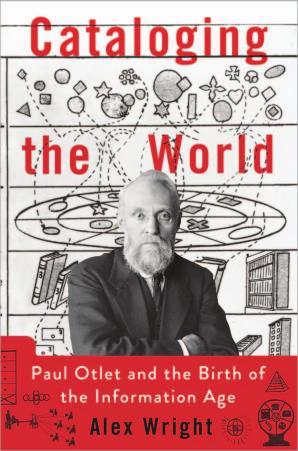
Cataloging the World: Paul Otlet and the Birth of the Information Age
by
Alex Wright
Published 6 Jun 2014
“Industrial History | Belgium.” European Route of Industrial Heritage. Accessed July 27, 2013. http://www.erih.net/topmenu/about-erih.html. “Internet 2012 in Numbers.” Pingdom, January 16, 2013. http://royal.pingdom .com/2013/01/16/internet-2012-in-numbers/. 328 BIBLIOGRAPHY Jacobs, Jane. The Death and Life of Great American Cities. New York: Vintage, 1992. James, Henry. Beloved Boy: Letters to Hendrik C. Andersen, 1899–1915. Charlottesville: University of Virginia Press, 2004. ———. Roderick Hudson. Boston: Houghton Mifflin, 1917. “James W. Bryce Biography.” IBM. Accessed July 18, 2013. http://www-03.ibm.com/ ibm/history/exhibits/markI/2413JB01.html.

Inheritance
by
Leo Hollis
‘Speculative investors head for the exit in Nine Elms Development’, Financial Times, 10 July 2015 11 ‘Living cities’, Grosvenor, 2012, found here: https://www.grosvenor.com/Grosvenor/files/8c/8c11529e-ae66-414d-9e8e-ace94f70453b.pdf 12 Grosvenor Square website, https://www.grosvenorsquare.org/ 13 Jacobs, J. The Death and Life of Great American Cities, Modern Library, 1993, p. 50 14 Davis, J. P. ‘The resilience of a London great estate: urban development, adaptive capacity and the politics of stewardship’, Journal of Urbanism, Vol. 11, no. 1 (2018), p. 109 15 Ibid., p. 111 16 UK House Price Index, Land Registry website, https://landregistry.data.gov.uk/ 17 Piketty, T.
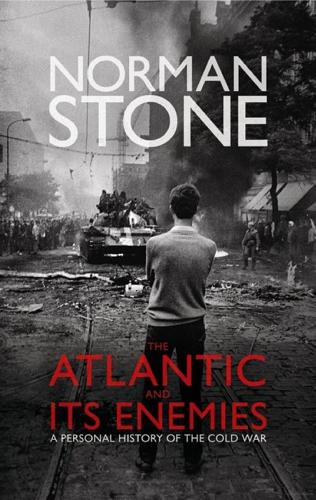
The Atlantic and Its Enemies: A History of the Cold War
by
Norman Stone
Published 15 Feb 2010
Two decades later governments had a great deal more money and were still producing squalor: what conclusion was to be drawn, that governments should have even more, or that they just could not help producing squalor? Vance Packard’s Status Seekers (1960) described the American business rat race. Jane Jacobs, looking at the wreckage caused by the San Francisco freeway system, wrote The Death and Life of Great American Cities (1961) and she foresaw that housing estates for the poor would turn into sinks of hopelessness worse than the slums that they were to replace; she also foresaw that city centres would become empty, inhabited only by tramps. Betty Friedan’s The Feminine Mystique (1963) spoke for the bored housewife.
…
Harriman, Averell Harrington, Michael, The Other America Harris, Robert, Archangel Hartington, Kathleen Cavendish, Marchioness of (née Kennedy) Harvard University Business School Tercentenary Hastings, Sir Max Havana Havel, Václav Havenstein, Rudolf Hayek, Friedrich von Healey, Denis, Baron Heath, Sir Edward: appearance and character and Britain’s membership of EEC and Britain’s relations with US dismissed as Conservative leader government of incomes policy loses 1974 election and Margaret Thatcher’s government and trade unions Hegel, Georg Wilhelm Friedrich Hekmatyar, Gulbuddin Helms, Richard Helsinki conference (CSCE; 1975) Hemingway, Ernest Hentze, Paul Herat heroin Hersh, Seymour Herter, Christian Heseltine, Michael, Baron Hezb (Afghan resistance group) Hills, Denis Hindus Hippocrates Hiroshima Hiss, Alger History Today (magazine) Hitler, Adolf: appeasement of beer-hall Putsch (1923) Berlin Bunker eugenics favourite film invasion of Czechoslovakia invasion of USSR reduction of unemployment rise to power suicide and cremation Ho Chi Minh Ho Chi Minh Trail Hodder and Stoughton (publishers) Hodža, Enver Hoechst (corporation) Hoesch (corporation) Hoffman, Paul Hoggart, Richard Holland: Calvinist Church colonies economic success and EEC exports floating of currency oil embargo against post-imperial decline trade unions see also Benelux Hollywood Holy Roman Empire homosexuality gay rights Honecker, Erich Hong Kong hooliganism Hoover, Herbert Hopper, Kenneth Hopper, William Horn, Gyula Hoskyns, Sir John Hotter, Hans Howe, Geoffrey, Baron Howe of Aberavon Hue, Vietnam Hugo, Victor, Les Misérables human rights Humphrey, Hubert Hunan province Hungarian diaspora Hungary: AVO (security police) Catholic Church Christian Women’s Camp Communist Party communist takeover ending of communist state inflation intelligentsia Jews in under Kádár Khrushchev’s relaxation attempts labour camps nationalism opening of border with Austria (1989) Peasant Party peasantry Protestant churches relations with Austria Second World War Social Democrats territorial losses trade unions United Workers’ Party uprising of 1848 uprising of 1956 Writers’ Union Huntington, Samuel Husák, Gustáv Hussein, King of Jordan Huxley, Sir Julian Hysko, Miroslav Ibárruri, Dolores IBM (corporation) ICBMs (intercontinental ballistic missiles) Ickes, Harold IEA (British Institute of Economic Affairs) Iliescu, Ion Illinois I’m All Right, Jack (film) IMF (International Monetary Fund): assumes true world role Belgrade meeting (1979) and Bretton Woods system British bail-out (1976) establishment of ineffectiveness loans to Romania and military coups in Chile and Turkey role in defending threatened currencies and ‘Washington consensus’ İnan, Kâmran Inchon İncirlik air base India: border conflicts with China British rule famine independence intelligentsia nationalism partition war in Kashmir Indonesia: Dutch rule independence movement oil production Industrial Reorganization Corporation (British) Industrial Revolution inflation Britain Chile France Germany Hungary hyper-inflation Italy Japan and monetarism Phillips Curve Poland ‘stagflation’ Turkey and universities USA USSR information technology: development of and financial markets manufacturers and public sector theory of unions’ obstruction of in USSR Ingham, Sir Bernard Inönü, Ismet Institute of Economic Affairs (British; IEA) intelligentsia: Britain China Czechoslovakia France Germany Greece Hungary India Poland Turkey USA USSR Russiap> Western intelligentsia and communism International Bank for Reconstruction and Development see World Bank International Monetary Fund see IMF internment camps, Soviet Ionesco, Eugène İpekçi, Abdı Iran: and Afghanistan allied with West Azeri Turks coup of 1953 hostage crisis (1979-81) Islamic revolution (1978-9) Kurdish population under Mossadegh oil production relations with USSR and Saudi Arabia Savak (secret police) Second World War occupation under the Shah and terrorism Iran, Shah of (Mohammad Reza Pahlavi) fall of Iran-Contra affair (‘Irangate’) Iraq: Christians in coup of 1958 Kurdish population Nasser’s interference in under Saddam Hussein Soviet aid Iraq-Syria pipeline Iraq war (2003- ) Ireland Catholic Church emigration Irish Question nationalism terrorism Islam: in Afghanistan in Iran in Iraq of Kurds in Pakistan in Soviet Central Asia in Turkey and Turkish ‘guest workers’ in Germany see also Moslems Israel: American support for Arab plans to eliminate Camp David accords (1978) establishment of and Iran-Contra affair relations with USSR Six Day War (1967) and Suez crisis Yom Kippur War (1973) Istanbul Aya Sofya Bosphorus Bridge economic growth and redevelopment Galata Maslak riots (1955) stock exchange Taksim Square massacre (1977) Italy: Allied reconquest automobile industry backwardness black economy Christian Democrats Communists corruption education system and EEC election of 1948 film industry and Germany Guelfs and Ghibellines imports industrial unrest and strikes inflation Marshall Plan aid peasantry political instability post-war economic recovery protectionism public finances Red Brigades student demonstrations terrorism trade unions universities war damage Itzenplitz, Baron Heinrich von İzmir Jachymov mines, Bohemia Jackson, Andrew Jackson-Vanik Amendment (1973-4) Jacobs, Jane, The Death and Life of Great American Cities Jaguar (automobile manufacturer) Jakab, Sándor Jakeš, Miloš Jalalabad Jamaica Jamiat (Afghan resistance group) Japan: automobile industry banking crisis (2008-9) Communists in economic boom economic recession empire invasion and occupation of China land reforms and North Korea post-war Allied occupation post-war economic recovery prisoners of war Second World War shipbuilding steel production use of fax machines and Vietnam Westernization Jaruzelski, Wojciech Jay, Peter Jefferson, Thomas Jenkins, Roy, Baron Jenkins of Hillhead Jenkins, Sir Simon Jerusalem King David Hotel bombing (1946) Jesuits Jesus College, Cambridge Jews: emigration to Palestine German compensation to in Greece in Hungary in Poland in Romania in Slovakia in Turkey in USA n USSR in West Germany see also anti-semitism Jiangxi soviet Jobs, Steve John Brown Engineering John Paul II, Pope Johnson, Chalmers Johnson, Claudia ‘Lady Bird’ Johnson, Harry Johnson, Lyndon B.: background and character and Brezhnev and China economic policy election as President Great Society on Kennedy reputation as Roosevelt’s manager use of Supreme Court Vice-President and Vietnam withdraws from re-election campaign Joliot-Curie, Irène Jones, Aubrey Jones, Jack Jones, Therese Jordan Joseph, Keith, Baron Juglar, Clement June Days uprising (1848) ‘junk bonds’ Kabul Kádár, János Kafka, Franz, Amerika Kahn, Philippe Kaldor, Nicholas, Baron Kaluga Kamchatka Kandahar Kang Sheng Kania, Stanisław Kapitsa, Piotr Kaplan, Karel Kapor, Mitch Karabük steel plant Karaganda Karajan, Herbert von Karasar, Hasan Ali Karmal, Babrak Karman, Tibor Karpacky, Kornel Kashmir Katowice Katyń massacre (1940) Kayseri Kazakhstan Kedourie, Elie Keep, John Kemal, Mustafa see Atatürk, Mustafa Kemal Kemp, Jack Kempner, Nan Kennan, George Kennedy, Edward Kennedy, Jacqueline Kennedy, John F.: ‘Alliance for Progress’ (plan for Latin America) appearance, background and character assassination and Bay of Pigs invasion and Berlin crisis of 1961 and Cuban crisis of 1962 economic policy election as President funeral Inaugural address and Macmillan New Frontier reputation and Roosevelt Vienna conference (1961) and Vietnam White House style Kennedy, John F., Jr Kennedy, Joseph Kennedy, Robert Kent State University shootings (1970) Kerr, Clark Keyder, Çağlar Keynes, John Maynard, 1st Baron: Galbraith and on government spending homosexuality hopes for German bombing on paper money and Roosevelt Keynesianism KGB: and coup of August 1991 and Cuban crisis of 1962 and dissidents and Gorbachev network of informers relationship with Party and revolutions of 1989 and war in Afghanistan and Western anti-missile demonstrations see also Cheka KHAD (Afghan secret police) Khanin, G.

The death and life of the great American school system: how testing and choice are undermining education
by
Diane Ravitch
Published 2 Mar 2010
Many thanks to Meredith Smith and Antoinette Smith of Basic Books for their careful review of the manuscript, and to Lynn Goldberg and Angela Hayes of Goldberg-McDuffie, who gave me their wholehearted support. And I am grateful to Tim Sullivan, my editor at Basic Books, who quickly understood the book and suggested the title of my dreams. We both agreed that the title is a fitting homage to Jane Jacobs, whose book The Death and Life of Great American Cities helped to create a renaissance in the nation’s cities. Since I live the life that she wrote about, in a wonderful urban neighborhood saved by historic preservation, I love the idea of associating my book with hers, most especially with the hope that American education in general and urban education in particular might also experience a renaissance.
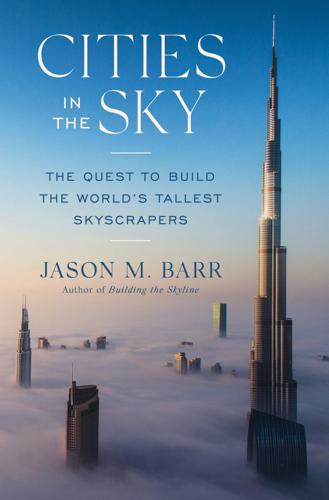
Cities in the Sky: The Quest to Build the World's Tallest Skyscrapers
by
Jason M. Barr
Published 13 May 2024
There reformers wanted to clear the slums and provide open space and low-density buildings instead, while politicians wanted high-density housing only for the very poor (so as not to upset middle-class voters who believed cheap housing for other middle-class citizens was unfair). In the end, the comprise created new slums, unhappy residents, and a fear of building heights. In 1961, Jane Jacobs in her classic book, The Death and Life of Great American Cities, showed how Americans got the whole thing in reverse. Instead of fearing naturally occurring density and trying to surgically remove it, she argued, density should be embraced. Cities work not despite density but because of it. And city planners should not try to engineer perfection because the quest for utopia transformed American cities into dystopia.
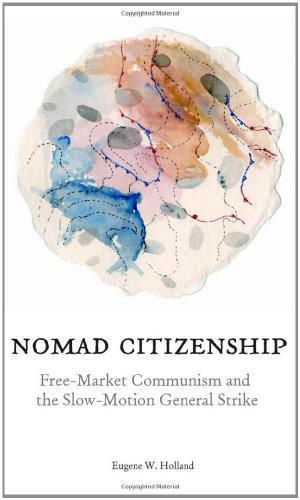
Nomad Citizenship: Free-Market Communism and the Slow-Motion General Strike
by
Eugene W. Holland
Published 1 Jan 2009
The very density, anonymity, and complexity of city life counterbalances the centripetal force of commu nity self-organization and self-identification, compelling or encouraging urban dwellers to frequent “public spaces [where] people encounter other people, meanings, expressions, issues, which they may not understand or with which they do not identify.”40 City living not only fosters the de velopment of multiple, different affinity groups but also brings members of those groups into regular contact with others: the complexity of the city thus fosters not just self-contained difference but related difference. In The Death and Life of Great American Cities, Jacobs provides a pio neering account of the city as matrix of immanently related difference. H er work opposed not only the practices and programs of urban renewal rampant in post-World War II America but also the modernist view of city planning promulgated by Le Corbusier and others starting early in the century.41 The modernist city planner sought to simplify and ratio nalize the city: his ideal was a gridlike plan whereby various urban func tions—commercial, recreational, industrial, residential, and so on—would be carefully segregated from one other and the “formal layout” of city structure purified accordingly.42 To Jacobs, such single-use functionalism and geometrical moralism were anathema: she favored, instead, the rich complexity of multiuse urbanism as it emerged over time, without the need for top-down planning.43And where Follett emphasized the self-sufficiency of the neighborhood, Jacobs emphasized its necessary imbrication in the larger structures and dynamics of the surrounding city.

City on the Verge
by
Mark Pendergrast
Published 5 May 2017
How the Creative Economy Is Making Where to Live the Most Important Decision of Your Life (2008); Leigh Gallagher, The End of the Suburbs: Where the American Dream Is Moving (2013); Edward Glaeser, Triumph of the City: How Our Greatest Invention Makes Us Richer, Smarter, Greener, Healthier, and Happier (2011); Ryan Gravel, Where We Want to Live: Reclaiming Infrastructure for a New Generation of Cities (2016); Richard J. Jackson, Designing Healthy Communities (2012); Jane Jacobs, The Death and Life of Great American Cities (1961); Alyssa Katz, Our Lot: How Real Estate Came to Own Us (2009); Joel Kotkin, The Next Hundred Million: America in 2050 (2010); John Kromer, Fixing Broken Cities: The Implementation of Urban Development Strategies (2010); Christopher B. Leinberger, The Option of Urbanism: Investing in a New American Dream (2008); David Owen, Green Metropolis: Why Living Smaller, Living Closer, and Driving Less Are the Keys to Sustainability (2009); Witold Rybczynski, Makeshift Metropolis: Ideas About Cities (2010).

Them and Us: How Immigrants and Locals Can Thrive Together
by
Philippe Legrain
Published 14 Oct 2020
, Migration Policy Debates 19, OECD, May 2019. https://www.oecd.org/migration/mig/migration-policy-debates-19.pdf 77 The top ten countries in terms of their attractiveness to highly educated workers, before factoring in visa rules, are the US, Australia, New Zealand, Canada, Sweden, Ireland, Switzerland, Norway, the Netherlands and the UK. 78 The top ten most attractive OECD countries to highly educated workers are Australia, Sweden, Switzerland, New Zealand, Canada, Ireland, the US, the Netherlands, Slovenia and Norway. 10 Diversity Dividend 1 Chris Bascombe, ‘Jurgen Klopp delights in diverse personalities of Liverpool’s record-hunting defensive bedrock’, Telegraph, 4 April 2019. https://www.telegraph.co.uk/football/2019/04/04/jurgen-klopp-delights-diverse-personalities-liverpools-record/ 2 Leslie Pray, ‘Discovery of DNA structure and function: Watson and Crick’, Nature Education, 1:1, 2008. https://www.nature.com/scitable/topicpage/discovery-of-dna-structure-and-function-watson-397/ 3 David Rowan, ‘DeepMind: inside Google’s super-brain’, Wired, 22 June 2015. https://www.wired.co.uk/article/deepmind 4 Ernest Miguelez, Julio Raffo, Christian Chacua, Massimiliano Coda-Zabetta, Deyun Yin, Francesco Lissoni, Gianluca Tarasconi, ‘Tied in: The Global Network of Local Innovation’, WIPO Economic Research Working Paper 58, November 2019. https://www.wipo.int/publications/en/details.jsp?id=4472&plang=EN 5 Quoted in Daniel Finkelstein, ‘How to bring brains together – at top speed’, The Times, 11 September 2013. http://www.thetimes.co.uk/tto/opinion/columnists/danielfinkelstein/article3865753.ece 6 Jane Jacobs, The Death and Life of Great American Cities, Random House, 1961. 7 Edward Glaeser, Triumph of the City: How Our Greatest Invention Makes Us Richer, Smarter, Greener, Healthier and Happier, Macmillan, 2011. 8 Richard Florida, The Rise of The Creative Class: And How It’s Transforming Work, Leisure, Community And Everyday Life, Basic Books, 2002. 9 ‘Mayors and mammon’, The Economist, 13 July 2013. http://www.economist.com/news/business/21581695-city-leaders-are-increasingly-adopting-business-methods-and-promoting-business-mayors-and-mammon 10 Frans Johansson, The Medici Effect: Breakthrough Insights at the Intersection of Ideas, Concepts, and Cultures, Harvard Business School, 2004. 11 Donald Campbell, ‘Blind Variation and Selective Retention in Creative Thought as in Other Knowledge Processes’, Psychological Review, 67:6, 1960, pp. 380–400. 12 Dean Simonton, Origins of Genius, Oxford, 1999. 13 Scott Page, The Difference: How the Power of Diversity Creates Better Groups, Firms, Schools, and Societies, Princeton, 2007. 14 Ibid. 15 Chiara Franzoni, Giuseppe Scellato and Paula Stephan, ‘The mover’s advantage: The superior performance of migrant scientists’, Economics Letters, 122:1, January 2014, pp. 89–93. http://www.sciencedirect.com/science/article/pii/S0165176513004874 16 Jennifer Hunt and Marjolaine Gauthier-Loiselle, ‘How Much Does Immigration Boost Innovation?’

Radical Technologies: The Design of Everyday Life
by
Adam Greenfield
Published 29 May 2017
See also Tim Maughan, “The Changing Face of Shenzhen, the World’s Gadget Factory,” Motherboard, August 19, 2015. 5.MakerBot Industries, LLC, “MakerBot Reaches Milestone: 100,000 3D Printers Sold Worldwide,” April 4, 2016. 6.Jeremy Rifkin, The Zero Marginal Cost Society: The Internet of Things, the Collaborative Commons, and the Eclipse of Capitalism, Basingstoke, UK: Palgrave Macmillan, 2014; Paul Mason, Postcapitalism: A Guide to Our Future, London: Allen Lane, 2015; Nick Srnicek and Alex Williams, Inventing the Future: Postcapitalism and a World Without Work, London: Verso, 2015. 7.For a pungent critique, see mcm_cmc, “Fully Automated Luxury Communism: A Utopian Critique,” Libcom.org, June 14, 2015. 8.Jane Jacobs, The Death and Life of Great American Cities, New York: Random House, 1961. 9.United Nations, “Universal Declaration of Human Rights,” December 10, 1948, un.org/en/universal-declaration-human-rights/. 10.The slightly less-polished Othermill is still cheaper. Other Machine Co., “Othermill,” 2016, othermachine.co/othermill/. 11.James Hobson, “3D Printing Houses From Concrete,” Hackaday, April 15, 2016; National Aeronautics and Space Administration. “3D Printing: Food In Space,” May 23, 2013; Sean V.
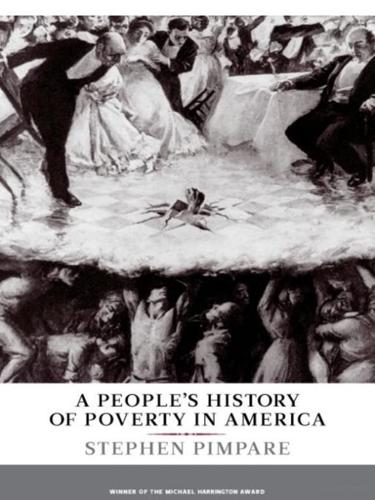
A People's History of Poverty in America
by
Stephen Pimpare
Published 11 Nov 2008
Plotnick, and Mark Evan Edwards, “Determinants of Initial Entry onto Welfare by Young Women,” Journal of Policy Analysis and Management 19, no. 4 (2000): 527–46. 16 Steven VanderStaay, Street Lives: An Oral History of Homeless Americans (Philadelphia: New Society Publishers, 1992), 170. 17 Joe Soss, Unwanted Claims: The Politics of Participation in the U.S. Welfare System (Ann Arbor: University of Michigan Press, 2002), 45. 18 Katherine S. Newman, No Shame in My Game: The Working Poor in the Inner City (New York: Vintage, 1999), 219. 19 Jane Jacobs, The Death and Life of Great American Cities (New York: Vintage, 1961). 20 Nicholas Lemann, “Bad Choices: A Welfare Soap Opera,” Washington Post, October 5–8, 1980 (four-part series). 21 Note also Mexican American field laborer Grace Palacio Arceneaux, interviewed in 1977, about growing up in California and the stinginess of relief: “Man, they never gave us anything, but they watched us like a hawk.
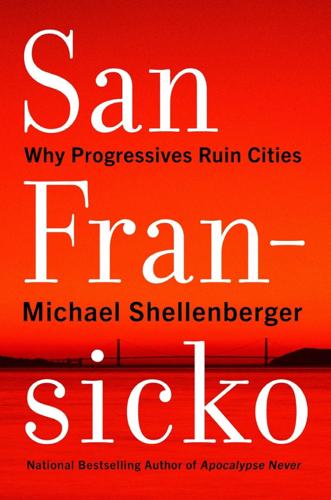
San Fransicko: Why Progressives Ruin Cities
by
Michael Shellenberger
Published 11 Oct 2021
Democrats until the late 1960s were pro-development, and had led efforts to demolish slums, build public housing, and revitalize the inner city. But starting in the late 1960s, Baby Boomers and the New Left turned against redevelopment. They were inspired by an influential 1961 book, The Death and Life of Great American Cities by Jane Jacobs, which blamed redevelopment, like that which had occurred in the Fillmore neighborhood of San Francisco, for destroying neighborhoods with freeways and high-rises, evicting low-income residents, and making them unlivable, as compared to highly walkable neighborhoods like Greenwich Village.
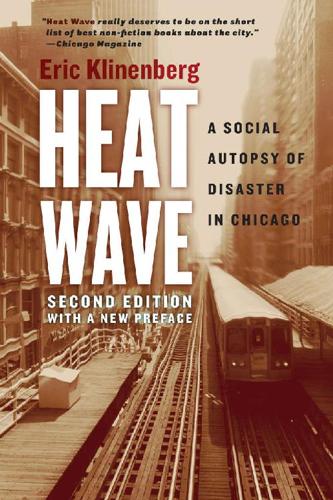
Heat Wave: A Social Autopsy of Disaster in Chicago
by
Eric Klinenberg
Published 11 Jul 2002
Vital Statistics Basic Research Series 1/3. Springfield. Intergovernmental Panel on Climate Change. 2001. Summary for policymakers: Climate change 2001: impacts, adaptation, and vulnerability. Geneva. Irvine, Martha. 2001. Hispanic influx shaping Chicago. Chicago Sun-Times, 11 March, p. 1. Jacobs, Jane. 1961. The death and life of great American cities. New York: Vintage. Janeway, Michael. 1999. Republic of denial: Press, politics, and public life. New Haven, Conn.: Yale University Press. Jargowsky, Paul. 1997. Poverty and place: Ghettos, barrios, and the American city. New York: Russell Sage Foundation. Jasper, James. 2000.
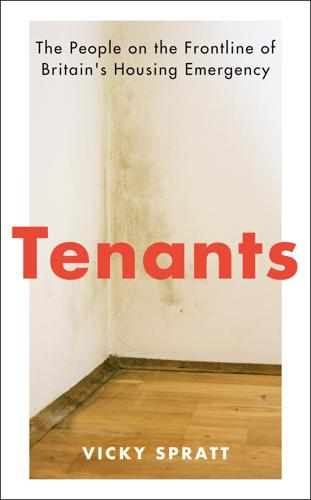
Tenants: The People on the Frontline of Britain's Housing Emergency
by
Vicky Spratt
Published 18 May 2022
Priscilla Parkhurst Ferguson (1996; New York: The New Press, 1998) Rutger Bregman, Utopia for Realists: And How We Can Get There (London: Bloomsbury, 2017) Emma Dabiri, What White People Can Do Next: From Allyship to Coalition (Penguin, 2021) Matthew Desmond, Evicted: Poverty and Profit in the American City (London: Penguin, 2016) Friedrich Engels, The Condition of the Working Class in England (1845; London: Penguin Classics, 2009) Derek Fraser, The Evolution of the British Welfare State (London: Macmillan, 1973) Ruth Glass, London: Aspects of Change (London: MacGibbon & Kee, 1964) Lynsey Hanley, Estates: An Intimate History (London: Granta, 2007; revised edition, 2012) bell hooks, ‘Homeplace: A Site of Resistance’ in Undoing Place?: A Geographical Reader, edited by Linda McDowell (London: Routledge, 1997) bell hooks, All About Love: New Visions (Love Song to the Nation #1) (2000; New York: William Morrow, 2016) Amelia Horgan, Lost in Work: Escaping Capitalism (London: Pluto Press, 2021) Jane Jacobs, The Death and Life of Great American Cities (1961; London: Bodley Head, 2020) Colin Jones and Alan Murie, The Right to Buy: Analysis and Evaluation of a Housing Policy (Real Estate Issues Book 9) (Oxford: Wiley-Blackwell, 2006) Leslie Kern, Feminist City: Claiming Space in a Man-made World (London: Verso, 2020) Loretta Lees, Tom Slater and Elvin Wyly, eds, The Gentrification Reader (London: Routledge, 2010) Anna Minton, Big Capital: Who is London For?
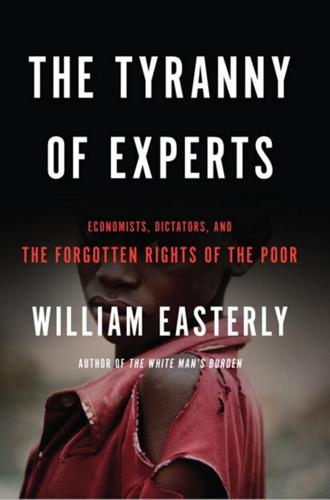
The Tyranny of Experts: Economists, Dictators, and the Forgotten Rights of the Poor
by
William Easterly
Published 4 Mar 2014
“Talk by Robert Moses at The Baruch Houses Dedication, Wednesday Afternoon, August 19, 1953,” Robert Moses Papers, New York Public Library Manuscript and Archives Division, New York. 31. http://www.metmuseum.org/toah/hd/abex/hd_abex.htm, accessed August 31, 2013. 32. Jessamyn Fiore, 112 Greene Street: The Early Years (1970–1974) (New York: Radius Books/David Zwirner, 2012), 10. 33. Joyce Silver, interview by Laura Freschi, October 19, 2012, New York. 34. Jane Jacobs, The Death and Life of Great American Cities (New York: Random House, 2002), 13, 35. 35. Joe Catuccio, interview by Laura Freschi, June 29, 2013, New York. 36. “The Project of Living Artists,” http://www.newyorkartworld.com/gallery/project-livingartists.html, accessed August 31, 2013. 37. François Quesnay, Despotism in China: A Translation of François Quesnay’s Le Despotisme de la Chine (Paris 1767), in Lewis A.
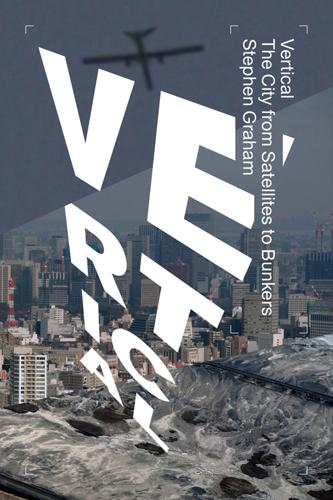
Vertical: The City From Satellites to Bunkers
by
Stephen Graham
Published 8 Nov 2016
See Jamie Peck, ‘Economic Rationality Meets Celebrity Urbanology: Exploring Edward Glaeser’s City’, International Journal of Urban and Regional Research, 2016 (forthcoming). 6Paul Goldberger, ‘Too Rich, Too Thin, Too Tall, Vanity Fair, May 2014. 7As well as blocking out light, new towers often create wind systems at ground level that can be uncomfortable and even dangerous to those on the street. 8Lloyd Alter, ‘It’s Time to Dump the Tired Argument That Density and Height Are Green and Sustainable’, Treehugger, 3 January 2014, available at treehugger.com. 9Ibid. 10Samuel Zipp ‘The Roots and Routes of Urban Renewal’, Journal of Urban History 39:3, May 2013, p. 372. 11Walter Gropius, The New Architecture and the Bauhaus, Cambridge, MA: MIT Press, 1965, p. 146. 12Paul Christoph Haacke, ‘The Vertical Turn: Topographies of Metropolitan Modernism’, PhD thesis, University of California, Berkeley, 2011, available at escholarship.org/uc/item/1857736f. 13Fosco Lucarelli and Mariabruna Fabrizi, ‘The Trellick Tower: The Fall and Rise of a Modern Monument’, San Rocco Magazine 5, Fall 2012. 14Sigfried Giedeon, Building in France, Building in Iron, Building in Ferroconcrete, Santa Monica, CA: Getty Center for the History of Art and the Humanities, 1995 [1928]. 15Le Corbusier, The City of Tomorrow and Its Planning, New York: Dover, 1987 [1927], p. 280. 16This term comes from the US Citizens Housing Council, 1940. Cited in Zipp, ‘Roots and Routes’, p. 274. 17Cited in Zipp, ‘Roots and Routes’, p. 376. 18Jane Jacobs, The Death and Life of Great American Cities, New York: Random House, 1961, p. 46. 19Cited in Jacobs, Cairns and Strebel, ‘A Tall Storey’, p. 614. 20The poem, by Ken Rogers, comes from his tribute to people who were rehoused and often moved as part of the slum clearances in Liverpool in the 1960s. See Ken Rogers, Lost Tribe: The People’s Memories: 2.
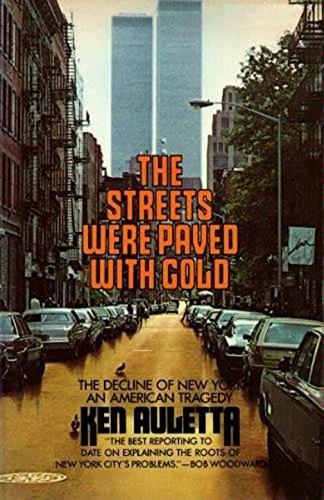
The Streets Were Paved With Gold
by
Ken Auletta
Published 14 Jul 1980
Of the city’s 340 health districts, almost one-half have less than one physician for every 1,000 residents—one-third the national average and in stark contrast to the average of 42 per 1,000 residents on the Upper East Side of Manhattan. A “successful city neighborhood,” Jane Jacobs wrote in The Death and Life of Great American Cities, requires “eyes upon the street, eyes belonging to those we might call the natural proprietors of the street.” Neighborly eyes ensured safety, a feeling of security, of community. In growing numbers of city neighborhoods, people no longer sit on stoops, no longer venture out at night.

Whole Earth: The Many Lives of Stewart Brand
by
John Markoff
Published 22 Mar 2022
(How Buildings Learn would also include several uniquely Brandian touches, including the author’s address, on the premise that “publishers are ill-equipped to forward mail and authors need contact from readers to make corrections for later printings and to make things happen in the real world.”) After seven years of research and writing, How Buildings Learn: What Happens After They’re Built was published in 1994. As Christopher Alexander’s A Pattern Language and Jane Jacobs’s The Death and Life of Great American Cities had for their respective authors, How Buildings Learn established Brand as an independent and original thinker on design, urbanism, and ingenuity. Of all five of his books, this would be the one in which he would take the most pride. That said, when it was published, the book made much less of a splash than The Media Lab.

Open: The Story of Human Progress
by
Johan Norberg
Published 14 Sep 2020
Wilson, ‘Why air travel makes deadly disease pandemics less likely’, New Scientist, 2018, https://www.newscientist.com/article/2184266-why-airtravel-makes-deadly-diseasepandemics-less-likely/(accessed 9 March 2020). 6 M. Sikora et al., ‘Ancient genomes show social and reproductive behaviour of early upper Paleolithic foragers’, Science, 358(6363), 2017. 7 J. Jacobs, The Death and Life of Great American Cities. New York, Vintage Books, 1961, p. 30. 8 Watson, 2006, pp. 73 and 96. 9 Ridley, 2010, p. 6. 10 M. Nielsen, Reinventing Discovery: The New Era of Networked Science. Princeton, Princeton University Press, 2012, pp. 1534ff. 11 J. L. Simon, The Ultimate Resource 2. Princeton, Princeton Univerity Press, 1998, p. 7. 12 J.
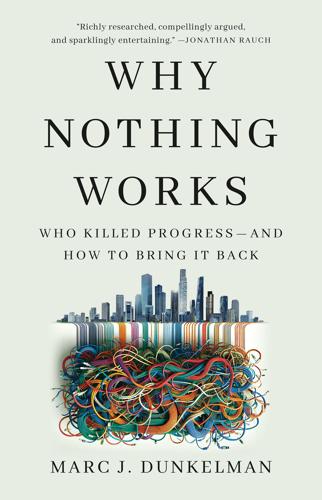
Why Nothing Works: Who Killed Progress--And How to Bring It Back
by
Marc J Dunkelman
Published 17 Feb 2025
City fathers who had never particularly warmed to the southern Blacks arriving through the Great Migration saw “slum clearance” as an easy way out.56 As James Baldwin once put it, “urban renewal means Negro removal.”57 In 1964 alone, two-thirds of those “removed” by slum clearance were minorities.58 But poorer whites were victimized as well, and that was often because, as Jane Jacobs would eventually point out in The Death and Life of Great American Cities, the Establishment discounted the importance of social connection.59 The slums may have been ragged, but many were suffused with community ties. And the sputtering failures of an indelibly progressive strategy to fix cities eventually forced reformers, by the mid-1960s, to question their prior assumptions.
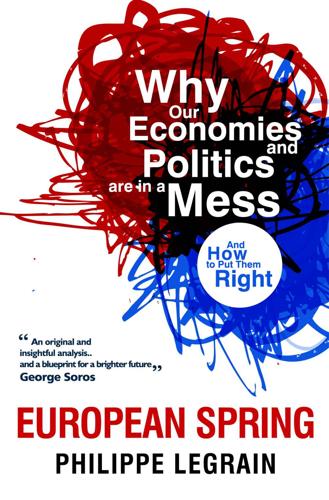
European Spring: Why Our Economies and Politics Are in a Mess - and How to Put Them Right
by
Philippe Legrain
Published 22 Apr 2014
title=File:Gross_domestic_expenditure_on_R%26D,_2000-2010_%28%25_share_of_GDP%29.jpg 595 http://www.oecd.org/site/innovationstrategy/45183382.pdf 596 http://www.oecd.org/site/innovationstrategy/45184357.pdf 597 Nick Bloom, Mirko Draca and John Van Reenen, “Trade Induced Technical Change: The Impact of Chinese Imports on Innovation and Productivity”, CEPR Discussion Paper No. 1000, 2011 http://www.voxeu.org/article/who-s-afraid-big-bad-dragon-how-chinese-trade-boosts-european-innovation 598 Jane Jacobs, The Death and Life of Great American Cities, Random House: 1961 599 Edward Glaeser, Triumph of the City: How Our Greatest Invention Makes Us Richer, Smarter, Greener, Healthier and Happier, Macmillan: 2011 600 http://www.ft.com/cms/s/0/d6074404-48f5-11e0-af8c-00144feab49a.html 601 http://www.economist.com/news/business/21581695-city-leaders-are-increasingly-adopting-business-methods-and-promoting-business-mayors-and-mammon 602 Alfred Marshall, Principles of Economics, 1890 603 Pierre Azoulay, Joshua Graff Zivin and Bhaven Sampat, "The diffusion of scientific knowledge across time and space: Evidence from professional transitions for the superstars of medicine", NBER Working Paper #16683, January 2011 604 Benjamin Jones, "The burden of knowledge and the ‘death of the renaissance man’: Is innovation getting harder?"
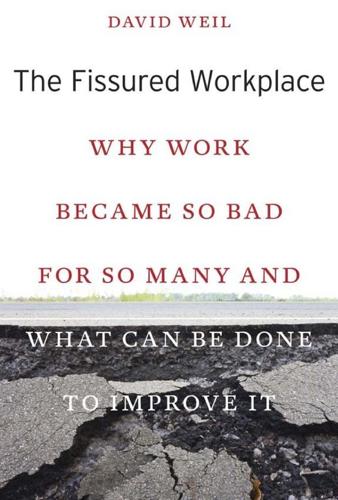
The Fissured Workplace
by
David Weil
Published 17 Feb 2014
International Labour Office. 2006. Strategies and Practices for Labour Inspection. Governing Body, 297th Session, GB.297/ESP/3. Geneva: International Labour Office. Investment Company Institute. 2012. 2012 Investment Company Fact Book. 52nd ed. www.icifactbook.org. Jacobs, Jane. 1961. The Death and Life of Great American Cities. New York: Vintage. Jacoby, Neil. 1969. “The Conglomerate Corporation.” The Center Magazine 2, 1–20. Jacoby, Sandy. 1999. “Are Career Jobs Headed for Extinction?” California Management Review 42, no. 1: 123–145. James, P., R. Johnstone, M. Quinlan, and D. Walters. 2007. “Regulating Supply Chains to Improve Health and Safety.”

Evil Geniuses: The Unmaking of America: A Recent History
by
Kurt Andersen
Published 14 Sep 2020
But even as that demolition of old buildings and neighborhoods was going full speed, local activists (in New York City most of all) and a few enlightened owners (in Omaha, for instance) started to beat it back—another example of how American citizens have placed essential checks and balances on excessive and misguided power. The Death and Life of Great American Cities, by the Manhattan journalist-turned-activist Jane Jacobs, became the manifesto of a successful and powerful new movement in 1961; by the end of the decade, historic preservation was fully institutionalized, and in the 1970s saving and renovating nice old buildings and neighborhoods was becoming the default.*3 At the same moment, architecture and urban planning rediscovered the amusements and lessons of history.
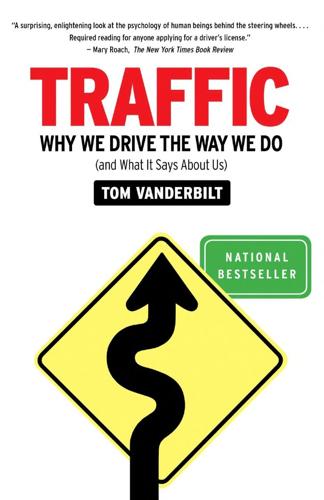
Traffic: Why We Drive the Way We Do (And What It Says About Us)
by
Tom Vanderbilt
Published 28 Jul 2008
In a study of what they called “disappearing traffic,” a team of British researchers looked at a broad list of projects in England and elsewhere where roads had been taken away either for construction or by design. Predictably, traffic flows dropped at the affected area. Most of the time, though, the increase in traffic on alternative routes was nowhere near the traffic “lost” on the affected roads. In the 1960s, as Jane Jacobs described in her classic book The Death and Life of Great American Cities, a small group of New Yorkers, including Jacobs herself, began a campaign to close the street cutting through Washington Square Park, in Greenwich Village. Parks were not great places for cars, they suggested. They also suggested not widening the nearby streets to accommodate the newly rerouted flow.

The Unwinding: An Inner History of the New America
by
George Packer
Published 4 Mar 2014
When he was covering city hall at The Palm Beach Post, he’d gotten deeply interested in urban planning—for a while he even thought about switching careers, until he realized that city planners had even less clout than reporters. But his bookshelves filled up with titles like A Field Guide to Sprawl, The History of the Lawn, Suburban Nation, and the pair that were his bibles: The Power Broker and The Death and Life of Great American Cities. Van Sickler became a Jane Jacobs disciple. She gave a vocabulary to the desire he had felt growing up in Cleveland Heights with no one around on those excruciating summer afternoons: short blocks, pedestrian permeability, mixed uses, safety in eyes on the street, density. Life was richest and most creative where people of different backgrounds could meet face-to-face and exchange ideas.

To Save Everything, Click Here: The Folly of Technological Solutionism
by
Evgeny Morozov
Published 15 Nov 2013
Blondel, Public Administration in France (London: Routledge and Kegan Paul, 1964). 138 Jane Jacobs’ attack on unimaginative urban planning, Isaiah Berlin’s attack on “procrusteanism,” Hayek’s attack on central planning, Popper’s attack on historicism, Michael Oakeshott’s attack on rationalism: see Jane Jacobs, The Death and Life of Great American Cities (New York: Vintage, 1992); on Berlin’s “anti-procusteanism” see Jonathan Allen, “Isaiah Berlin’s Anti-Procrustean Liberalism: Ideas, Circumstances, and the Protean Individual,” paper presented at the annual meeting of the American Political Science Association (August 28–31, 2003, Philadelphia, PA).

Aerotropolis
by
John D. Kasarda
and
Greg Lindsay
Published 2 Jan 2009
Location and Space-Economy: A General Theory Relating to Industrial Location, Market Areas, Land Use, Trade, and Urban Structure. New York: Wiley, 1956. Issenberg, Sasha. The Sushi Economy: Globalization and the Making of a Modern Delicacy. New York: Gotham Books, 2007. Jacobs, Jane. Cities and the Wealth of Nations. New York: Vintage Books, 1985. ———. The Death and Life of Great American Cities. New York: Modern Library, 1993. ———. The Economy of Cities. New York: Random House, 1969. Jevons, William Stanley. The Coal Question: An Enquiry Concerning the Progress of the Nation, and the Probable Exhaustion of Our Coal-Mines. 2nd ed. London: Macmillan, 1866. Kasarda, John D.
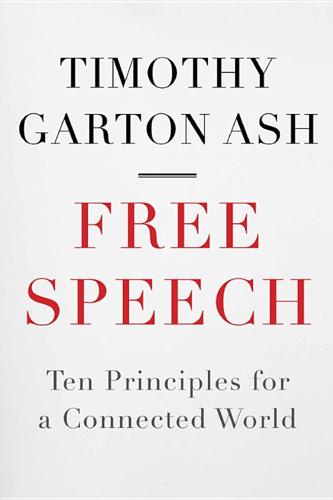
Free Speech: Ten Principles for a Connected World
by
Timothy Garton Ash
Published 23 May 2016
Ikenberry, John. 2011: Liberal Leviathan: The Origins, Crisis, and Transformation of the American World Order. Princeton: Princeton University Press. Index. 2011: Index on Censorship. Vol. 40, no 2. Los Angeles: Sage. Jack, Malcolm, ed. 2011: Erskine May’s Treatise on the Law, Privileges, Proceedings and Usage of Parliament. 24th ed. London: LexisNexis. Jacobs, Jane. 1993: The Death and Life of Great American Cities. New York: Modern Library. Jarvis, Jeff. 2011: Public Parts: How Sharing in the Digital Age Improves the Way We Work and Live. New York: Simon & Schuster. Jordan, Scott. 2010: ‘The Application of Net Neutrality to Wireless Networks Based on Network Architecture’. Policy & Internet, vol. 2, no. 2, article 6. doi: 10.2202/1944-2866.1052.
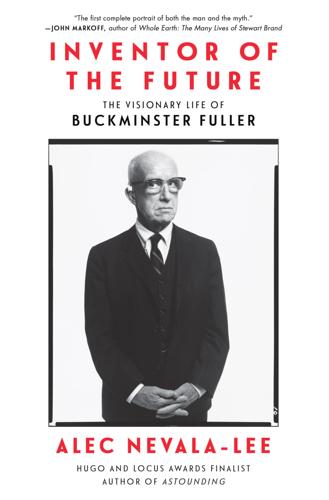
Inventor of the Future: The Visionary Life of Buckminster Fuller
by
Alec Nevala-Lee
Published 1 Aug 2022
Although Jordan was disappointed by its presentation, she remained close to Fuller, whose support allowed her to pursue her studies of community planning “for participation by Harlem residents in the birth of their new reality.” In an era when the journalist Jane Jacobs was exposing the failures of urban projects in The Death and Life of Great American Cities, Fuller continued to think in terms of megastructures, which kept him in the public eye at the expense of his vision of decentralization. By contrast, many of his other views were strikingly progressive. Fuller said that America was already “the most socialized of all countries in the world,” although it concealed this by underwriting corporations rather than individuals.
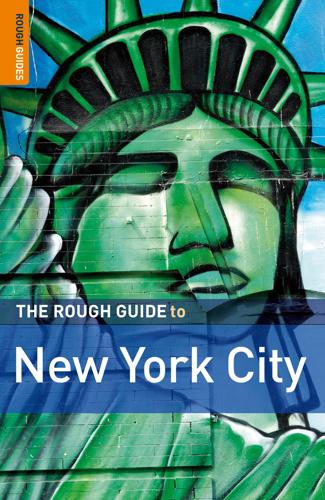
The Rough Guide to New York City
by
Martin Dunford
Published 2 Jan 2009
How could a railroad palace, modeled after the Baths of Caracalla in Rome, stand for only fifty years before being destroyed? The pictures alone warrant the price. Horst Hamann New York Vertical. This beautiful book pays homage to the New York skyscraper, and is filled with dazzling black-and-white vertical shots of Manhattan, accompanied by witty quotes from famous and obscure folk. Jane Jacobs The Death and Life of Great American Cities. Landmark 1961 screed authored by Robert Moses’ nemesis, and railing against urban over-planning. David McCullough Great Bridge: The Epic Story of the Building of the Brooklyn Bridge. The story of the father-and-son Roebling team who fought the laws of gravity, sharptoothed competitors, and corrupt politicians to build a bridge that has withstood the test of time and become one of NYC’s most noted landmarks.
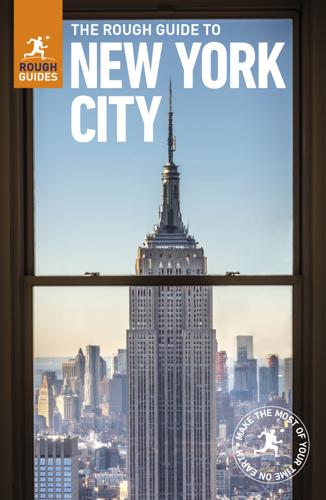
The Rough Guide to New York City
by
Rough Guides
Published 21 May 2018
The pictures alone warrant the price. Horst Hamann New York Vertical. This beautiful book pays homage to the New York skyscraper, and is filled with dazzling black-and-white vertical shots of Manhattan, accompanied by witty quotes from famous and obscure folk. Jane Jacobs The Death and Life of Great American Cities. Landmark 1961 screed authored by Robert Moses’ nemesis, and railing against urban over-planning. David McCullough Great Bridge: The Epic Story of the Building of the Brooklyn Bridge. The story of the father-and-son Roebling team who fought the laws of gravity, sharp-toothed competitors and corrupt politicians to build a bridge that has withstood the test of time and become one of NYC’s most noted landmarks.

Engineering Security
by
Peter Gutmann
[108] “The Book of Risk”, Dan Borge, John Wiley and Sons, 2001. [109] “To Forgive Design: Understanding Failure”, Henry Petroski, Harvard University Press, 2012. [110] “The Great Bridge”, David McCullogh, Simon & Schuster, 1972. [111] “Crime Prevention Through Environmental Design”, C.Ray Jeffery, Sage Publications, 1971. [112] “Defensible Space: Crime Prevention Through Urban Design”, Oscar Newman, Macmillan, 1973. [113] “Design Against Crime: Beyond Defensible Space”, Barry Poyner, Butterworth, 1983. [114] “Crime Prevention Through Environmental Design”, Timothy Crowe, Butterworth-Heinemann, 1991. [115] “The Death and Life of Great American Cities”, Jane Jacobs, Random House, 1961. [116] “Creating Safe and Secure Environments for Schools and Colleges”, Randy Atlas and Richard Schneider, in “21st Century Security and CPTED”, CRC Press, 2008, p.279. [117] “Exchange 2003 Server Service Pack 2 (SP2) Anti-Spam Framework”, Alexander Nikolayev, 18 July 2005, http://blogs.technet.com/b/exchange/archive/2005/07/18/407838.aspx. [118] “Understanding Spam Confidence Level Threshold”, Microsoft Corporation, 10 September 2010, http://technet.microsoft.com/en-us/library/aa995744.aspx. [119] “Going Mini: Extreme Lightweight Spam Filters”, D.Sculley and Gordon Cormack, Proceedings of the 6th Conference on Email and Anti-Spam (CEAS’09), July 2009, http://ceas.cc/2009/papers/ceas2009-paper47.pdf. [120] “The Exploding Metropolis”, William Whyte, Doubleday/Anchor, 1958. [121] “Phishing with Rachna Dhamija”, Federico Biancuzzi, 19 June 2006, http://www.securityfocus.com/columnists/407. [122] “Malware Mythbusters”, Alex Kirk, presentation at Ruxcon 2011, November 2011. [123] “Malicious and Spam Posts in Online Social Networks”, Saeed Abu-Nimeh, Thomas Chen and Omar Alzubi, IEEE Computer, Vol.44, No.9 (September 2011), p.23. [124] “Metrics for Measuring ISP Badness: The Case of Spam”, Benjamin Johnson, John Chuang, Jens Grossklags and Nicolas Christin, Proceedings of the 16th International Conference on Financial Cryptography and Data Security (FC’12), Springer-Verlag LNCS No.7397, February 2012, p.89. [125] “A RESTful Web Service for Internet Name and Address Directory Services”, Andrew Newton, Dave Piscitello, Benedetto Fiorelli and Steve Sheng, ;login, Vol.36, No.5 (October 2011), p.23.

The power broker : Robert Moses and the fall of New York
by
Caro, Robert A
Published 14 Apr 1975
Hoover, Edgar M., and Raymond Vernon: Anatomy of a Metropolis, Cambridge, Mass.: Harvard University Press; 1959. Ickes, Harold L.: The Secret Diary of Harold L. Ickes. Vol. I: The First Thousand Days, 1933-1936. New York: Simon & Schuster; 1953. Isaacs, Edith: Love Affair with a City. New York: Random House; 1967. Jacobs, Jane: The Death and Life of Great American Cities. New York: Random House; 1961. Jenkins, Shirley: Comparative Recreation Needs and Services in New York Neighborhoods. New York: The Research Department, Community Council of Greater New York; 1963. Jones, John F.: The Jones Family, Descendants of Major Thomas Jones, 1665-1726, and Allied Families.